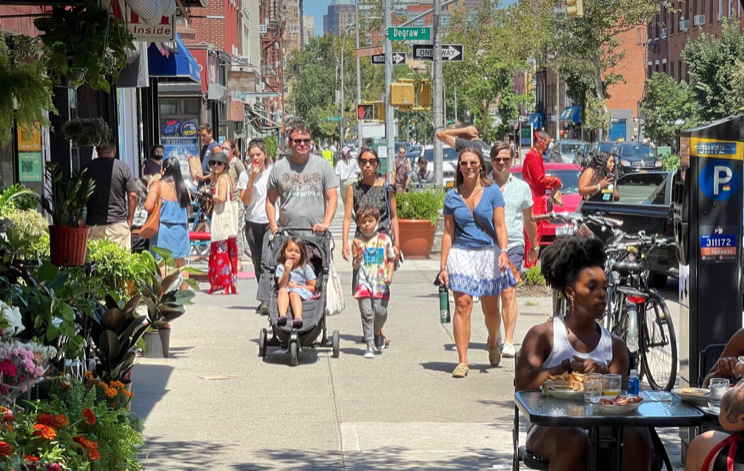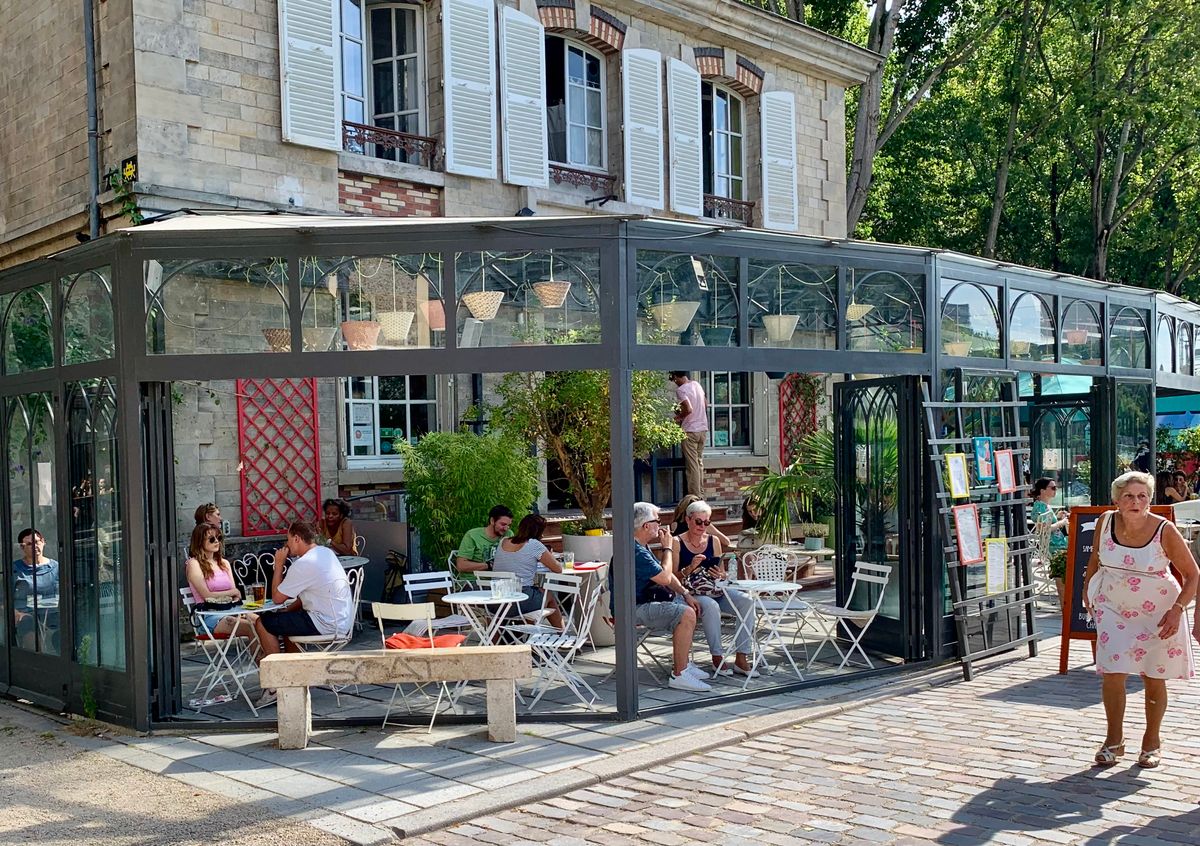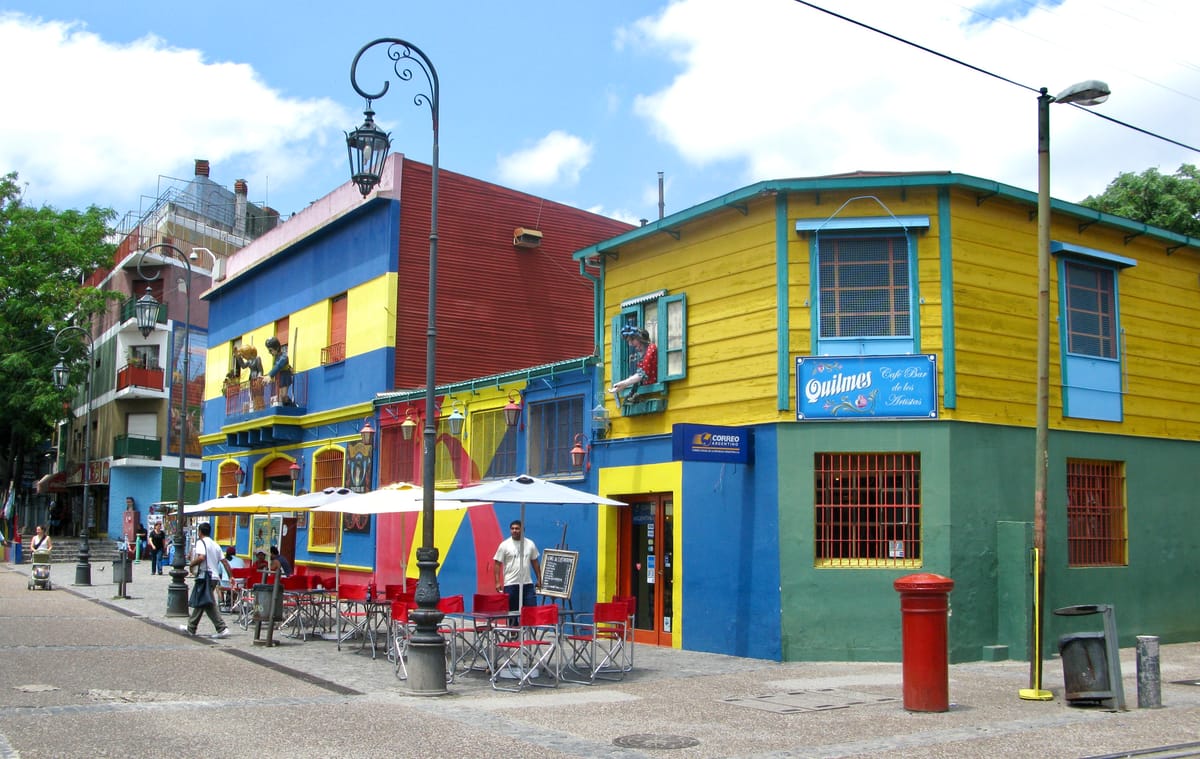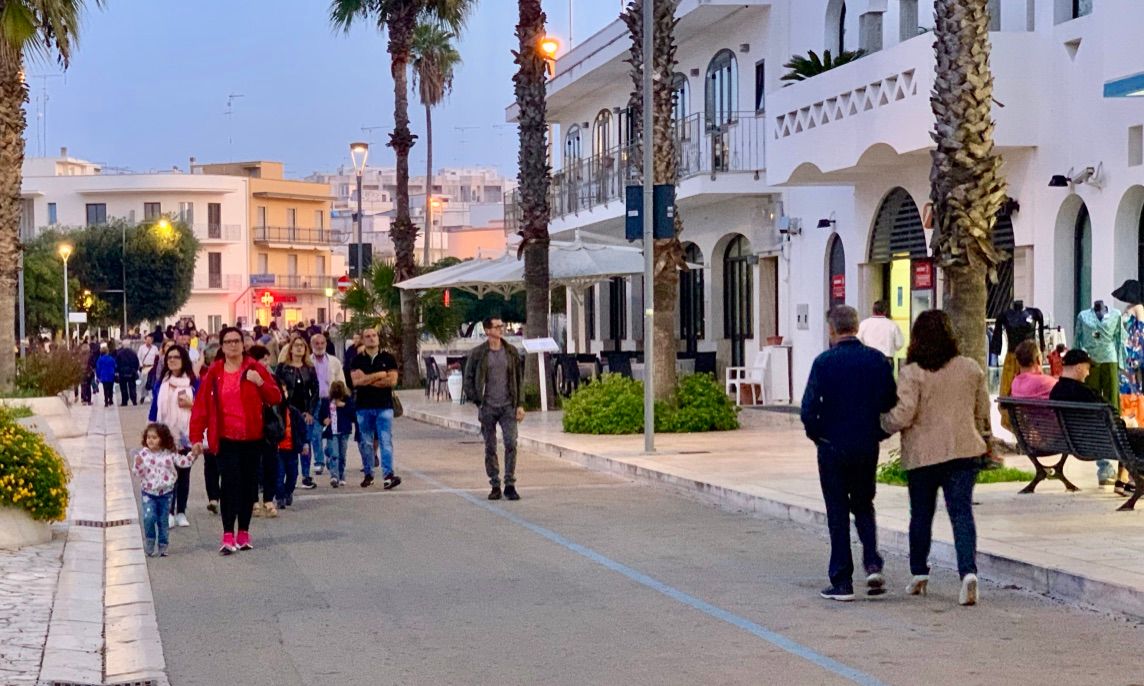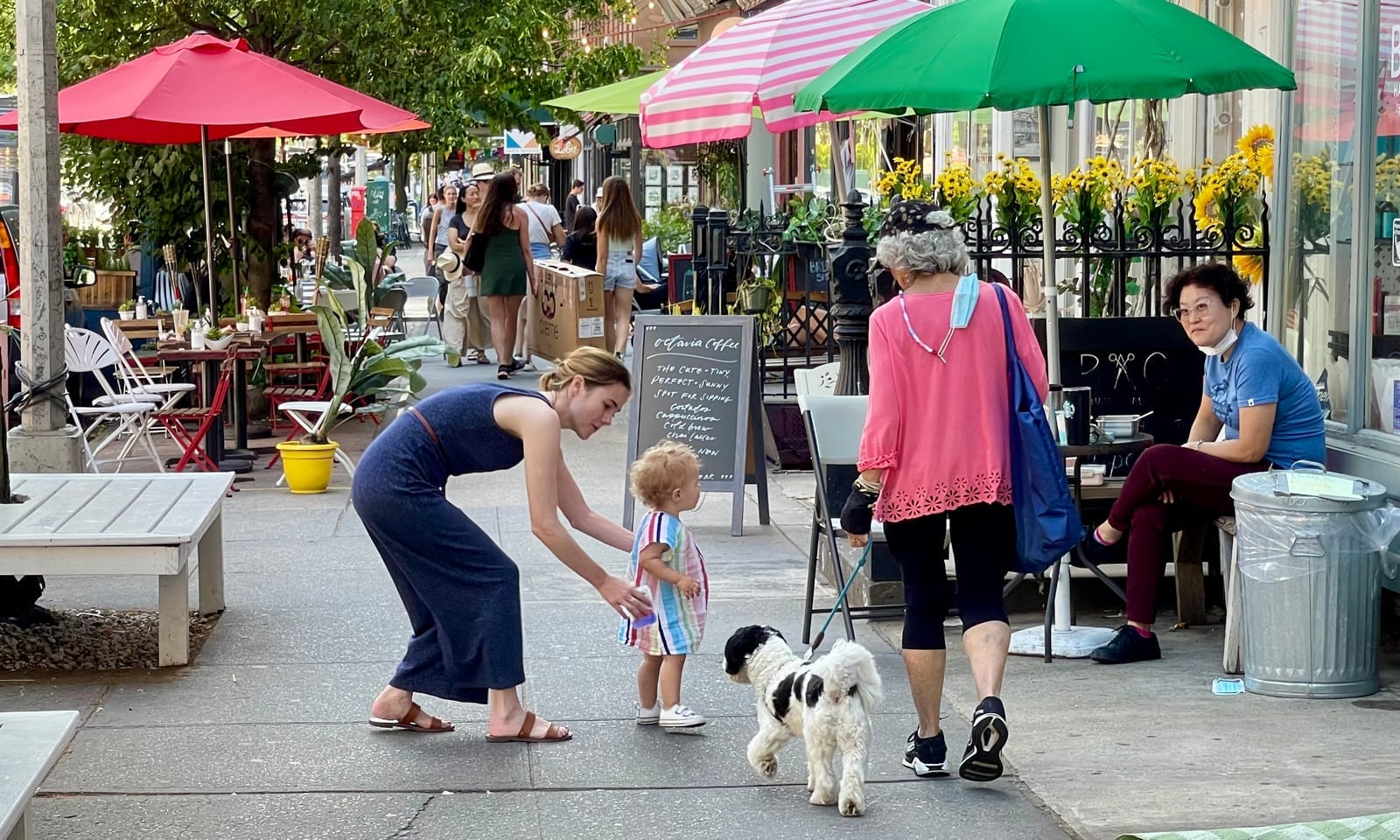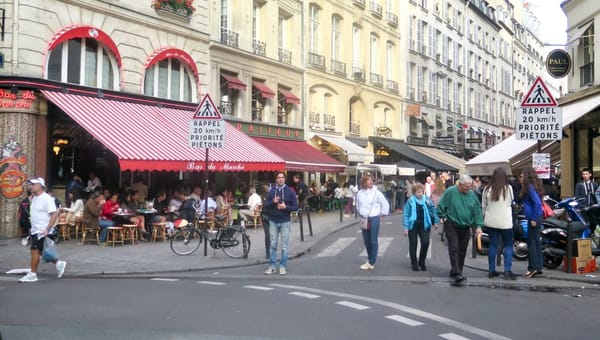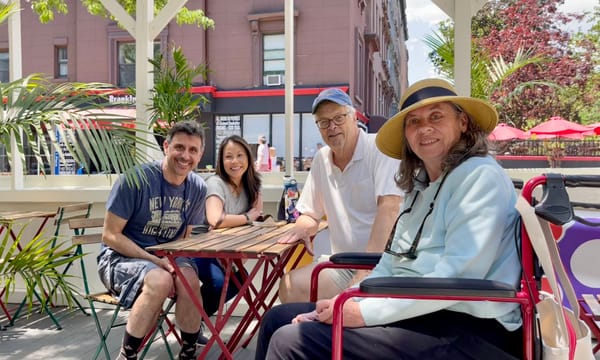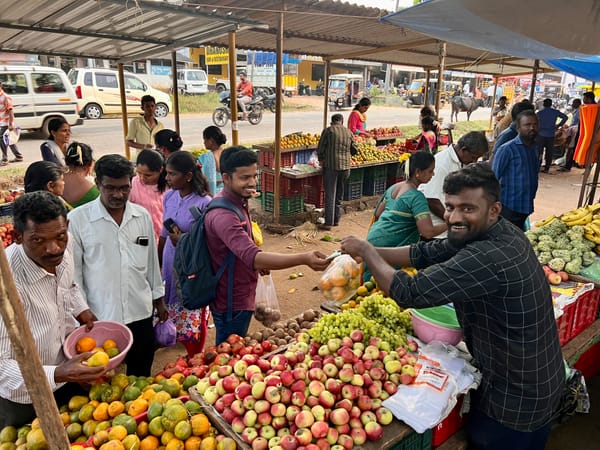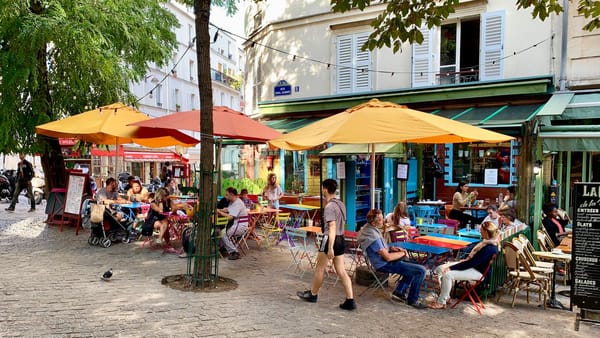Double loading sidewalks and creating intersections where social life thrives is a way out of stagnation for cities
The key to revitalizing cities is starting with the sidewalks – our most expansive public space. Here are a few reasons why:
- Foot traffic is the lifeblood of every community, which makes sidewalks a community's arteries. Historically, cities built before the car had narrow streets for mainly pedestrian use that defined communities and neighborhoods. These places were where the heaviest foot traffic was and thus where most of the commercial and social activity took place. These are the places that still thrive today.
- Sidewalk widths make all the difference. Street widths can and should be narrowed to allow space for the kind of wide and vibrant sidewalks where social life is able to thrive. In an era where the word of traffic engineers is law, data is used to optimize street design for traffic throughput at the expense of sidewalk life. Sidewalks become minuscule in comparison to the enlarged number and size of car lanes. This is counter to the purpose of streets in cities which is to support social and commercial activity.
- Thinking intentionally about the impact of streets is essential, including how their width, number of lanes, and parking affects the experience of spending time there. We need to realize that streets don't exist in a vacuum but in a complex urban fabric. They therefore need to be well-integrated with their surroundings, including businesses, public spaces, residences, etc.
- Communities have been destroyed by uniform storefront design standards. Everywhere, we see generic storefronts that add no vitality or character to place. They serves only traffic because the more basic and bland the buildings, the less active the sidewalk area, and the easier for cars to zip through. This happens since there are less "obstacles/friction" creating distractions for drivers or obstacles for cars.
- Turning buildings "inside out" is important for creating an interesting public realm. If sidewalks aren't interesting and engaging, people will not use them. To make sidewalks engaging, everything of interest in buildings should spill onto the sidewalk and connect business activity with public life, including seating, displays of goods, etc.
- Whoever owns the intersection defines the community. It's important to focus on what happens at the corners – the nodes of the street network. If they are dominated by cars, intersections and the street network belong to the car industry. If they are full of shops, cafes, outdoor seating, and sidewalk life, they belong to the community.
Double Loading
One of the best ways to encapsulate all of these insights and revitalize sidewalks is through what we call "double loading"
Enclosure
People love a sense of enclosure. It feels cozy, comfortable, safe, and relaxed. Sidewalks that spill directly onto the street without any barrier between people and cars create the opposite experience. With the sounds and smells of traffic just feet away, such a sidewalk design leads to tension, discomfort, and stress. This is why most of our streets are not only unpleasant, but also anxiety-provoking to walk along. They are mainly designed for cars and the people safely within them, not for the people outside walking along the periphery of the street.
Like in many cities, most parts of NYC are dominated by wide streets and intersections that feel removed from city life – dead, dull, and hostile. We at Social Life Project call these overly wide intersections "killer intersections" because they kill all sense of place and social and commercial activity around themselves, not to mention how dangerous they are for pedestrians. Killer intersections are exactly what we must avoid in order to create connection and vibrancy in our cities. The way to do so is through creating a pleasant, comfortable, and safe sense of enclosure through double-loading.
"Double-Loaded" Streets
Streets where people enjoy walking offer a sense of enclosure. This can be either because car lanes are narrow or because there are barriers between pedestrians and cars, creating a sense of separation between the people walking and traffic. This is the essence of double loading.
Double loading a sidewalk is when you put amenities or features on both sides of the pedestrian walkway, such as outdoor seating, street trees, kiosks, and dining sheds. This makes the walkway feel like a kind of "safe zone" drawing people in large numbers to gather and enjoy the stretches where everyone feels safe. This leads to a much more enjoyable, safer, and more relaxed experience than walking right alongside traffic. It turns the sidewalk from an afterthought of the street's design into the main attraction.
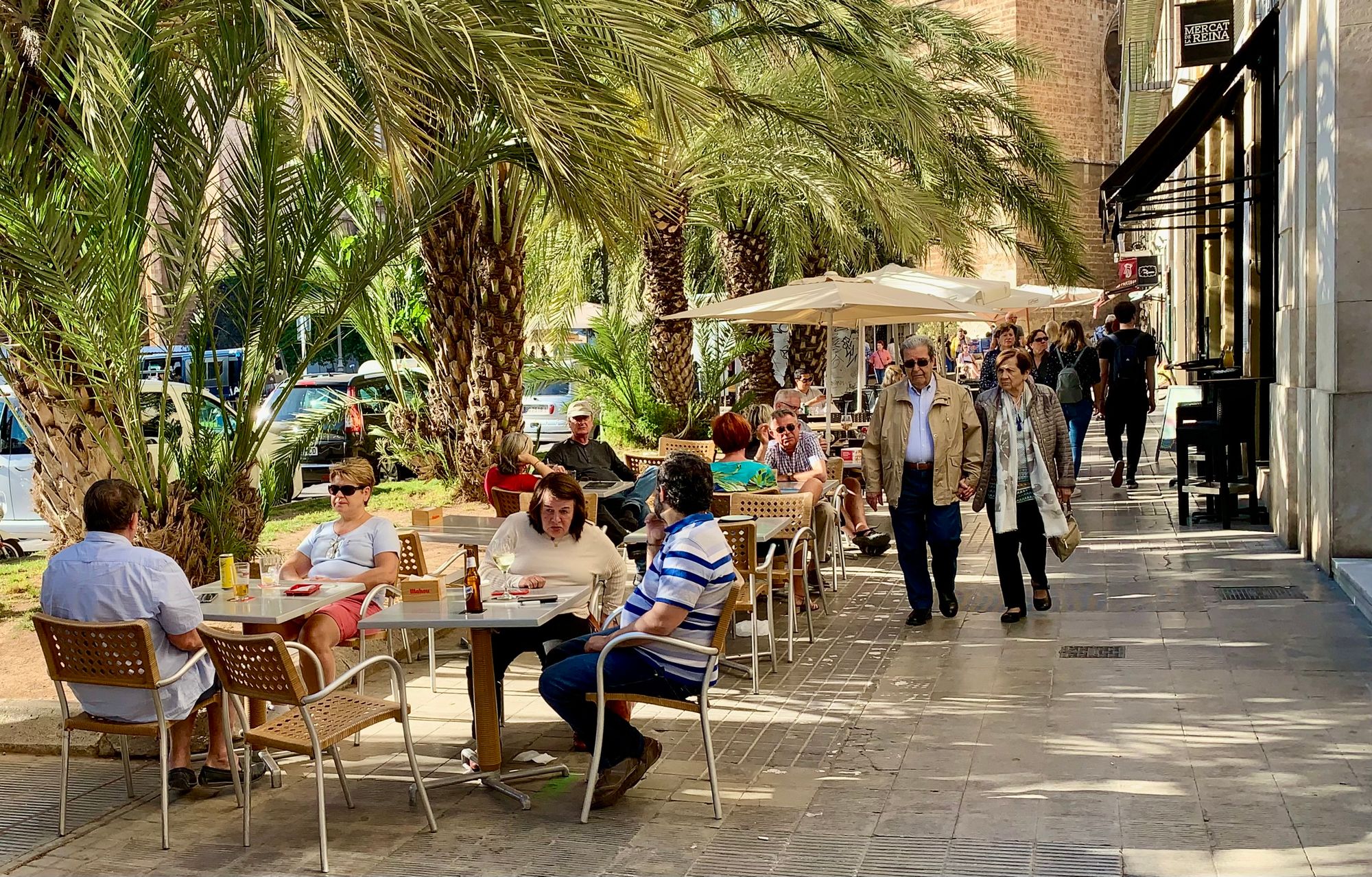
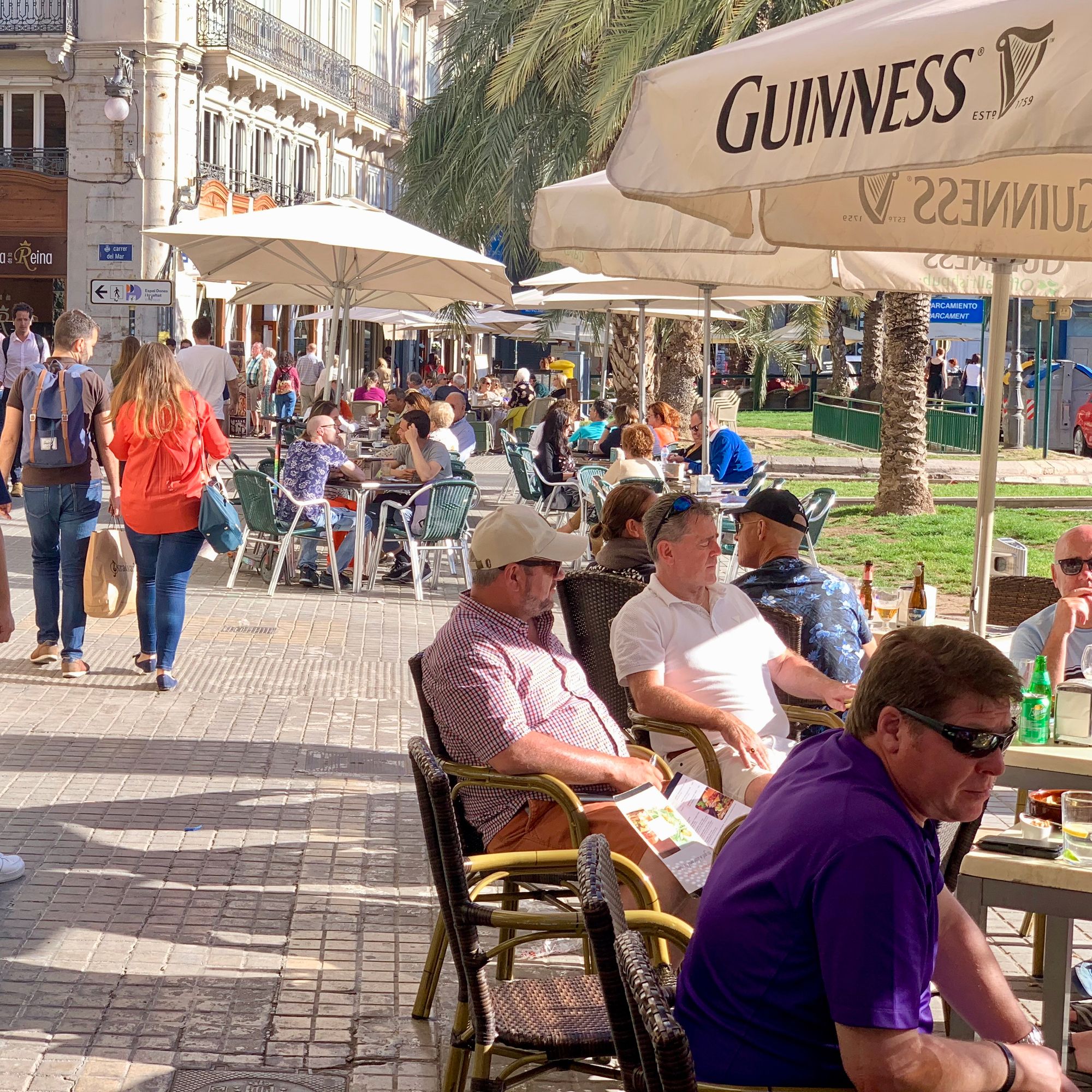
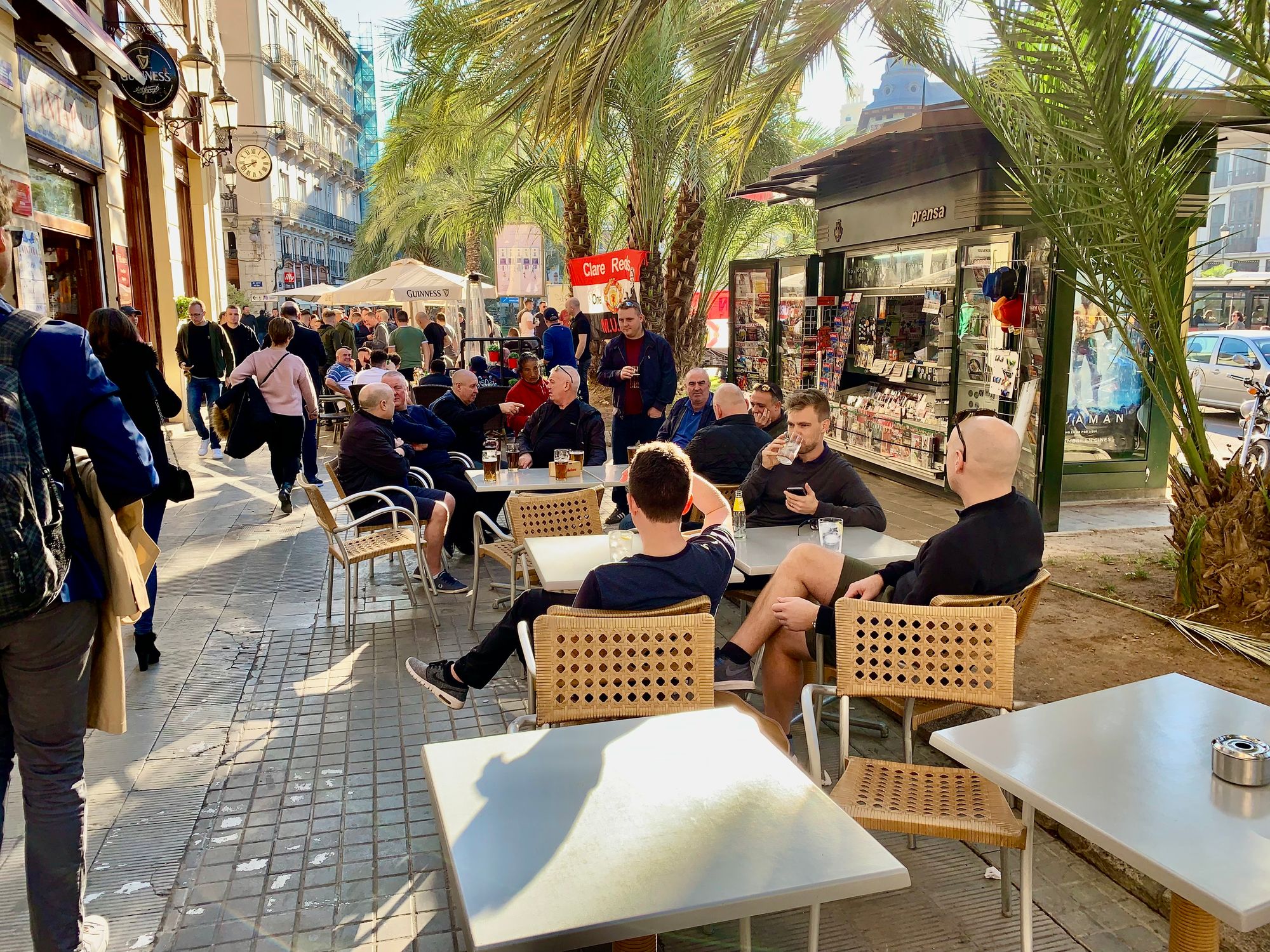
Double loading offers many great outcomes that make the urban experience richer and more enjoyable. For one, it makes it so that children can roam free on sidewalks. Because when there is a physical separation between the walkway and the dangers of the street, parents feel more comfortable letting their kids run and play. This opens the city up to them and allows them much-needed independence.
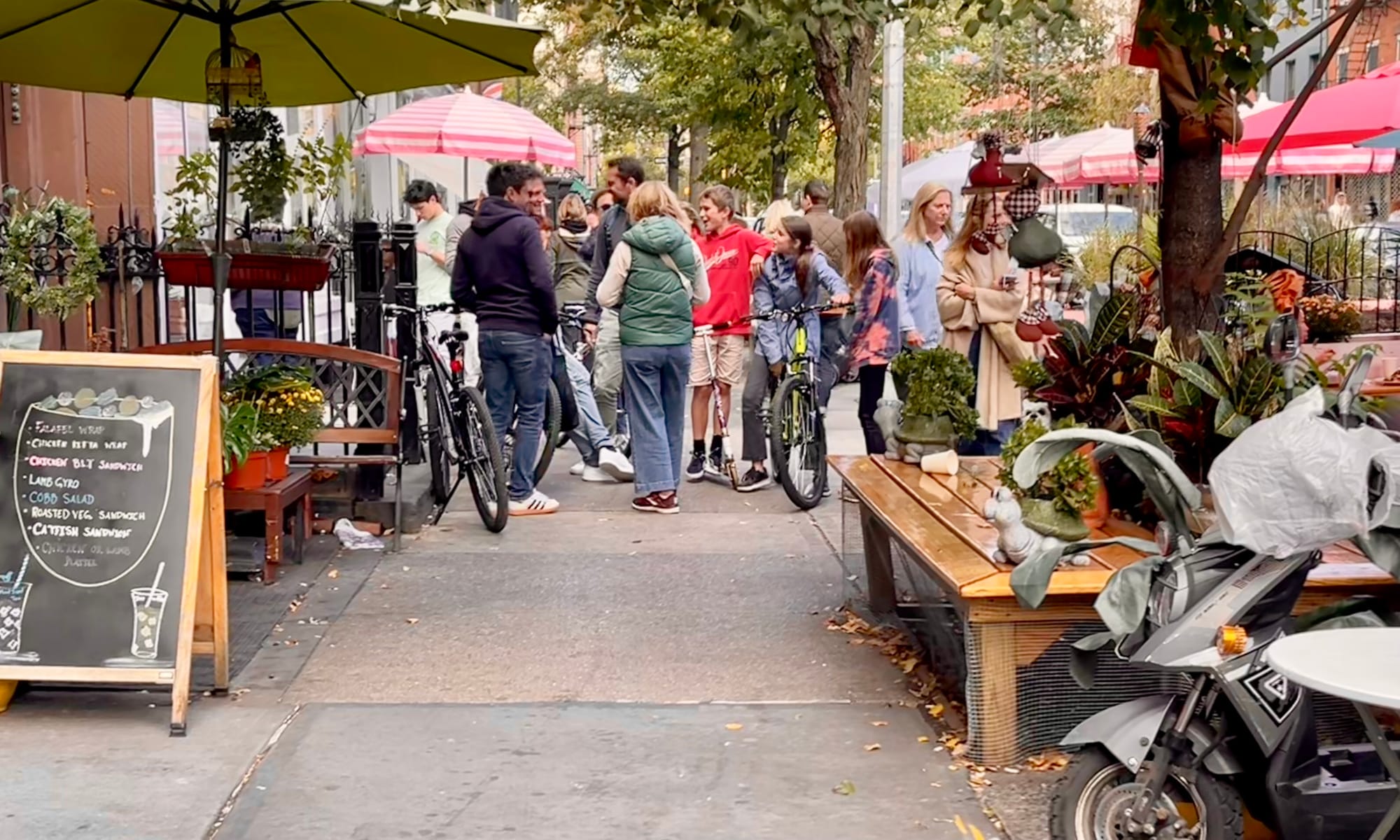
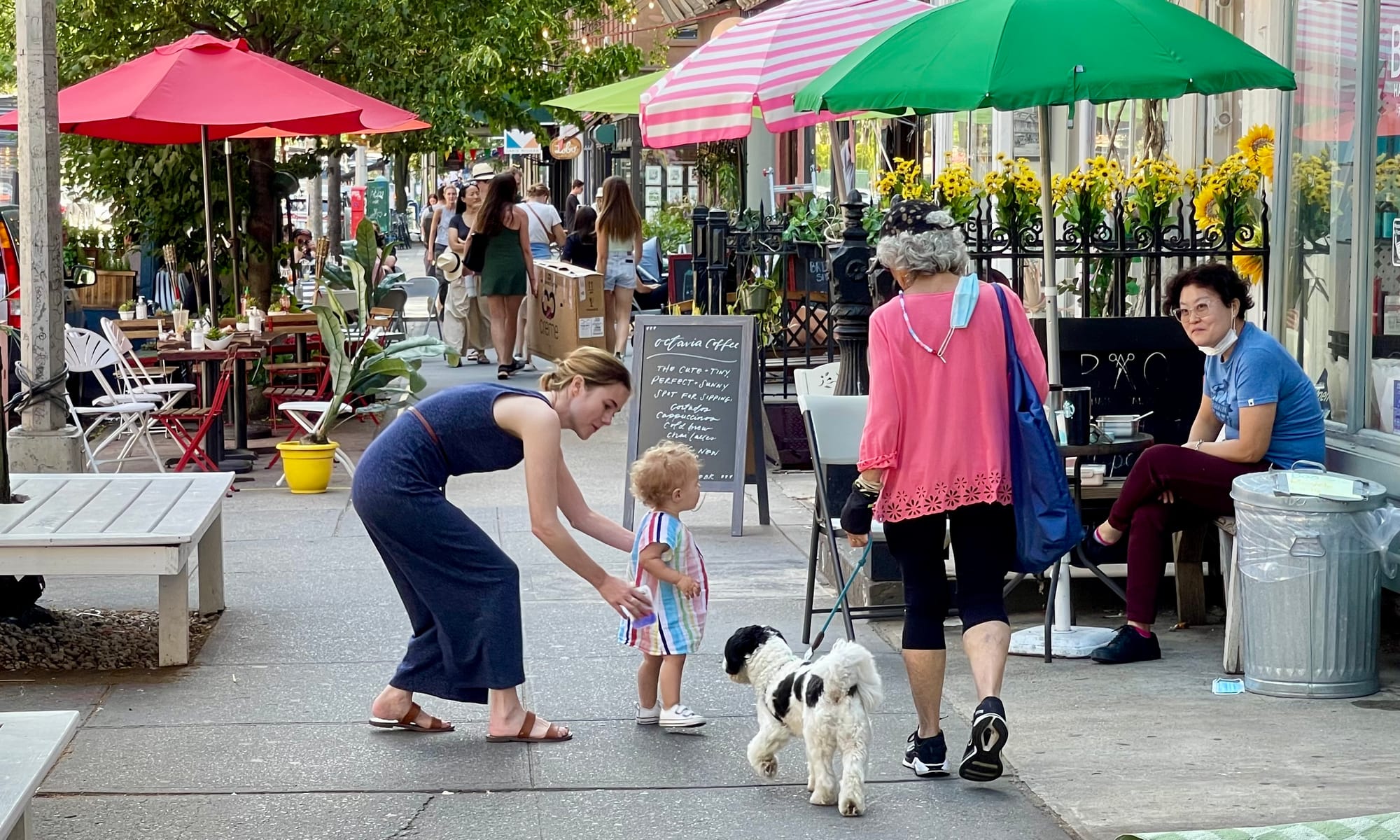
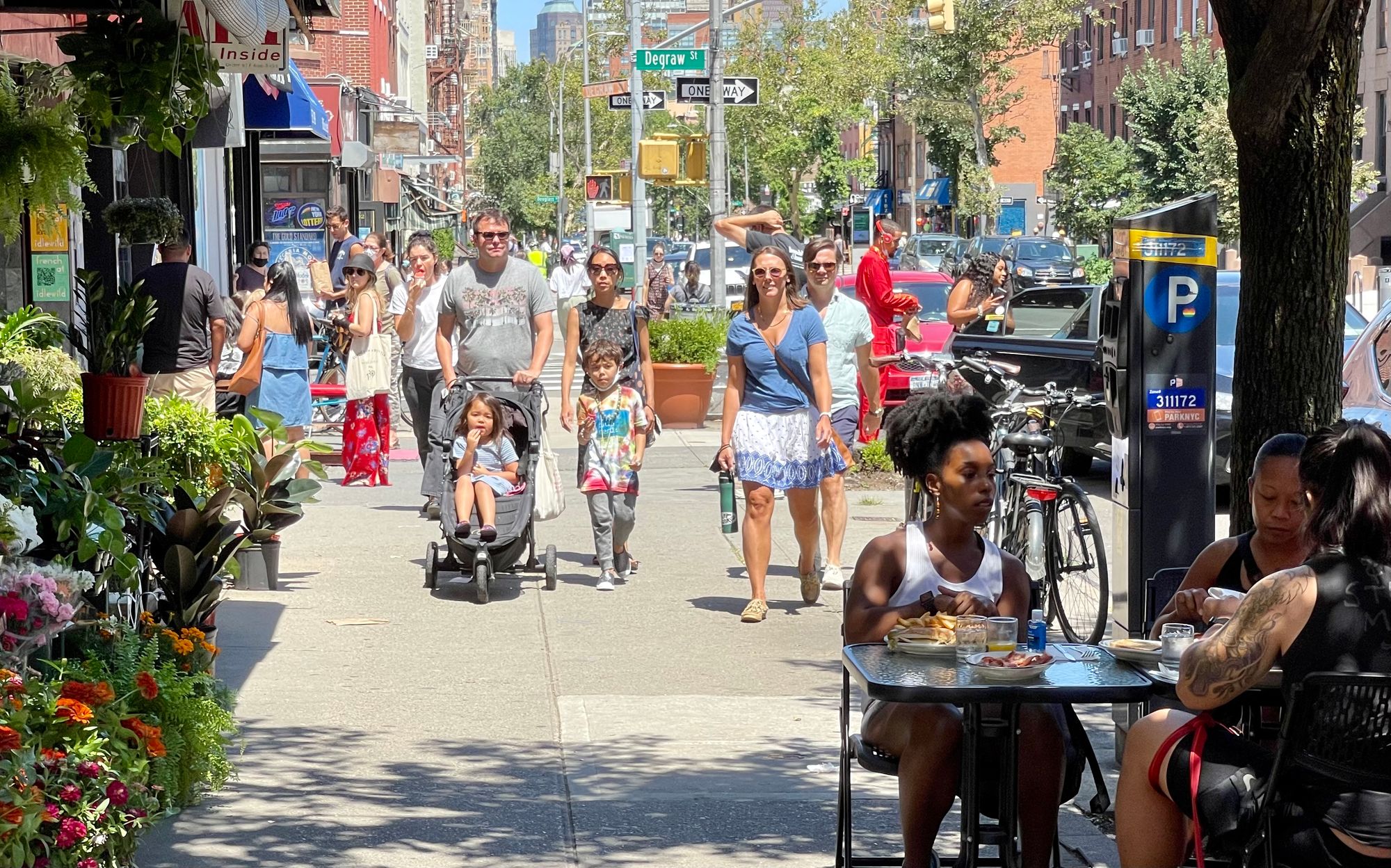
Cobble Hill and Carroll Gardens, Brooklyn
The sensory separation between people and the loud sounds and smells of cars also makes the sidewalks pleasant places to hang out, turning them into socially vibrant places to gather. In the midst of an epidemic of loneliness, we desperately need more places like this. Sidewalks with double loading become places to sit and chat, rather than just places to move along quickly on the way to some indoor destination. Everywhere becomes a destination and endless possibilities for connection and fun are opened up.
Double loading is also great for businesses because it makes space for them to have an increased presence on the sidewalk. The businesses no longer have to be relegated to the inside of a building. They can "wrap around" potential customers by having a presence on both sides of foot traffic, increasing the chances of people engaging with their goods or services. The whole display surrounds and invites passers-by to linger: People turn to the left and see a storefront, then turn to the right and see seating or products in kiosks. The chances of them stopping for a closer look at a business's offerings are therefore greatly increased.
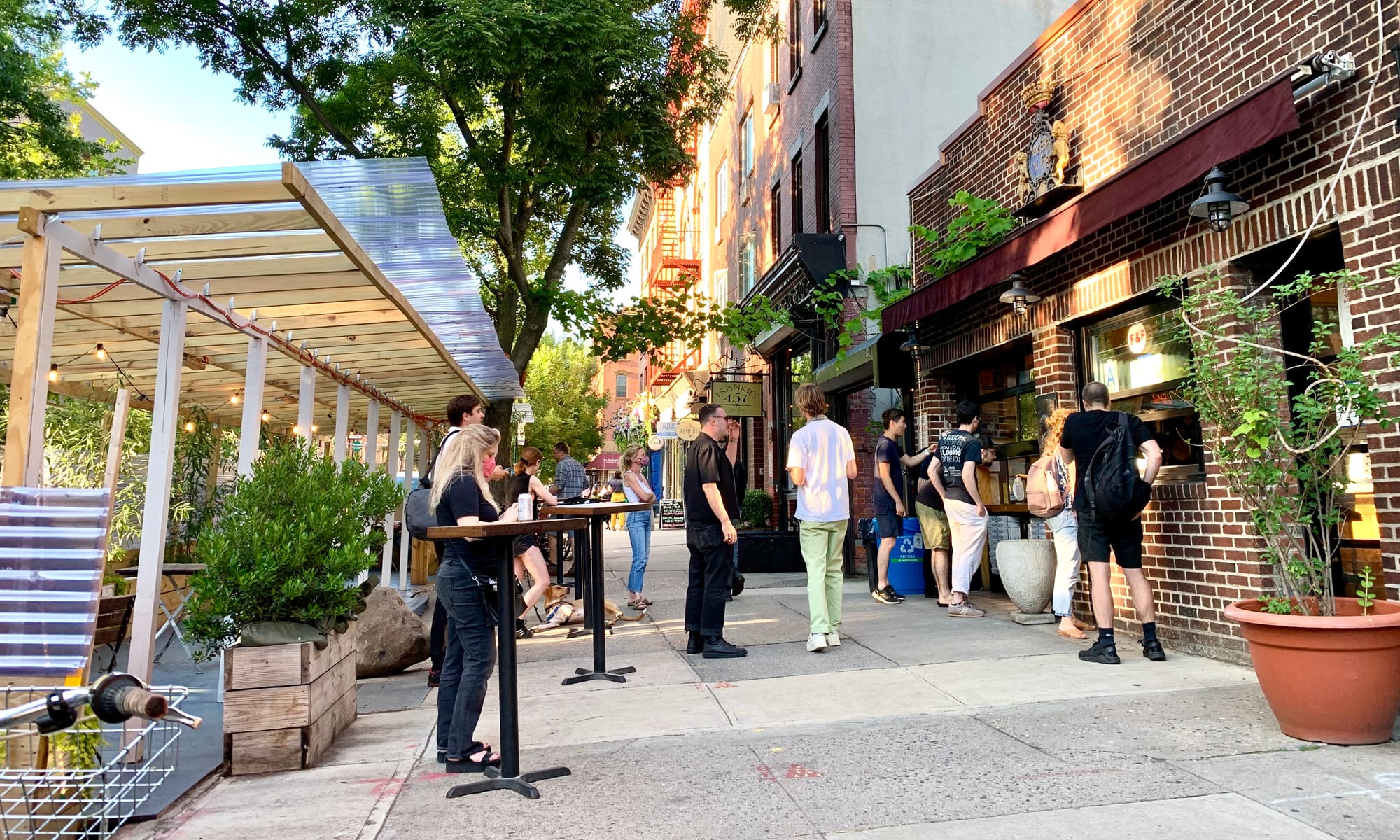
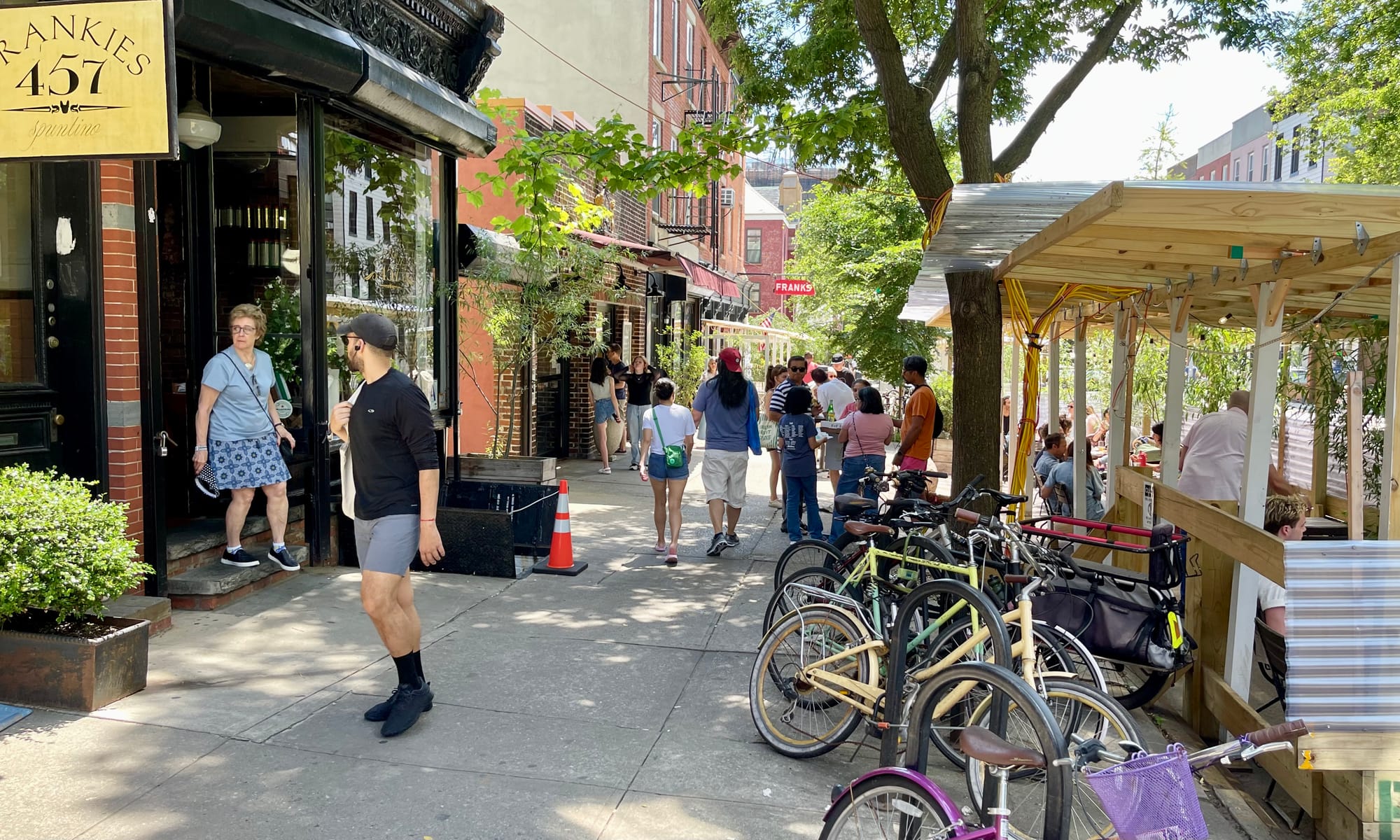
Streets Without Double Loading
When there is no double loading, as is common in virtually every American city and most small towns, the sidewalk becomes part of the traffic flow, acting as just another part of the "movement corridor" by practically blending in with the street area. Car noises, fumes, and the dangers they present dominate the space, forcing people to be vigilant, tense, and cautious, especially because they have to squeeze past other people on the narrow strip allotted for pedestrians. It feels stressful and unpleasant. People are mixed in with cars and there is no buffer of amenities to create a comfortable sense of protection and enclosure on the sidewalk.
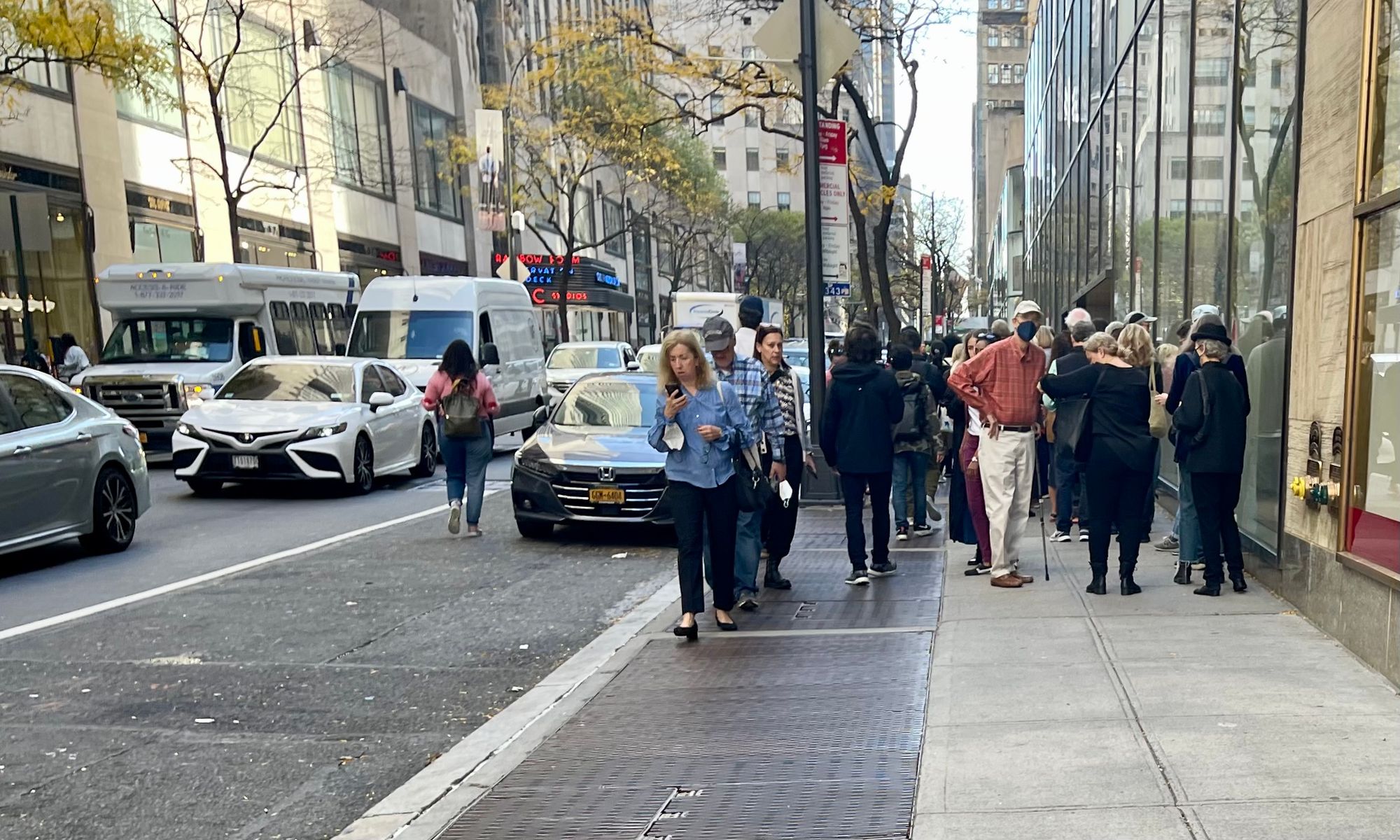
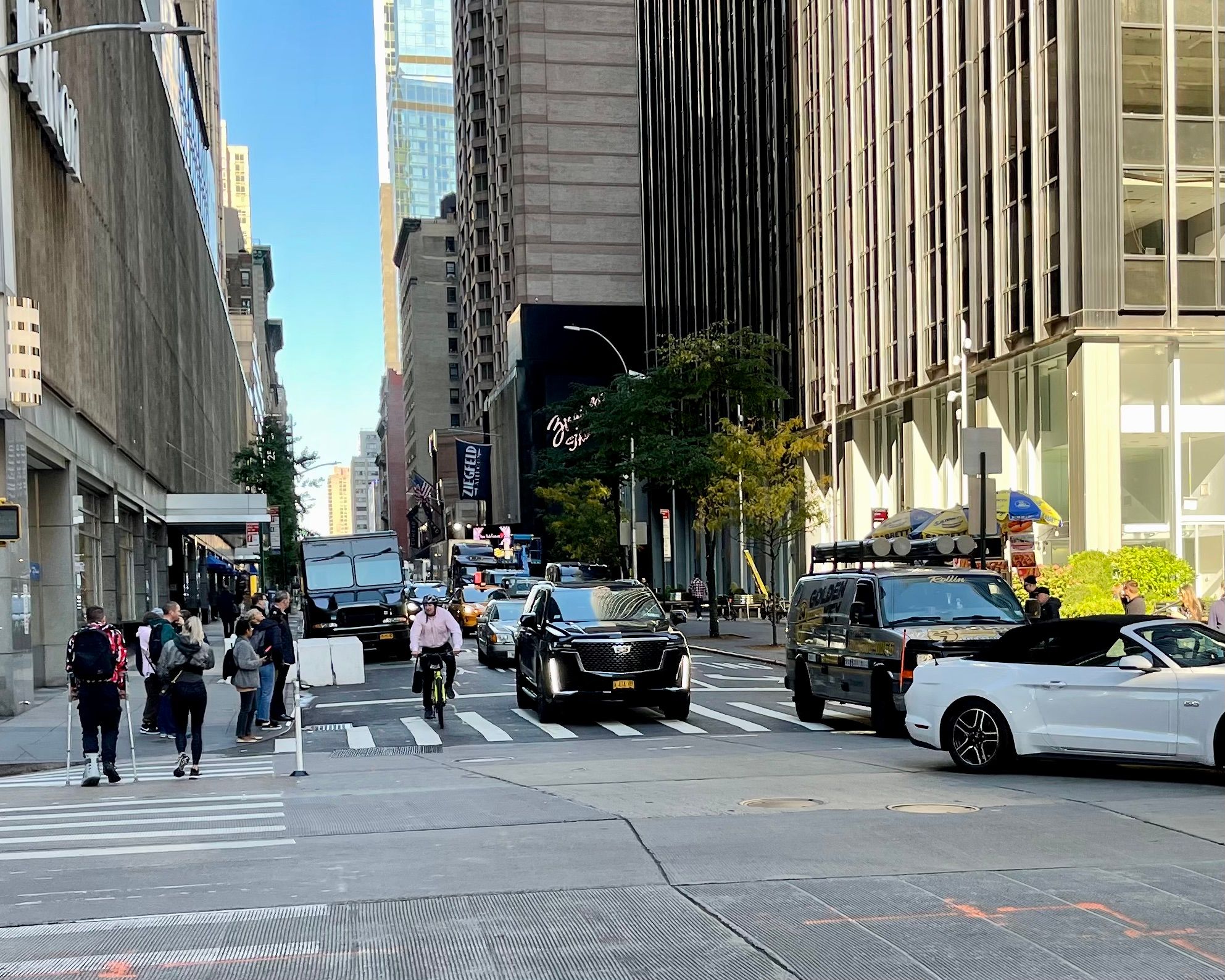
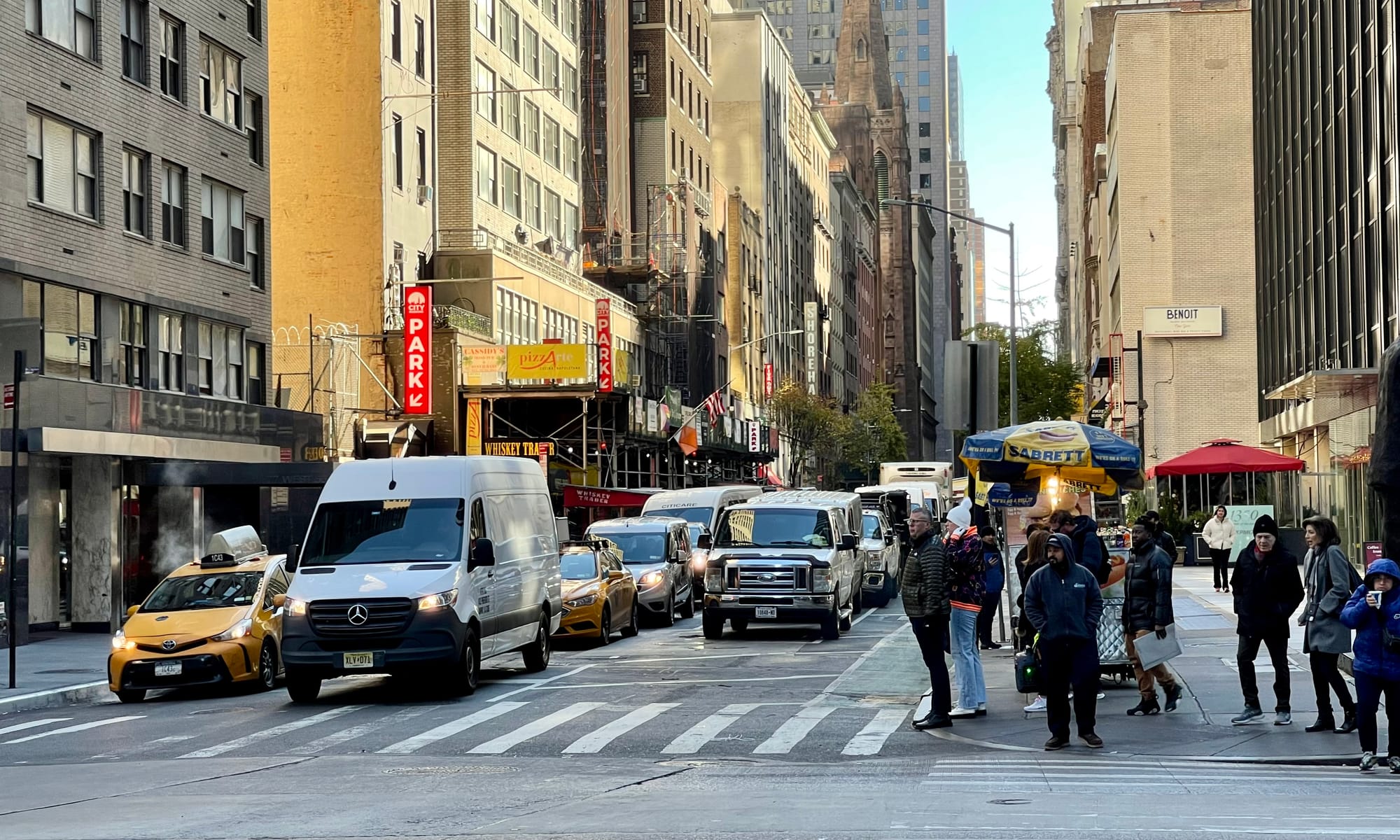
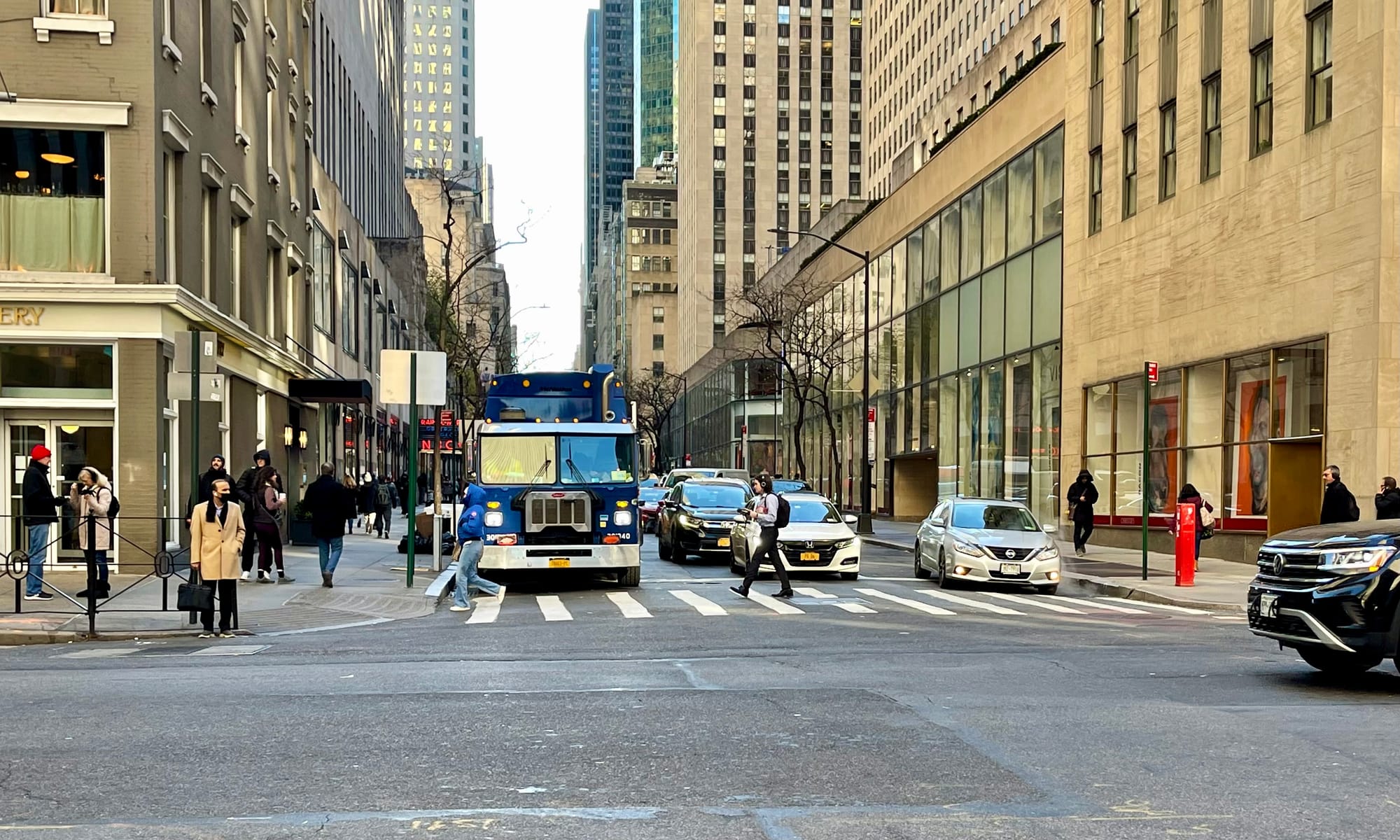
Most of Midtown Manhattan has sidewalks like these where intersection have car "stacking" of 3+ lanes
Double loading transforms walking from just a way to get from A to B into an enjoyable activity. Walking turns into strolling or promenading. Running errands turns into fun window shopping. Crossing paths with a friend or neighbor turns into sitting down for coffee and a chat. The whole experience of being outside improves.
The Different Kinds of Double Loading
Wide Streets
In cities with wide streets, double loading is best accomplished on the sidewalk when a barrier of amenities is created between the pedestrian walkway and the car lanes, paired with activations on the building side. These days, in urbanist discussions, curbside activations are talked about in the context of "curb management." The building side activations are what we at Social Life Project call "inside out design."
On many of our favorite wide streets, we see something that we call “inside-out design.” Inside-out design means that whatever is happening inside buildings spills out onto the sidewalks. Instead of a solid wall between the private and public realms, the walls are permeable, with people and things moving in and out. This is achieved through open windows and doors, outdoor seating, porches, and displays of goods pulled out into the sidewalk area.
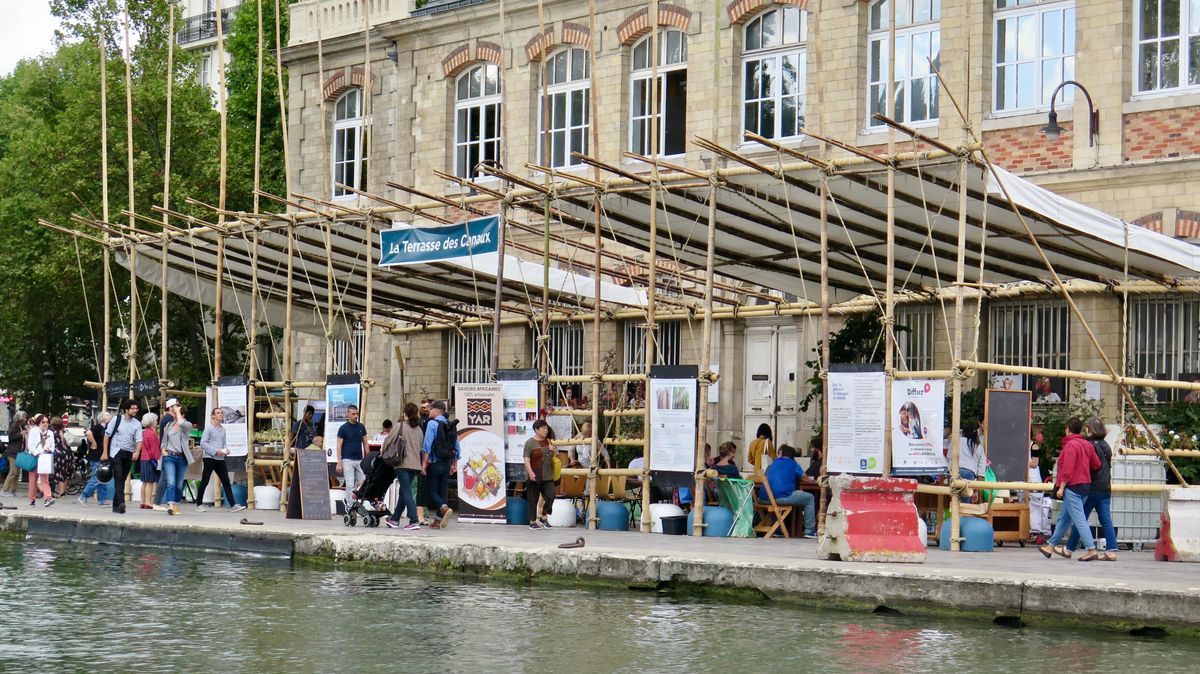
When you look anywhere around the world, this kind of inside-out design is common. It's typical to see stores interacting with sidewalk life and even commercial sheds and market stalls that are completely in the open. In places like this, people love to gather, connect with merchants, and sit with friends outside. The dynamic activity characteristic of "inside-out places" creates a vibrant experience that everyone enjoys.
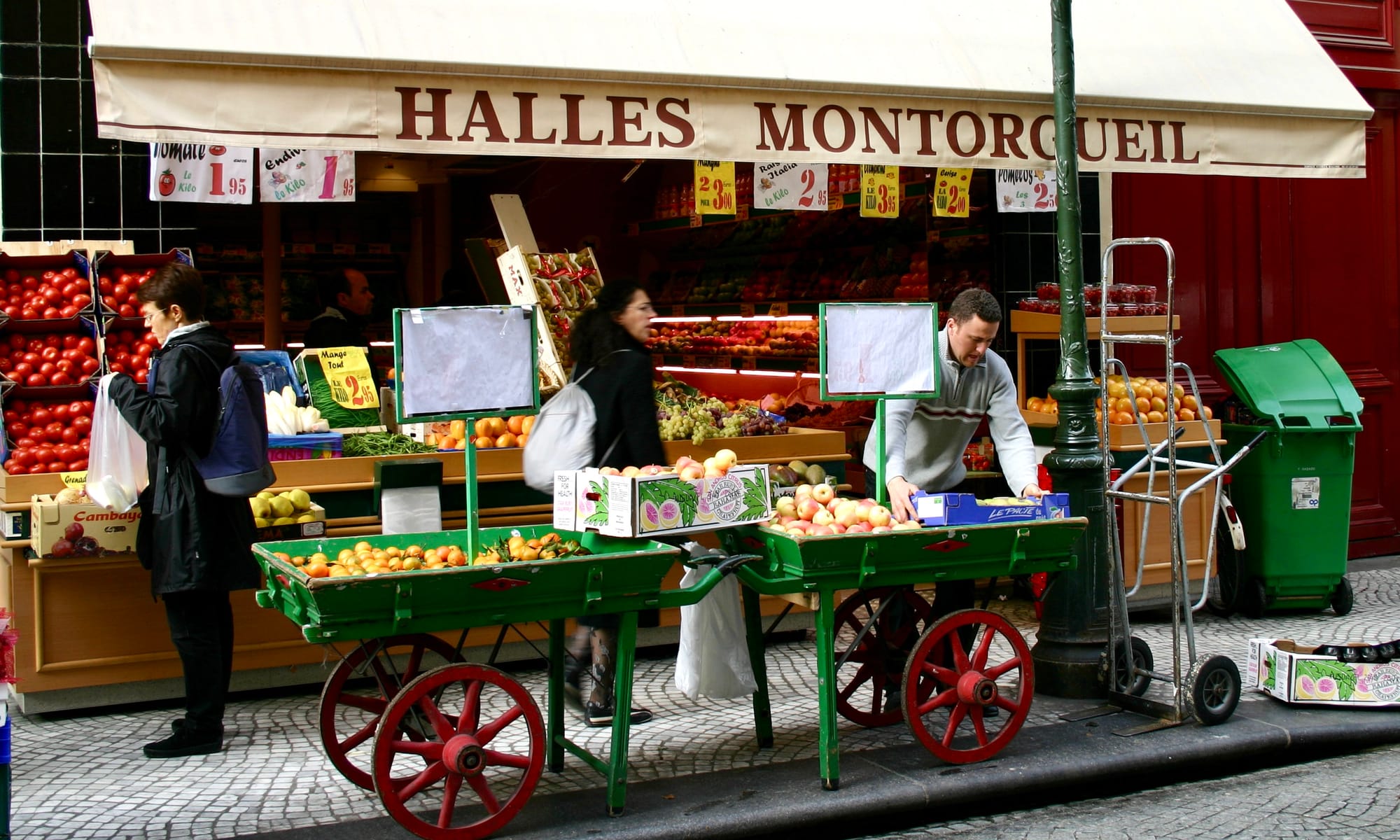

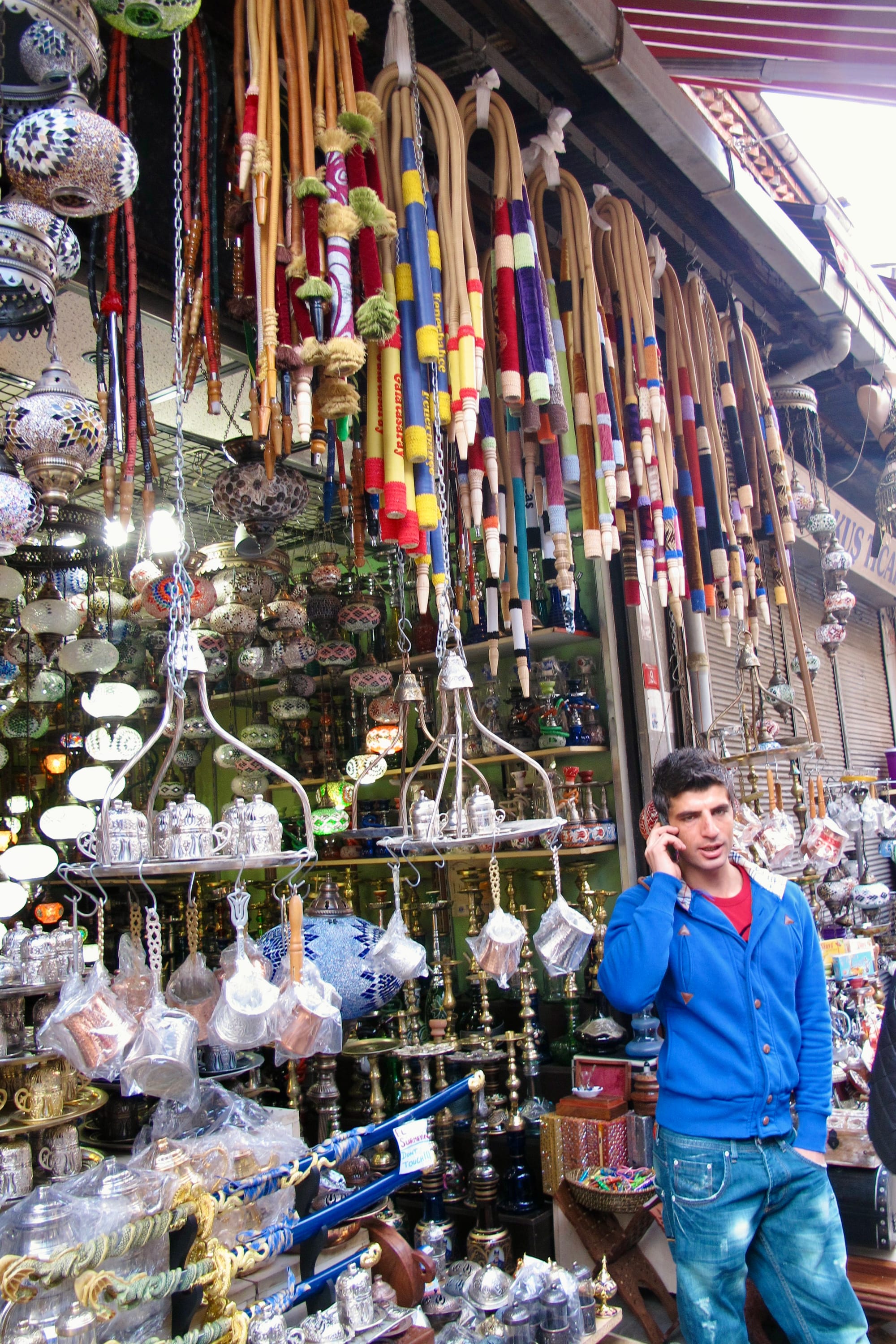
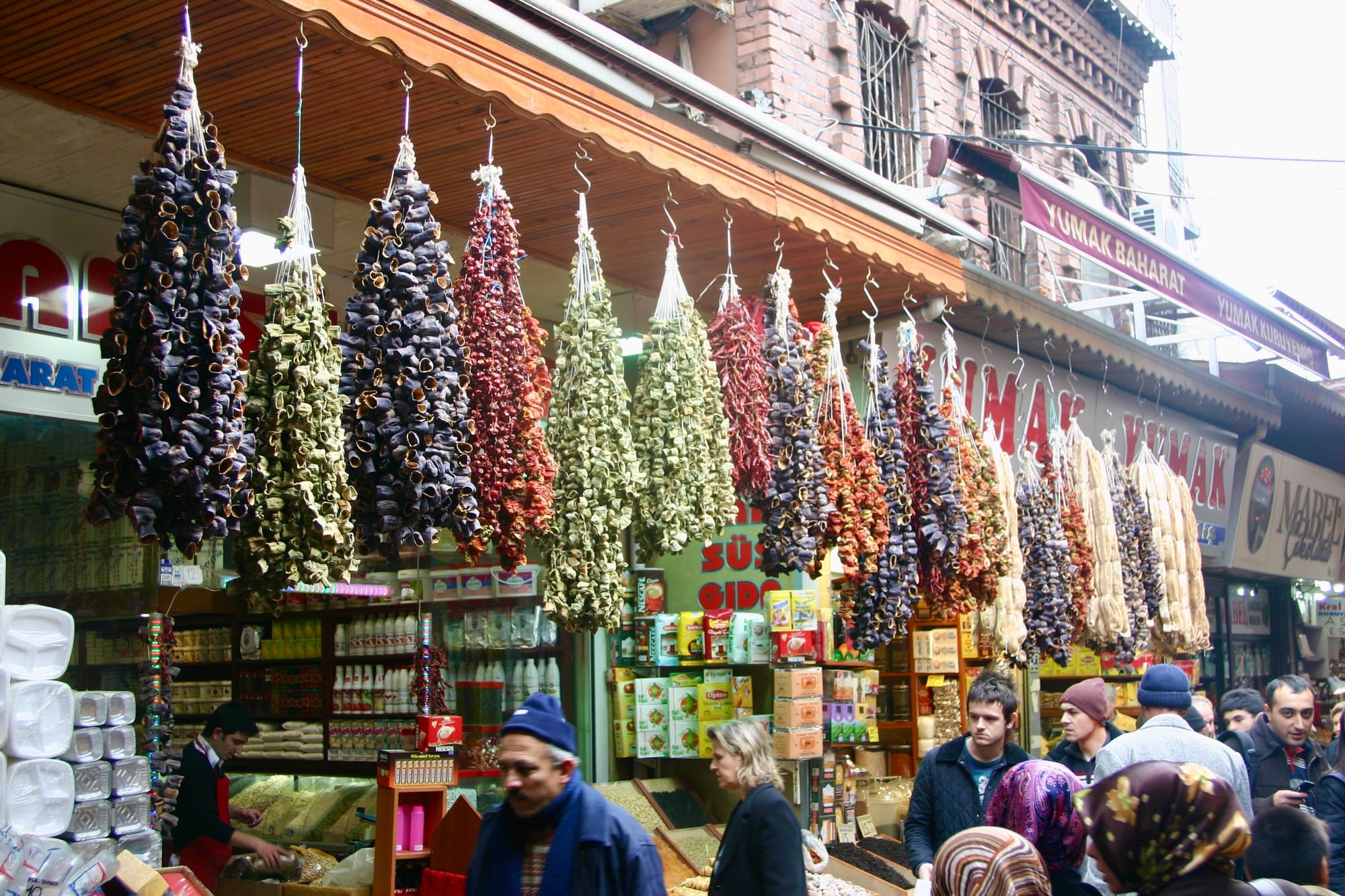
However, many western societies, especially in North America, are repressed by a culture that caters to the car and doesn’t allow anything to disturb its smooth passage through town. That includes wide sidewalks with a lot going on and plentiful foot traffic, which are seen as a distraction to drivers and a reason to narrow car lanes.
Designing to "make cars happy" in this way gives cars control over all of our lives, letting them shape the places where we spend so much of our time – streets and public places. We must switch this power dynamic in order to bring life back to our communities and create places where people, not just the car industry, can thrive.
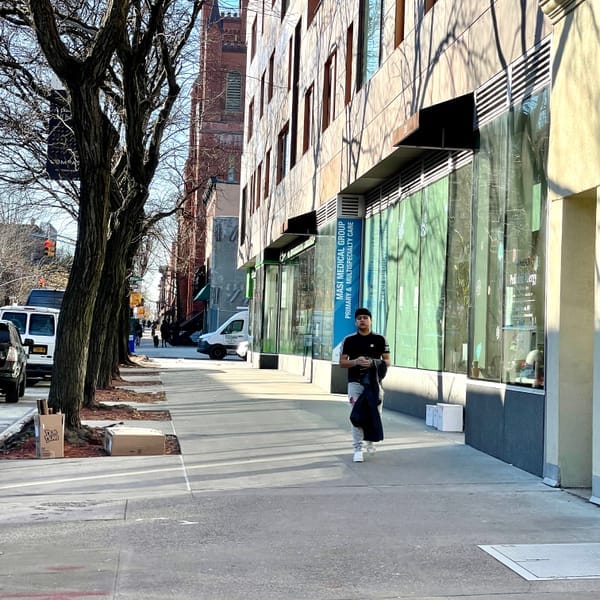
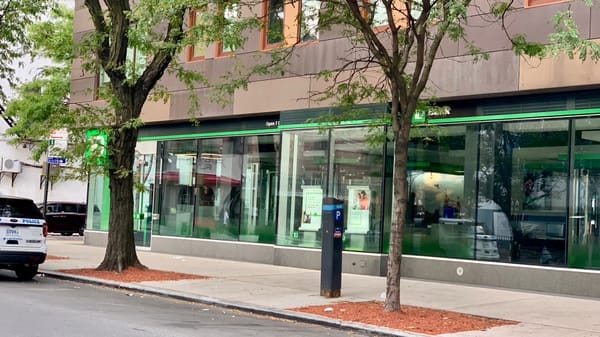
When sidewalks are designed with cars in mind, there is little social life or economic activity
On wide and hostile streets like the kind we see in big cities all around the world, double loading can be a method to create a parallel "street" to the main street because the curb-side activations create a kind of wall between the pedestrian walkway and car traffic. That leads to the sidewalk feeling like its own separate pedestrian-only "street" that happens to be next to a street where cars dominate. A great example of this is Passeig de Gracia in Barcelona and Champs-Élysées in Paris. The sidewalks are very wide and double-loaded, making them feel like their own separate pedestrian streets, not merely sidewalks along the principal street.
Atlantic Ave in Brooklyn, between Brooklyn Heights and Cobble Hill, has the possibility to do this on its north side. If travel lanes were slightly narrowed here, adding a few feet to the parking lane would create an extended sidewalk which could be double-loaded all along the curb. A mid-block crossing could also be an important way to bring the two sides of the street together, combined with wider crosswalks at intersections and extended curbs to narrow the street. The result would be a great pedestrian/shopping/cafe area that would tie the communities on either side of the street together (which are now separated by the wall of traffic that the street drives between them) which would create something of a Restaurant Row.
Double Loading on Narrow Streets
In many countries, especially those with cities built before the arrival of the car, a delightful sense of enclosure is accomplished by simply having narrow streets flanked by moderately high buildings, the content of which interacts with and spills over into sidewalk activity. In this case, "inside-out design" on both building sides creates the active and interesting walking experience that double-loaded sidewalks on wide streets do. Bollards can also help to mark the border between the car area and the pedestrian area in tighter spaces.
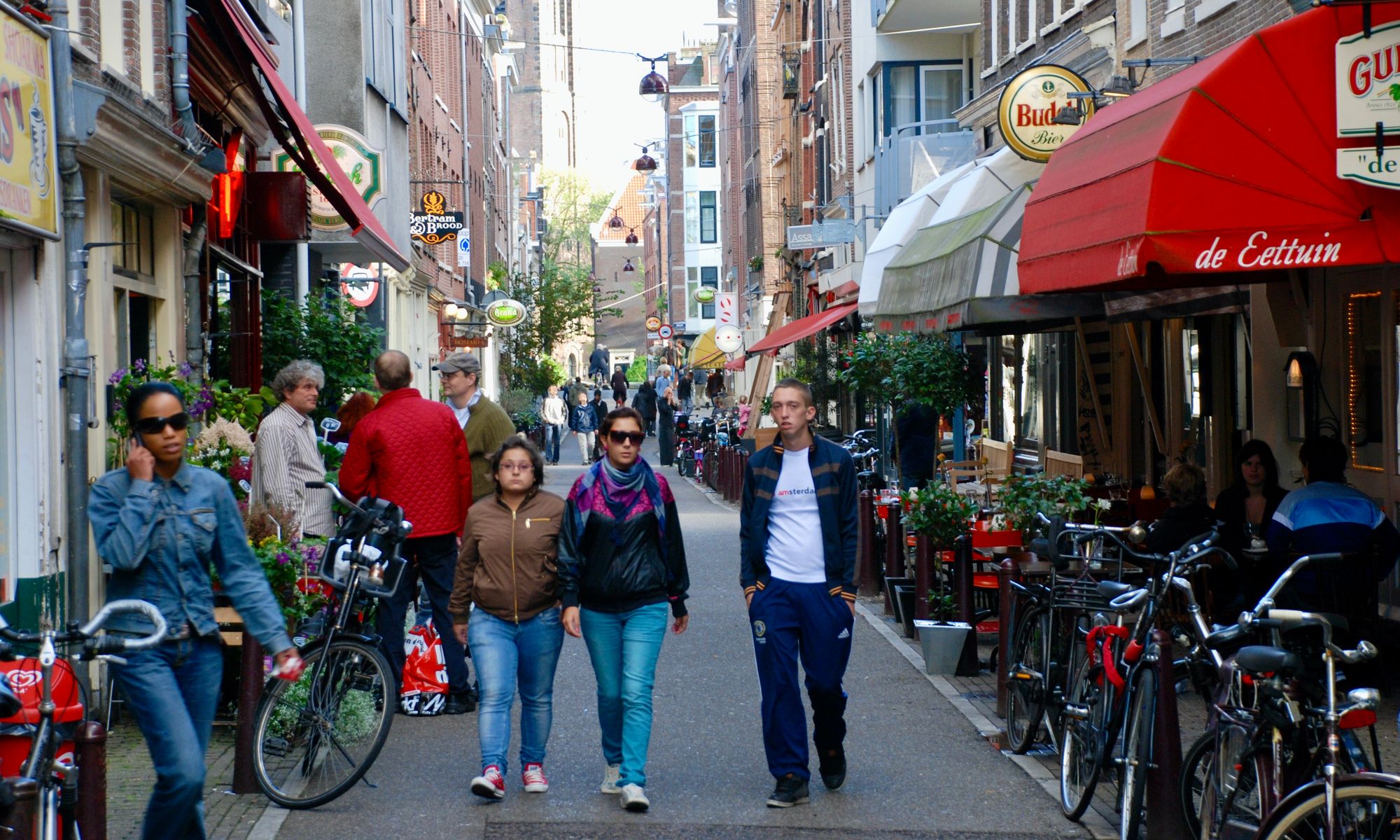
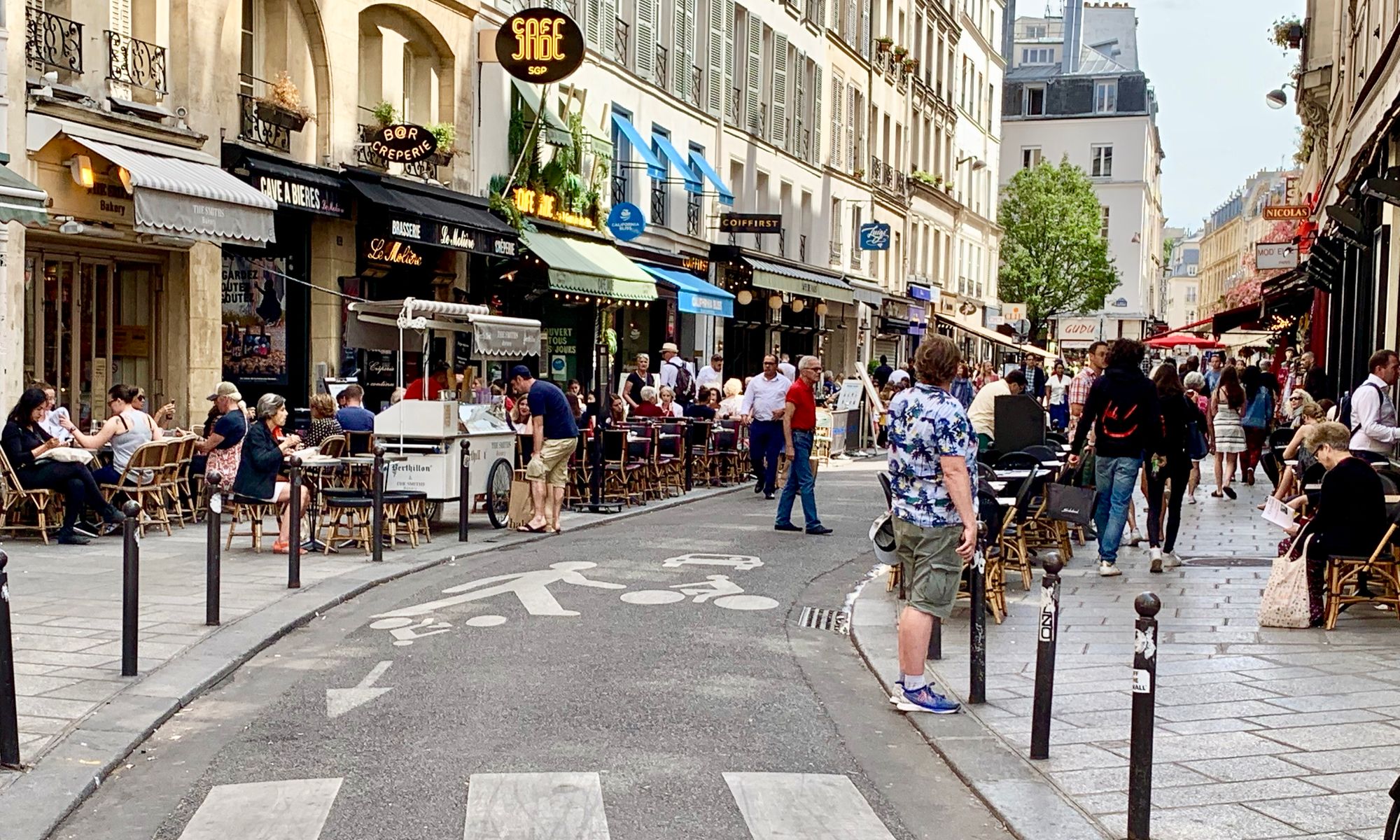
Paris and Amsterdam
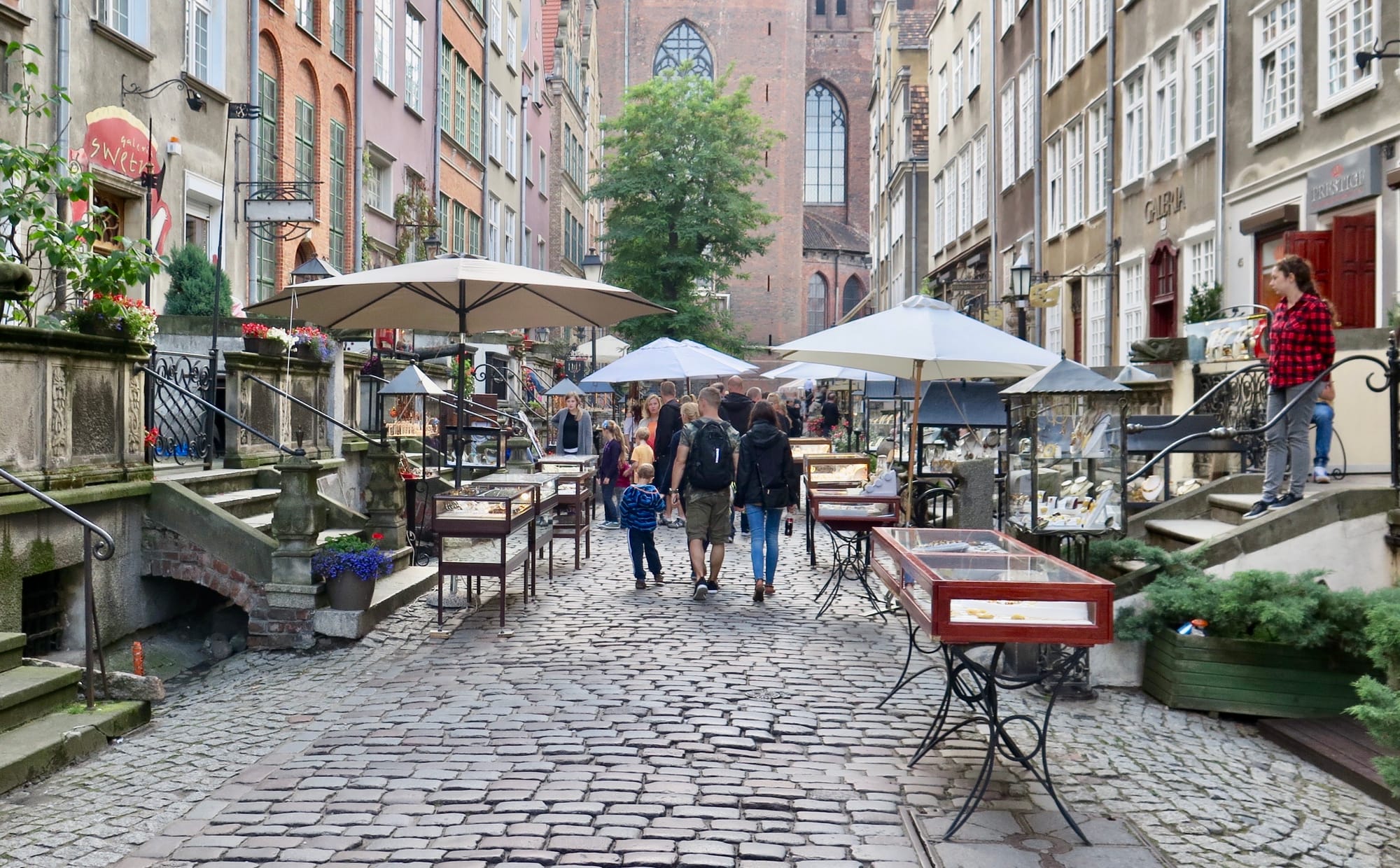
Gdansk
Double Loading on Very Wide Sidewalks
On sidewalks as wide as those along Paris's main boulevard, Champs-Élysées, you could even do triple loading with amenities on the building side, along the curb, and down the middle. The more interesting things to see and do, the better.
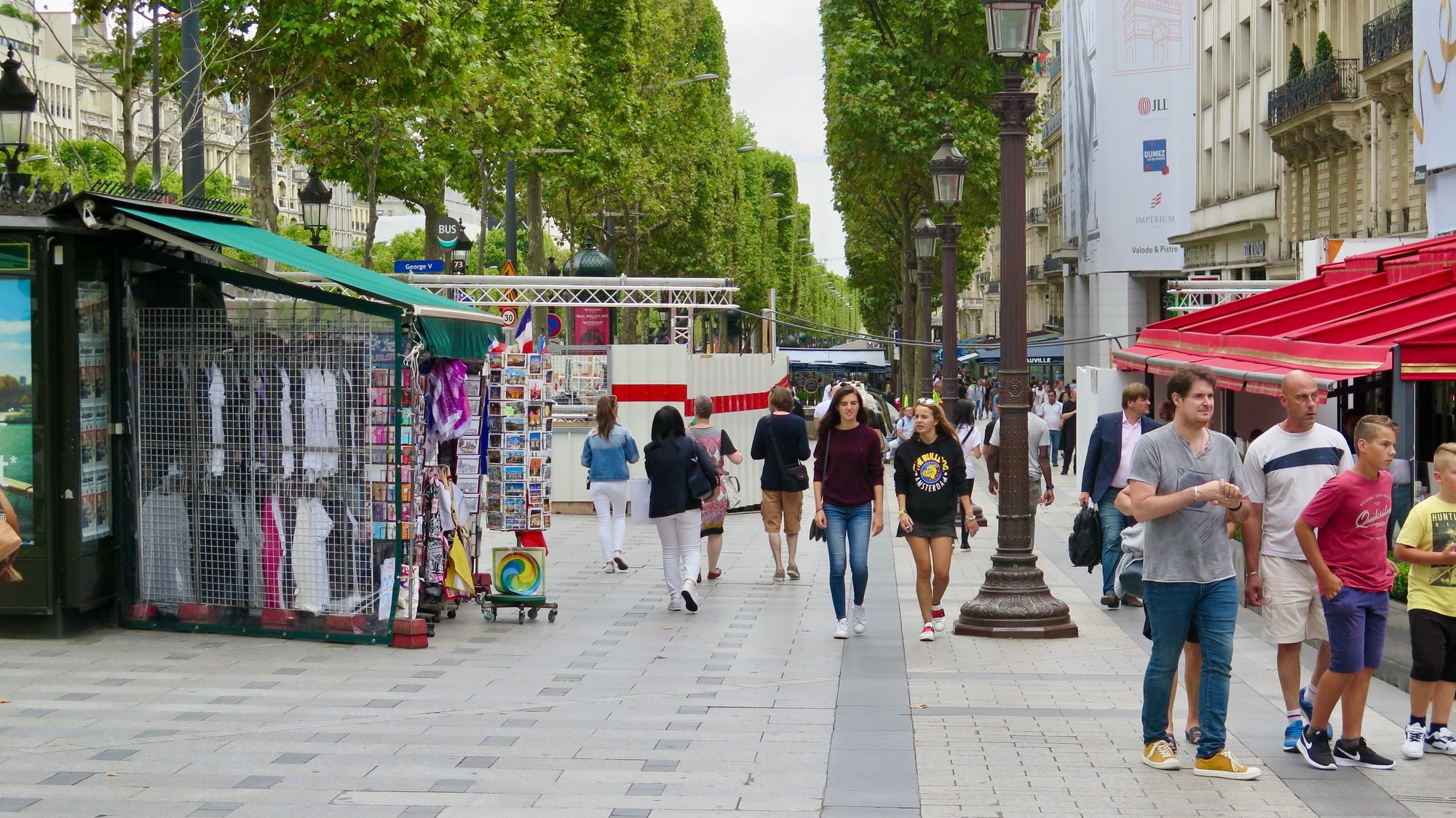
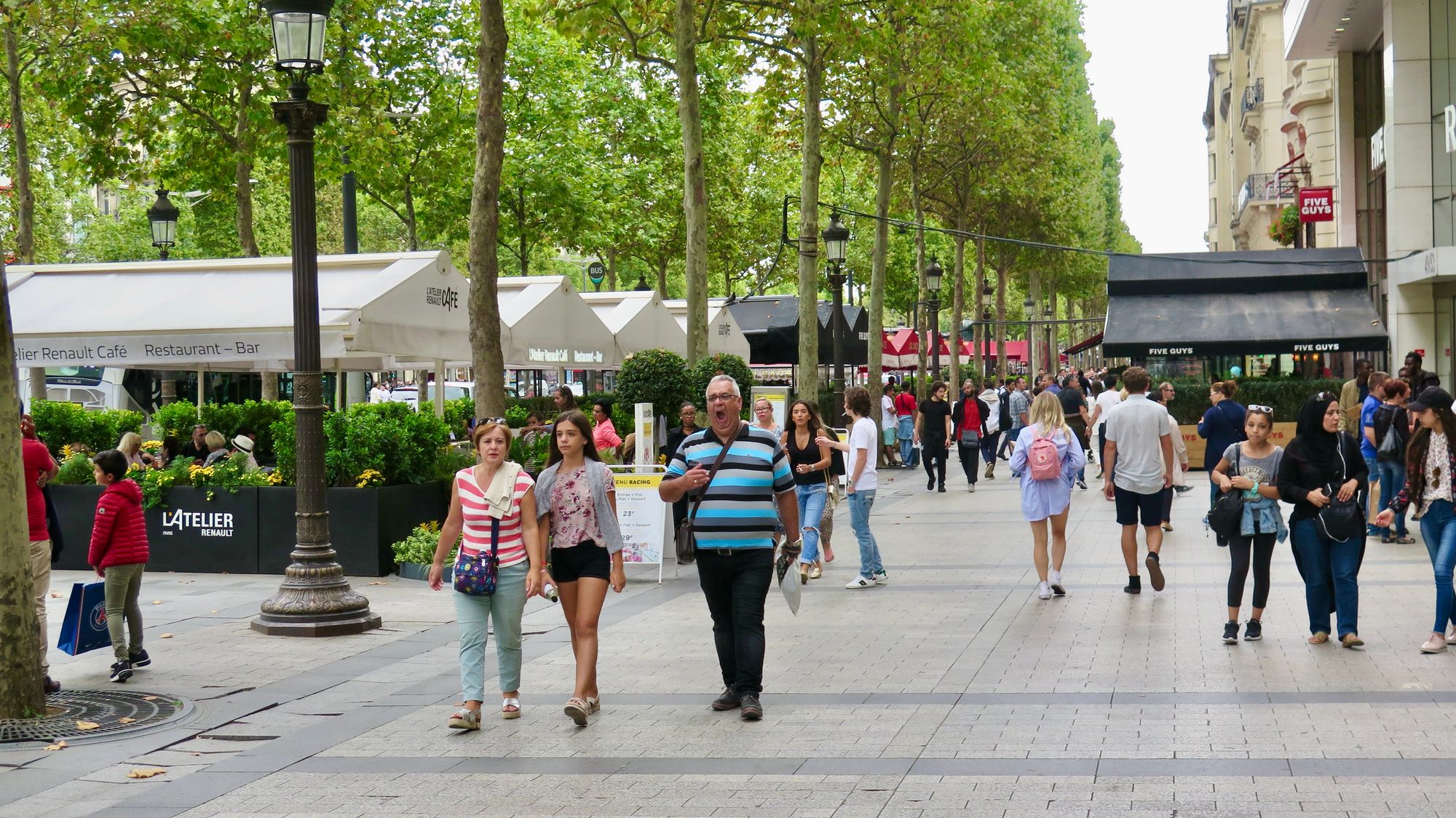
Paris - Champs-Élysées
Barcelona's Passeig de Gracia also has very wide sidewalks. They have activations on the building side which have inside-out design, and beside it a pedestrian pathway with seating and kiosks on its other side. Because the sidewalk here is so wide, on the other side of that central set of activations there is even more going on: a bus stop loading zone, benches, a bike lane, and other amenities.
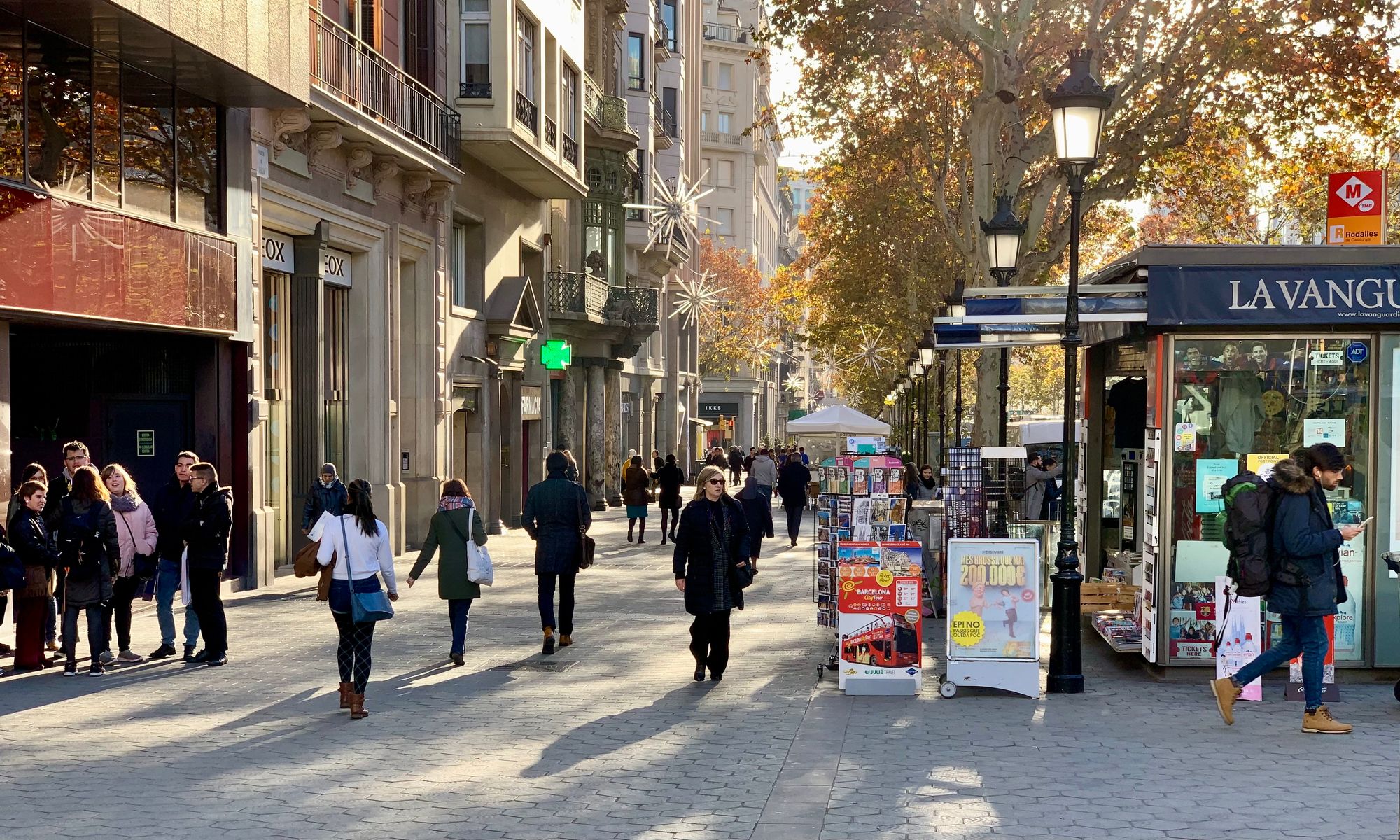
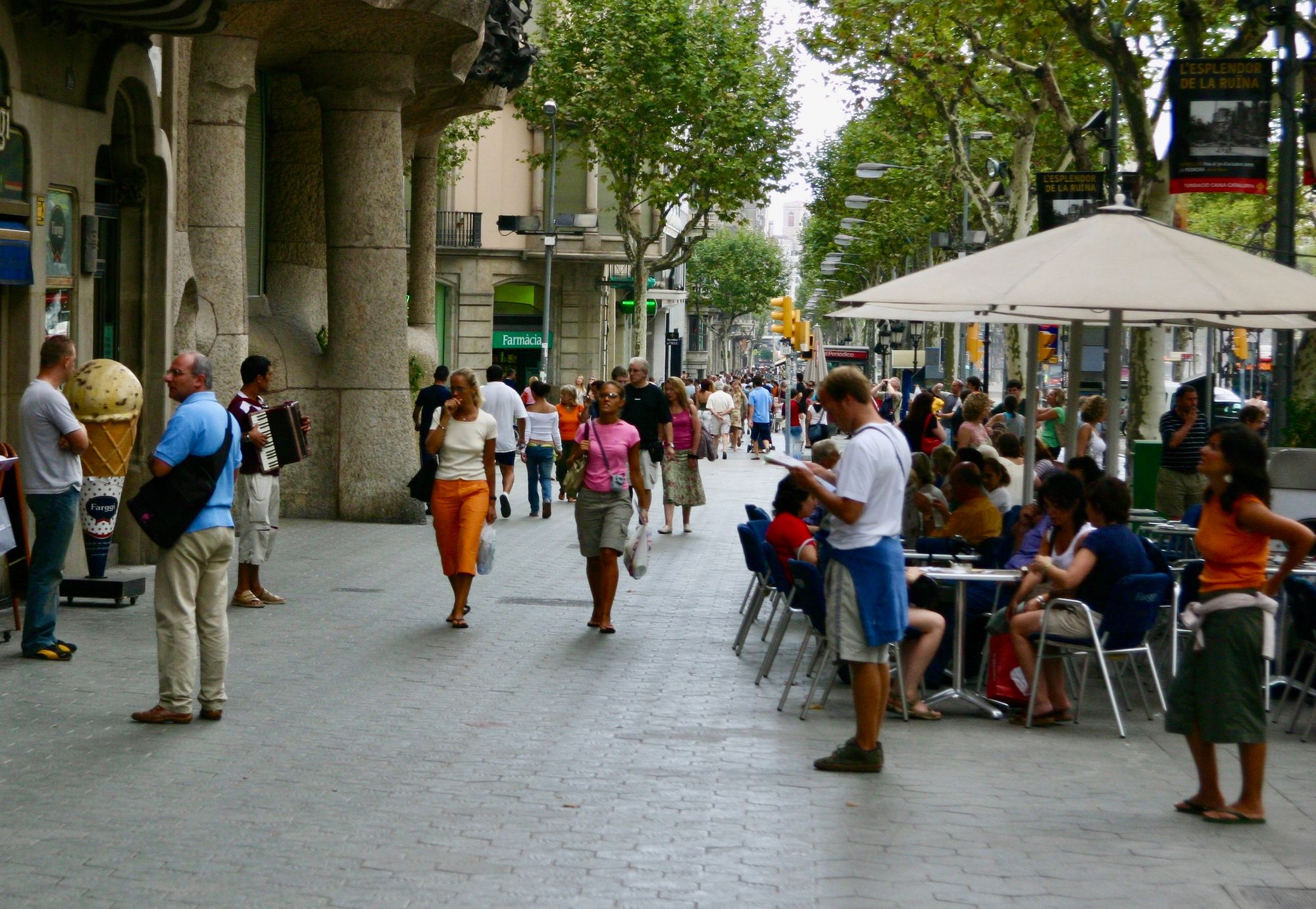
Barcelona sidewalks
Indoor Double Loading
Double loading isn't a concept just for open-air streets. The Ithaca Farmers Market is like a covered street or a 500 foot long "dining shed," creating a walking and shopping experience that's more engaging than most Main Streets we know.
In places like Ithaca Farmers Market, people attract people who attract even more people, until everyone feels like they have to be there to be at the heart of activity. Connecting with others becomes a primary reason to come. The more there is to see and do, the more people will come to see and do it – a simple fact of life.
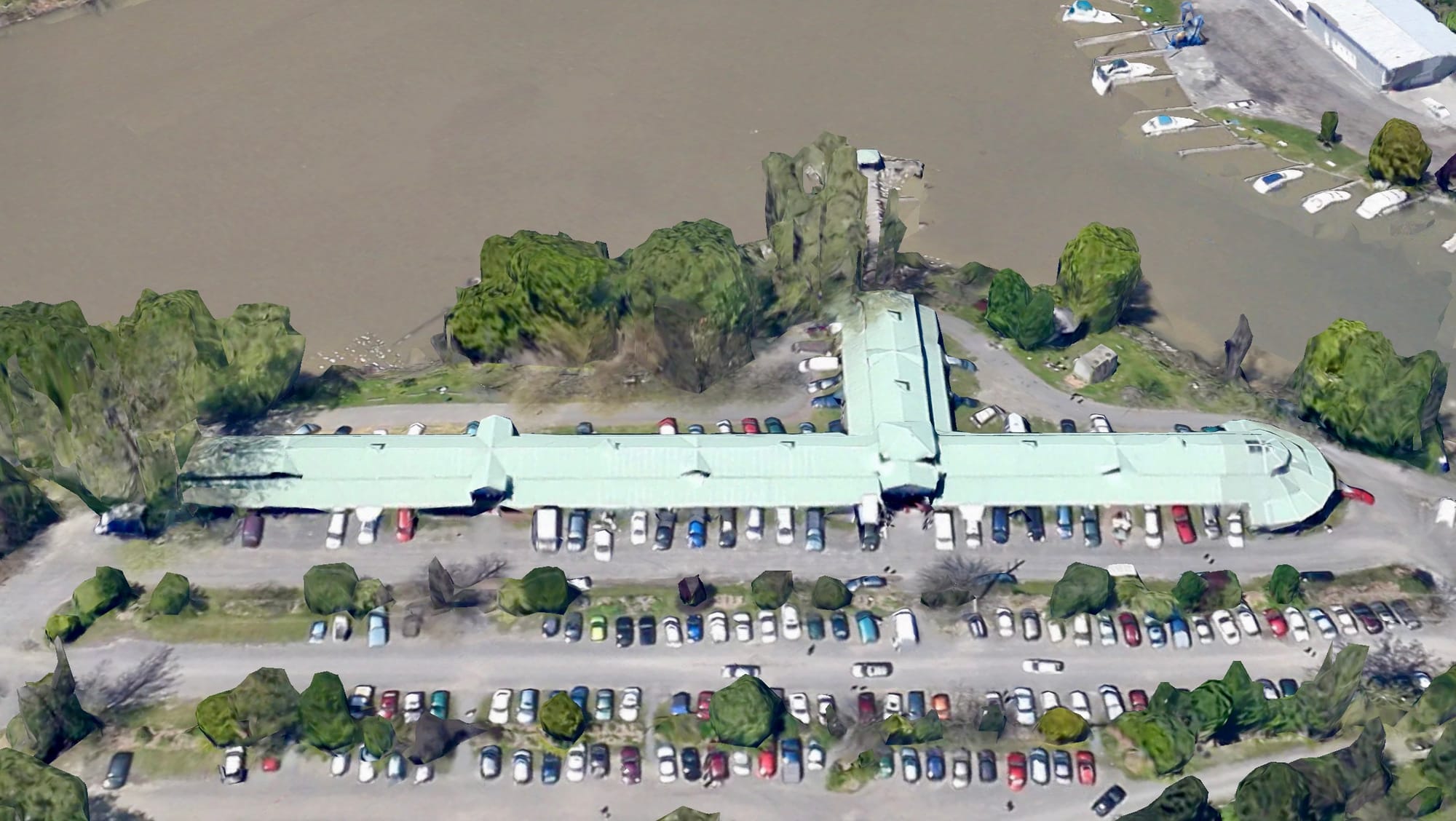
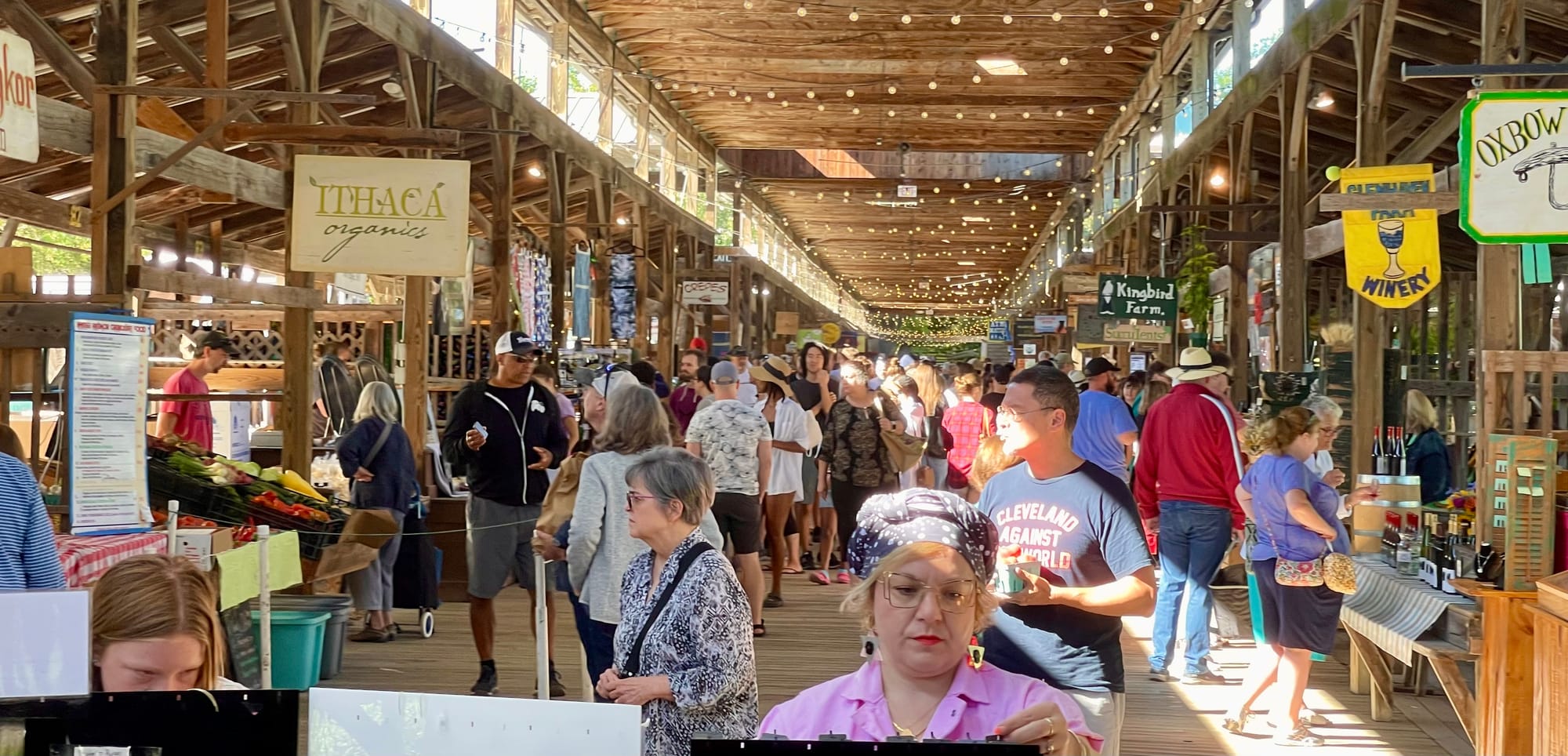
One could argue that a shed like this could even straddle a street, open to traffic on non-market days
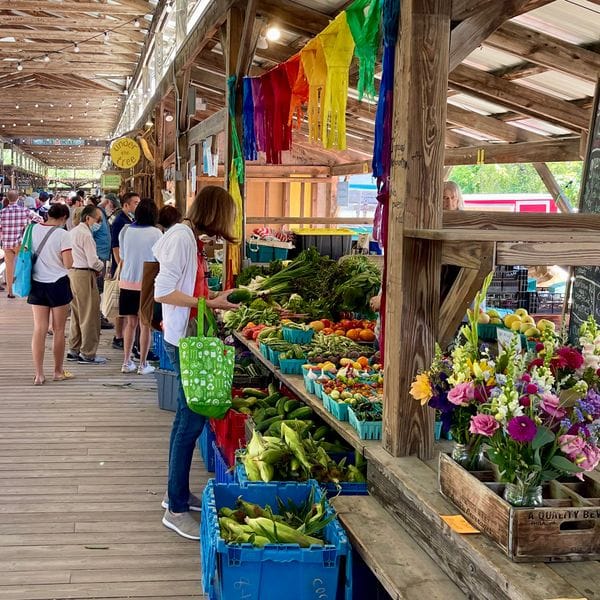
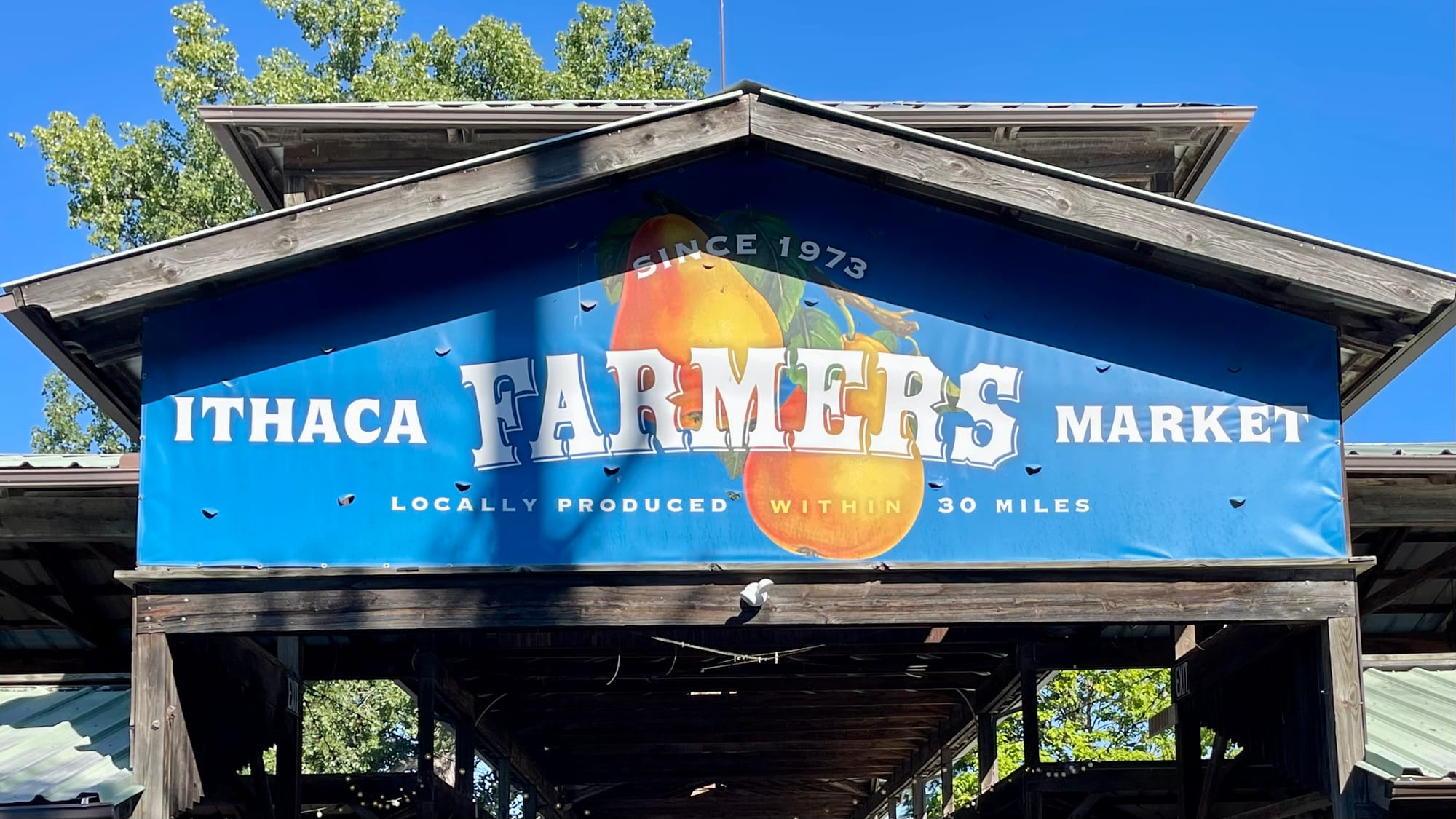
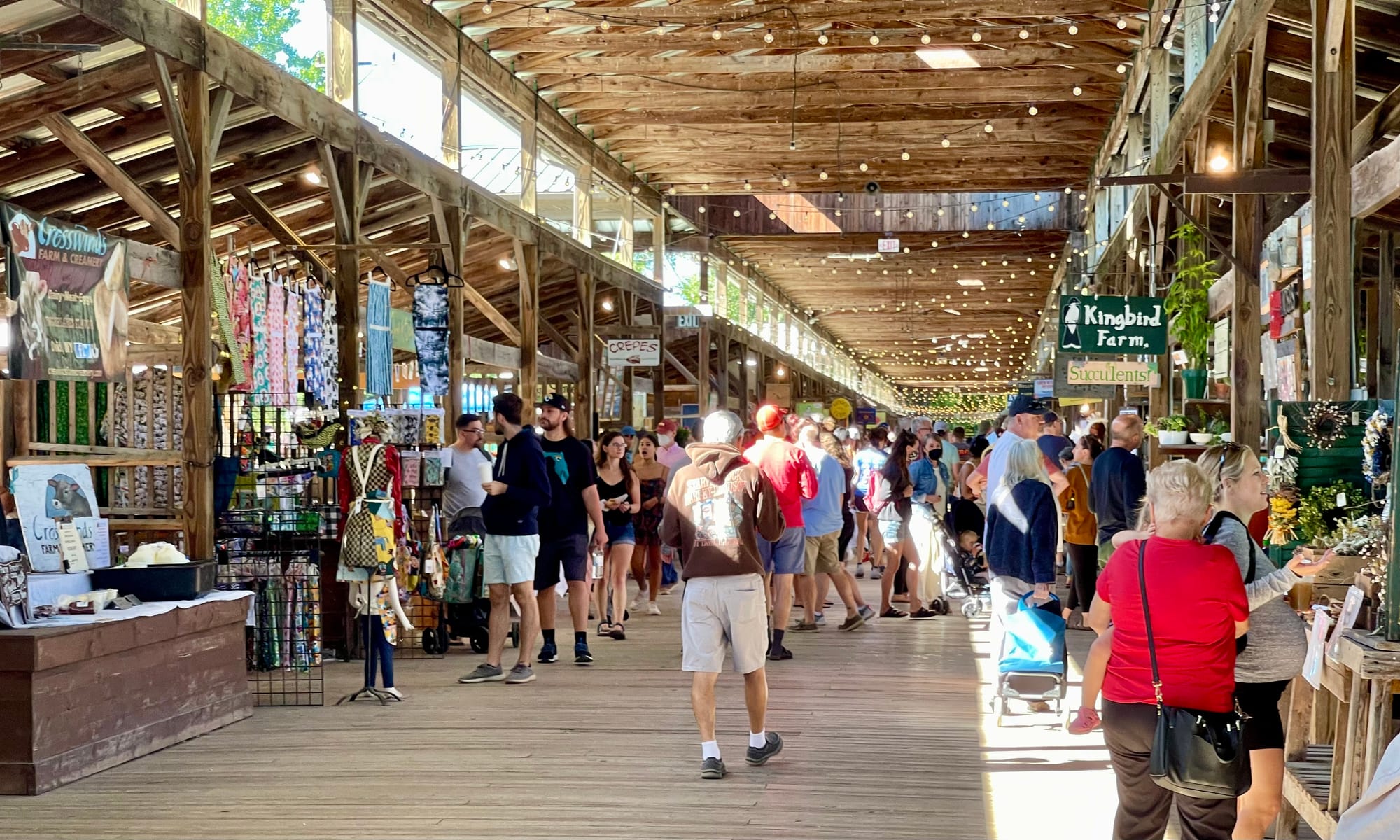
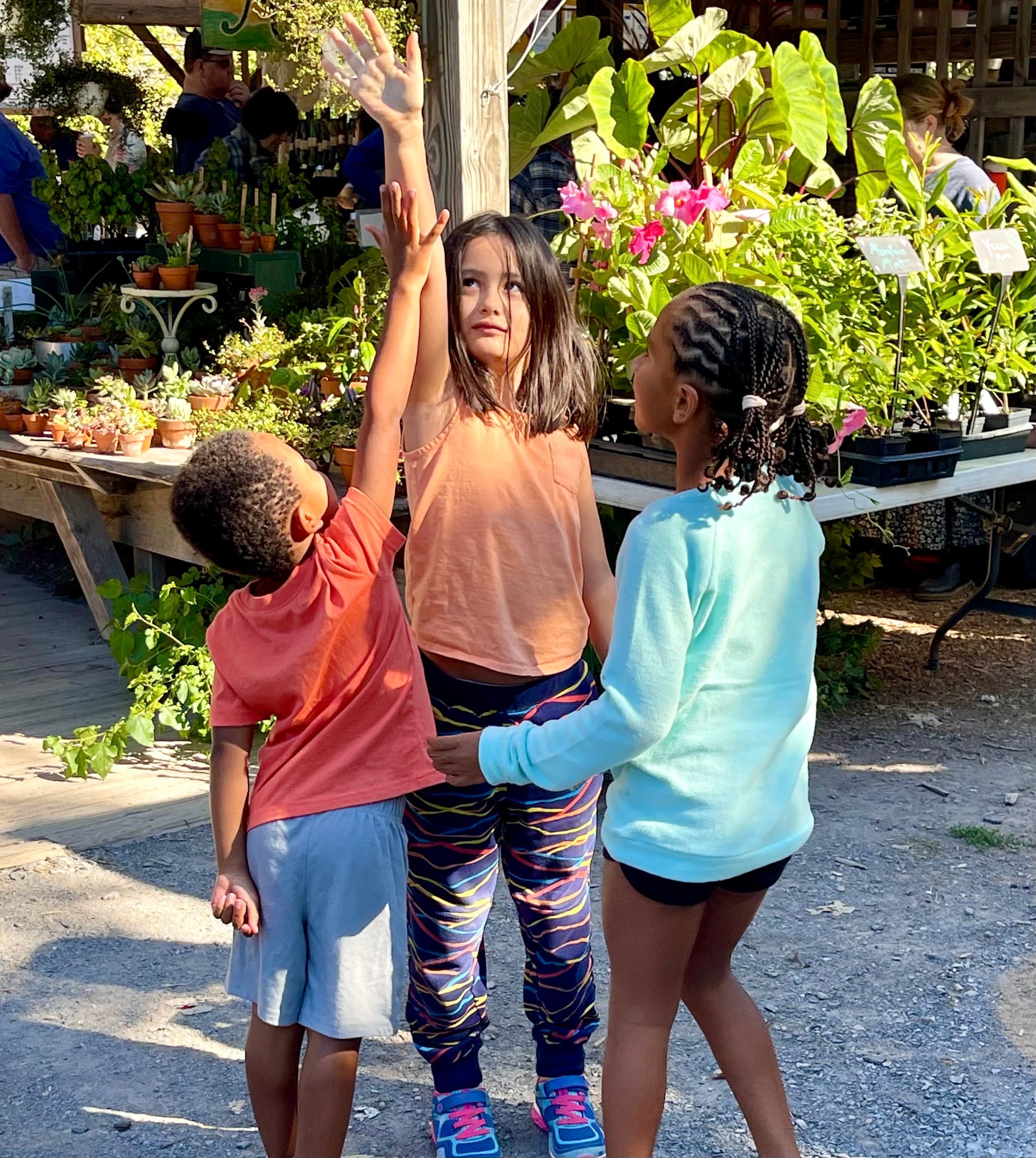
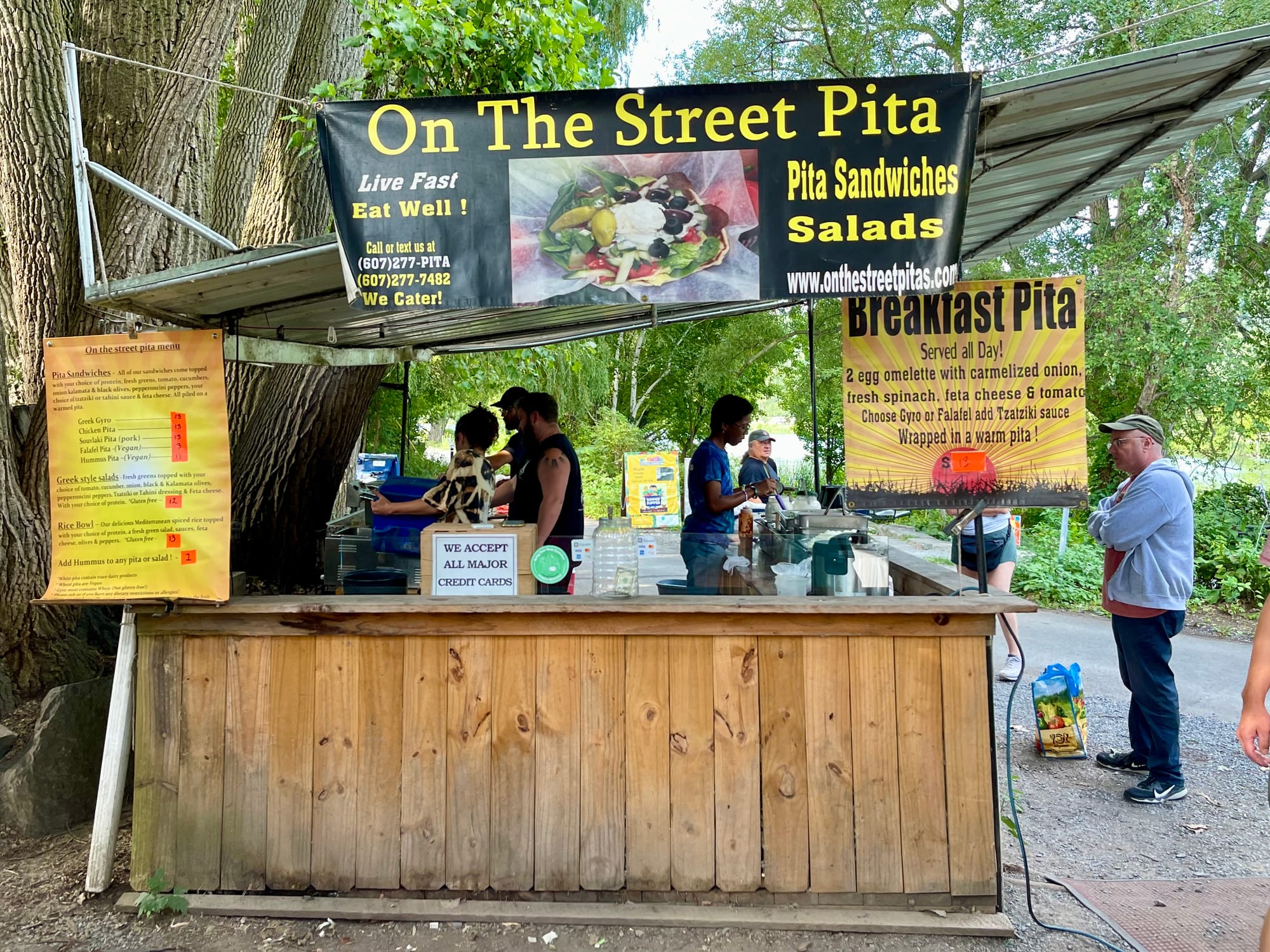

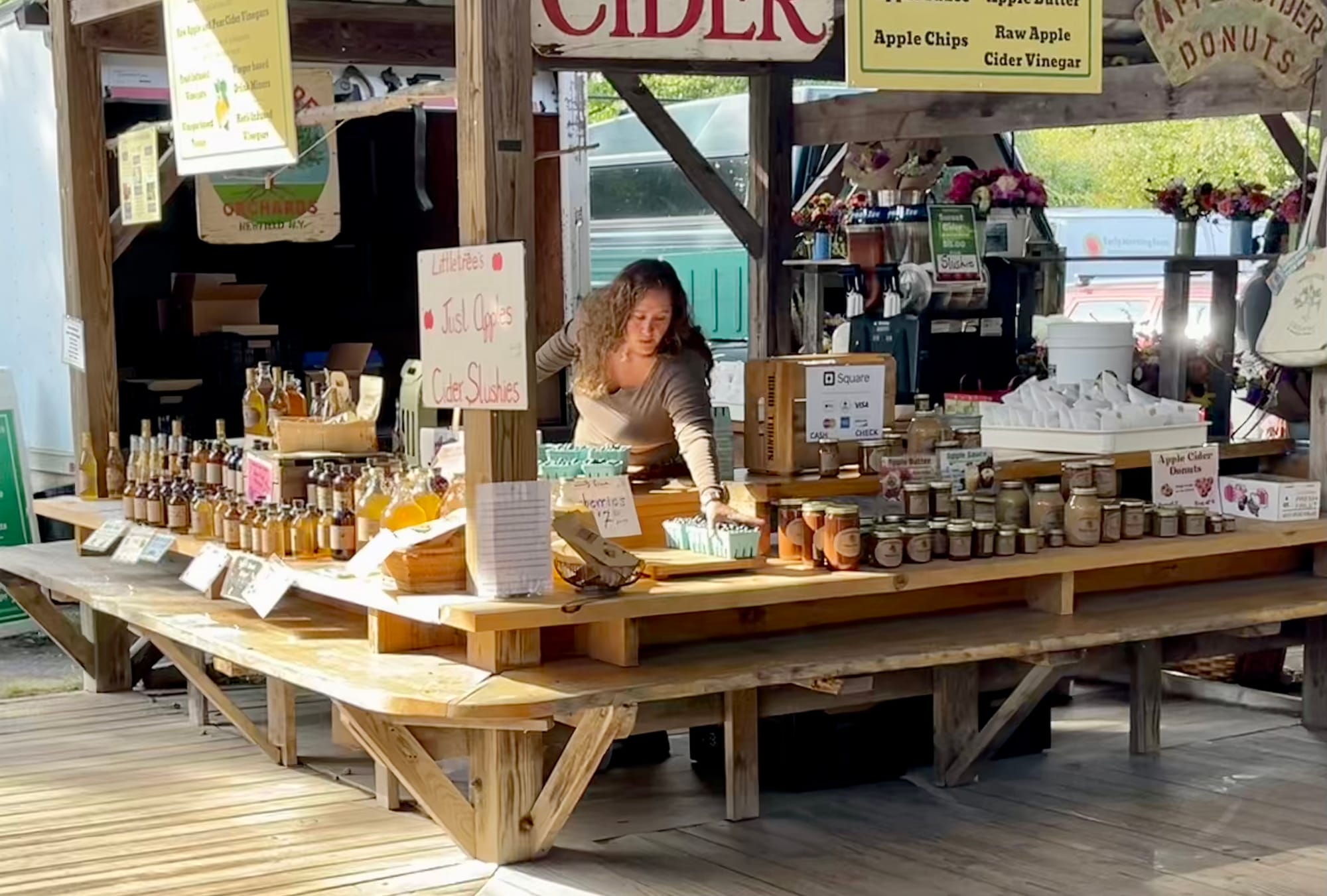
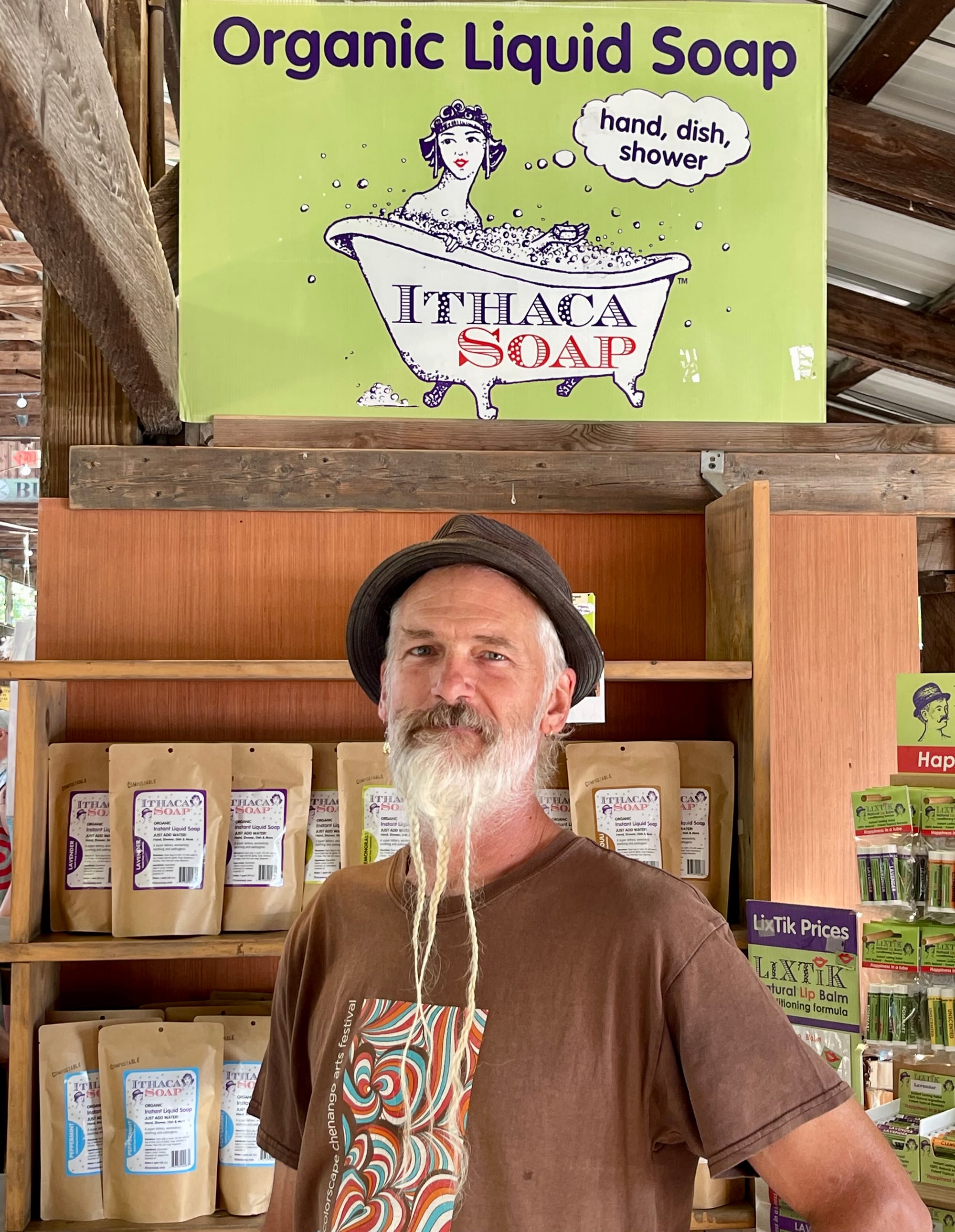
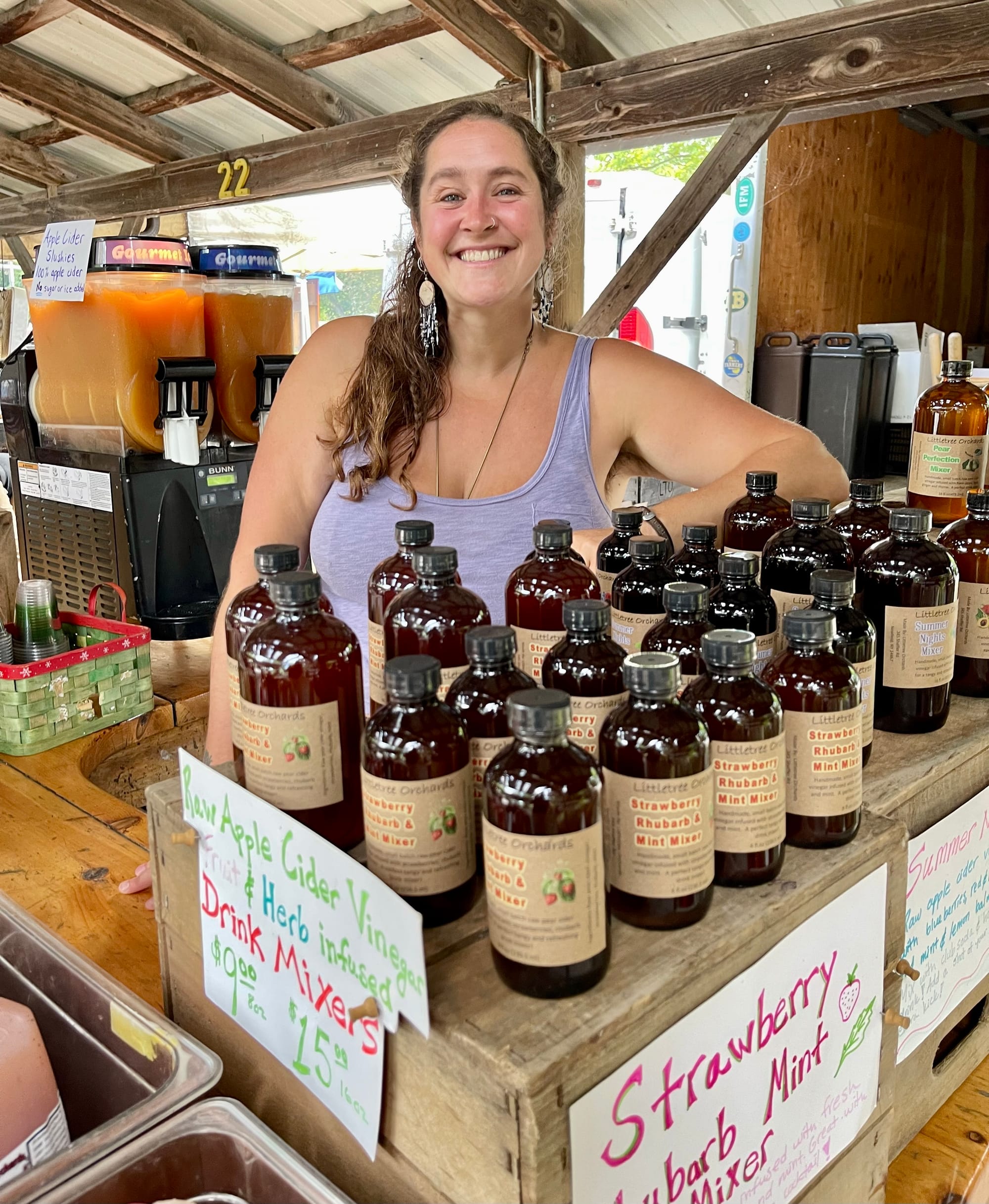
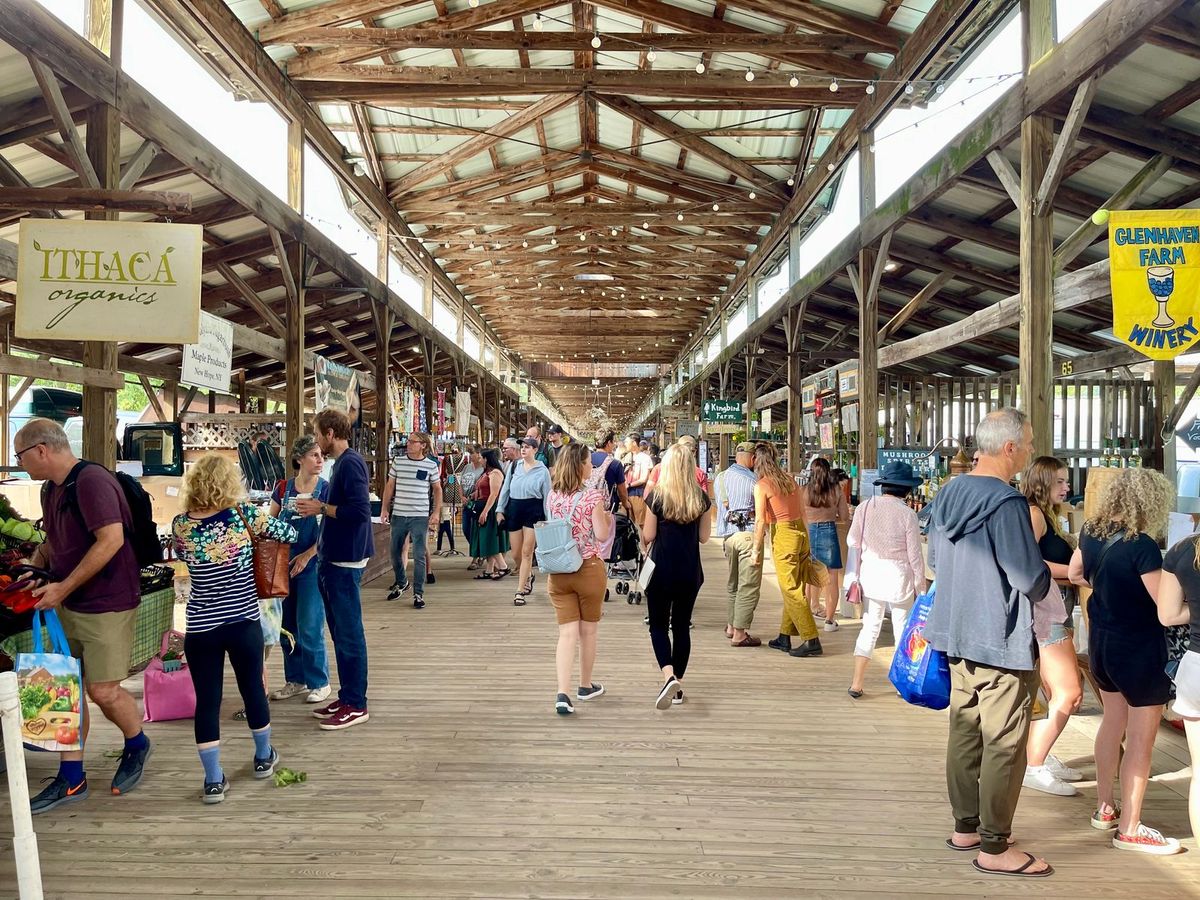
More Double Loading Around The World
Paris
Paris is a city that feels like it's designed for social life. Everywhere you look, there are cafés and public squares and people chatting outside. One of the main reasons it's such a great city in which to connect and gather is because its sidewalks are frequently double-loaded, even the narrowest ones. Paris understands how valuable sidewalk space is and makes the most of it.
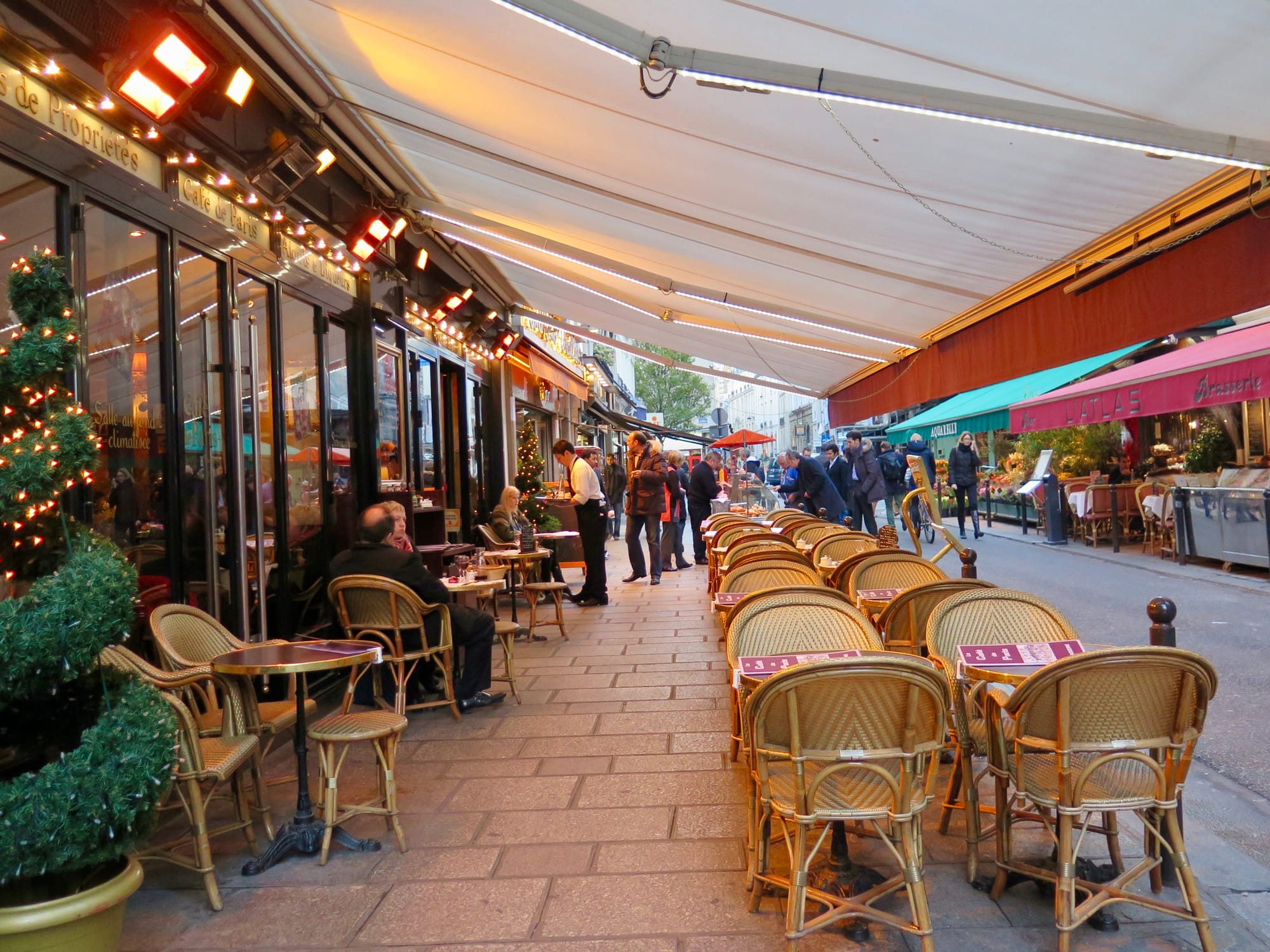
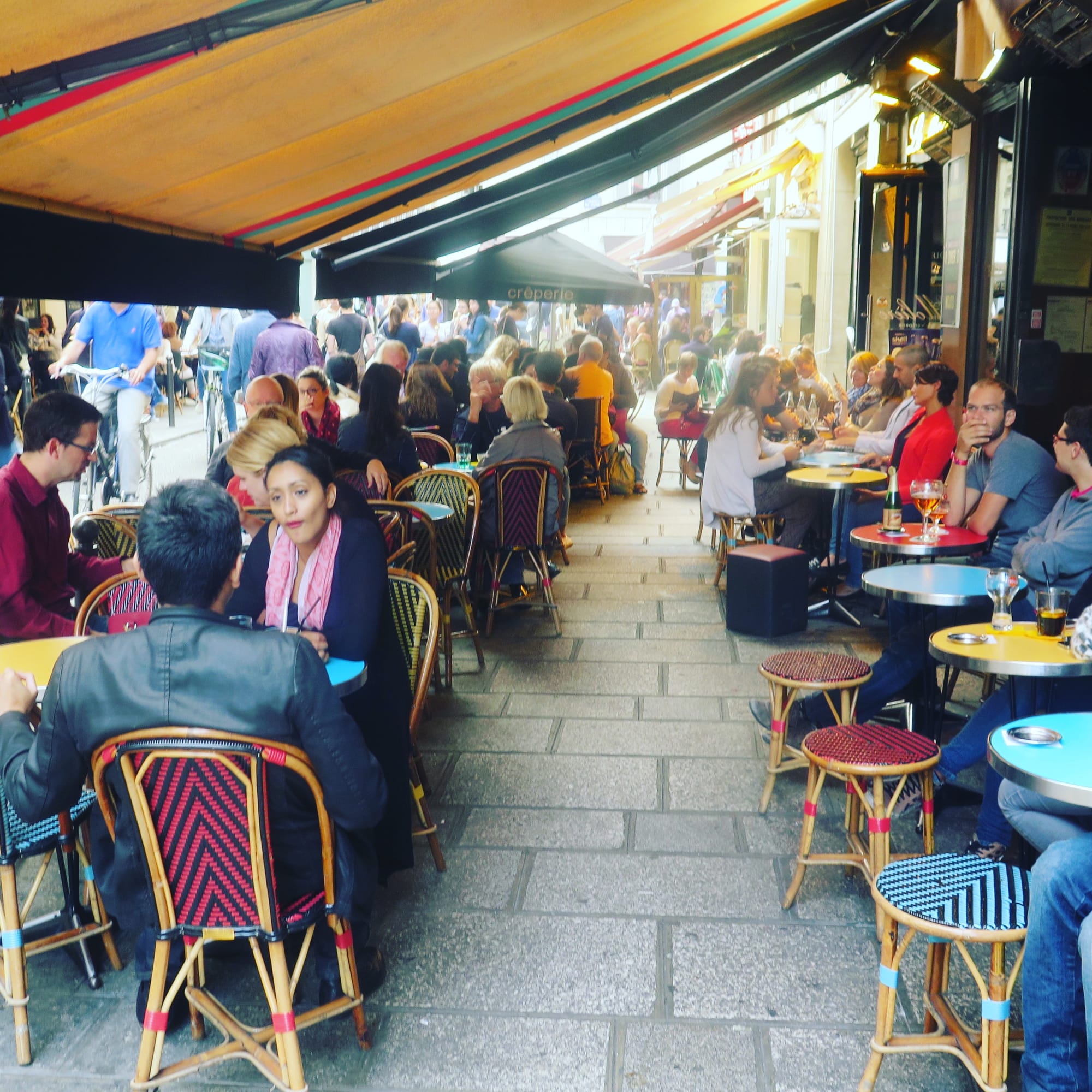
In Paris, this double-loaded sidewalk adds another layer to an already double-loaded street.
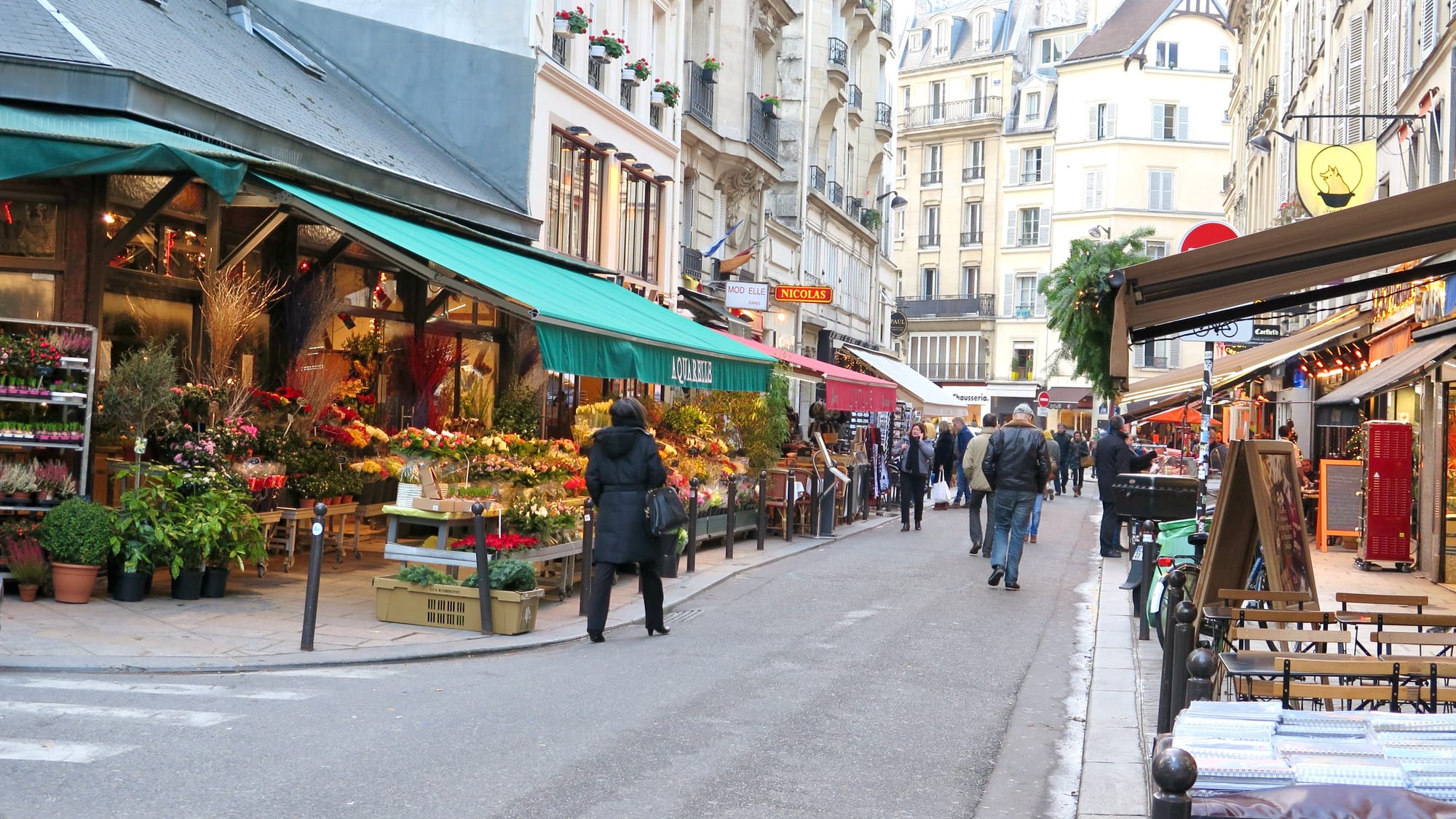


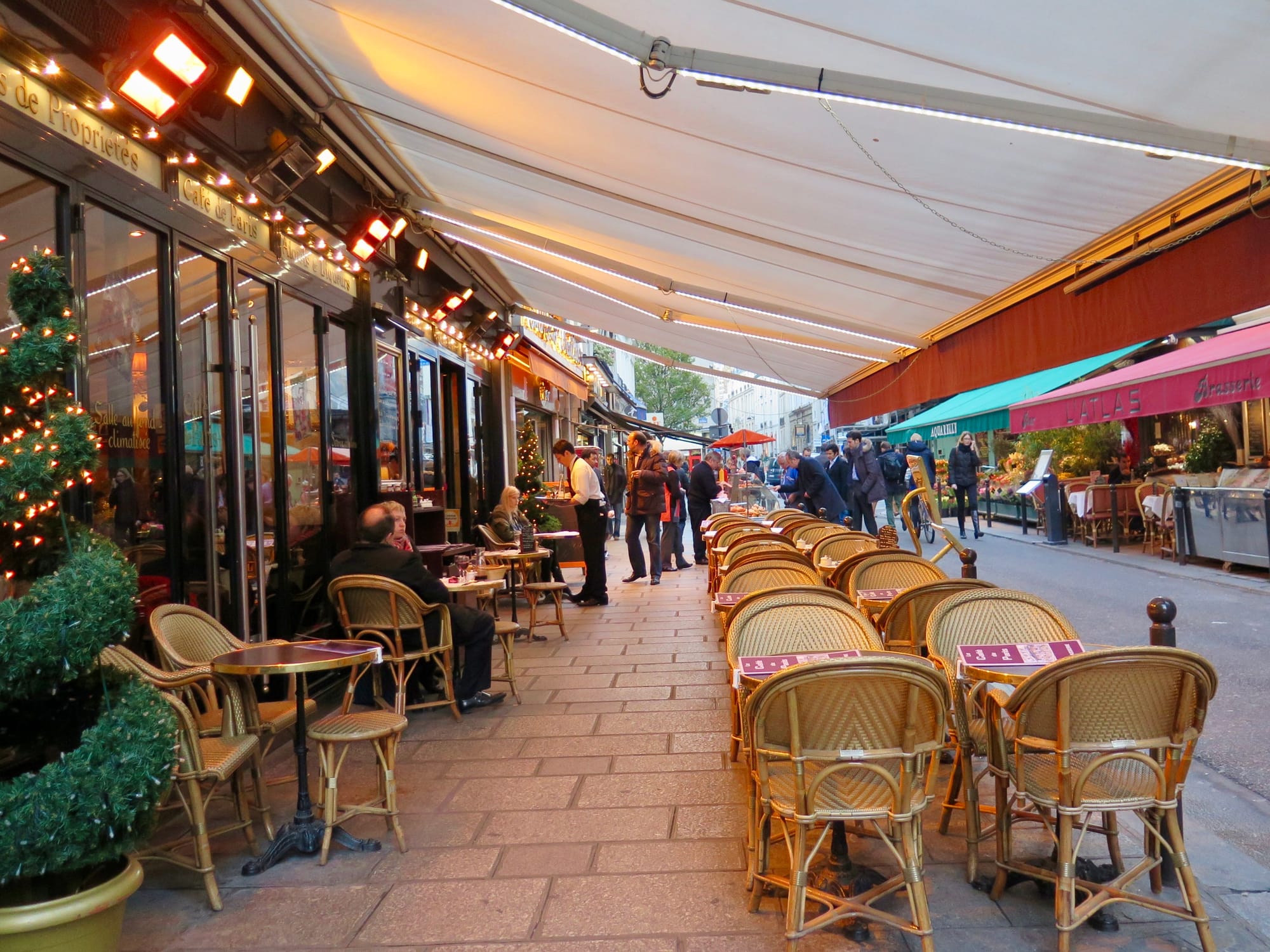
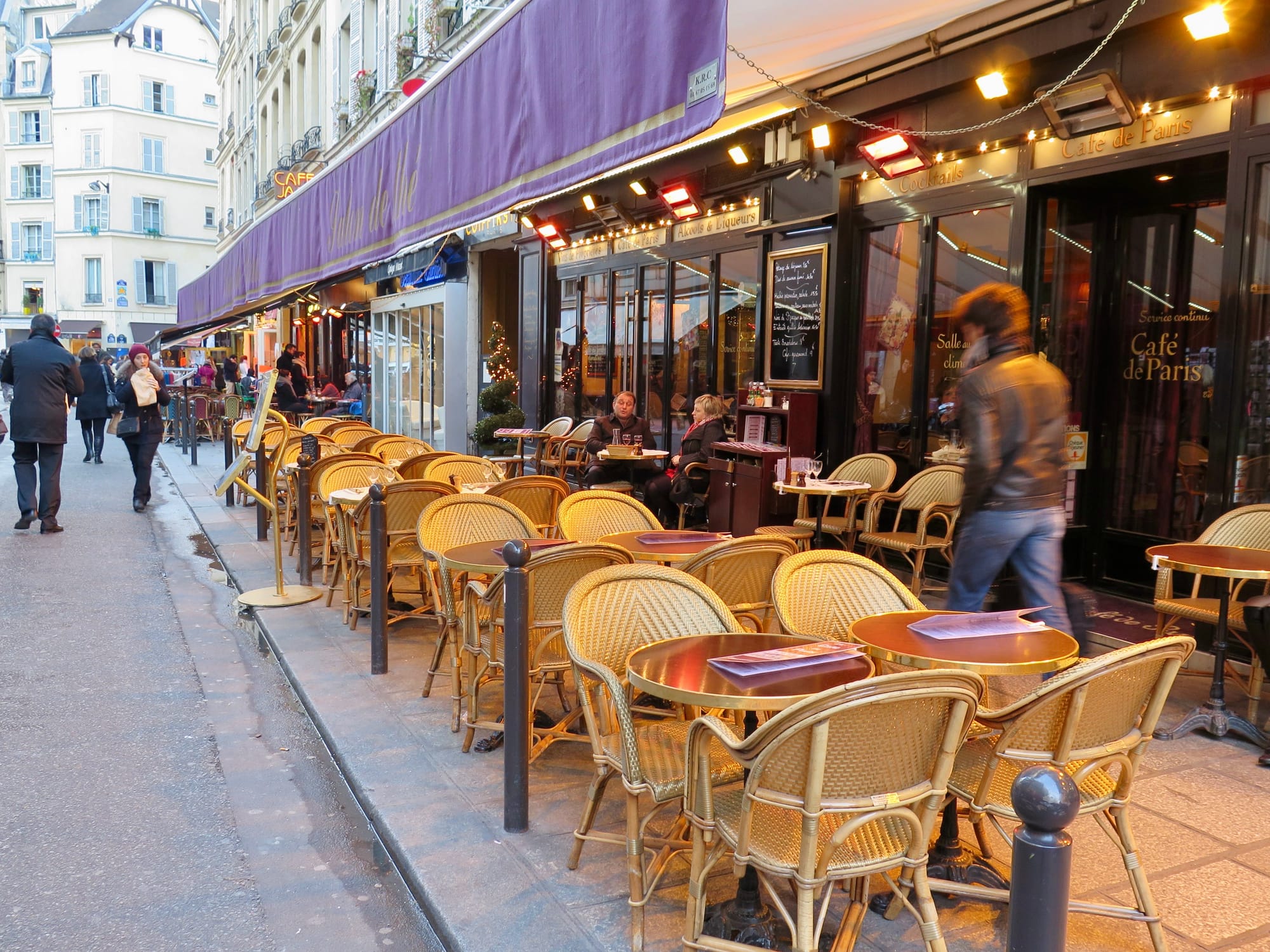
Pedestrians can shop or eat on either side of this sidewalk.
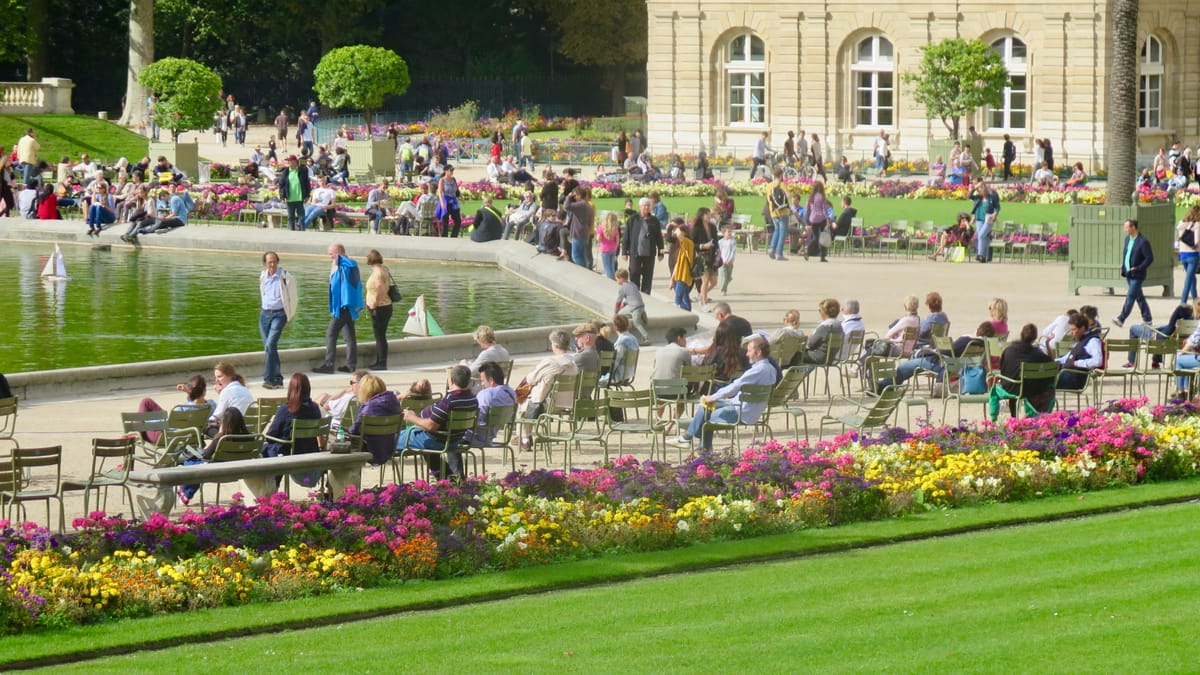
Istanbul
In a historic city such as Istanbul, one gets the sense that the narrow streets and vendors have been in the same place for decades, if not centuries. Its market streets are overflowing with goods from every stall and storefront, filling the streets with sights and smells that make the senses come alive.
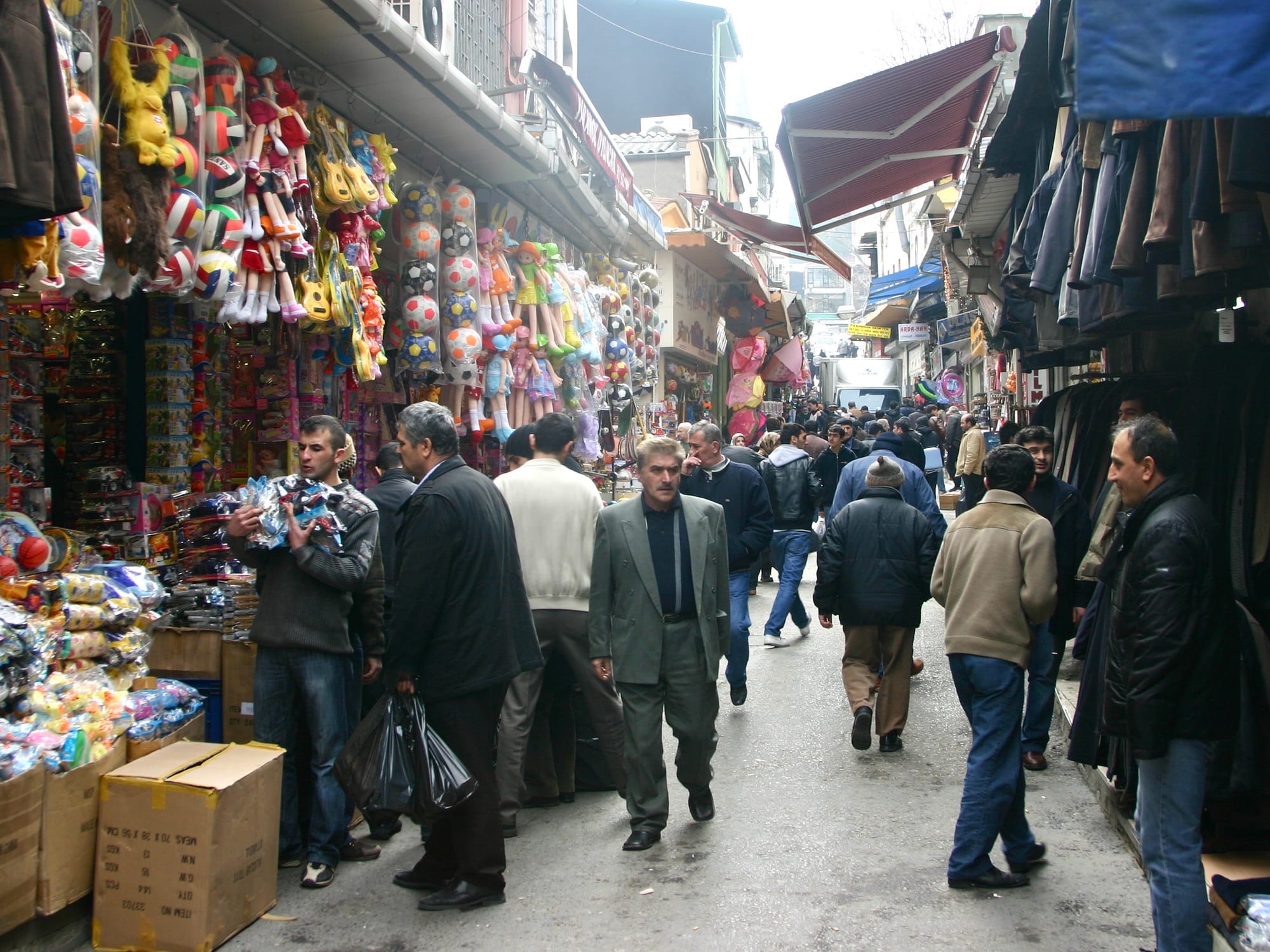
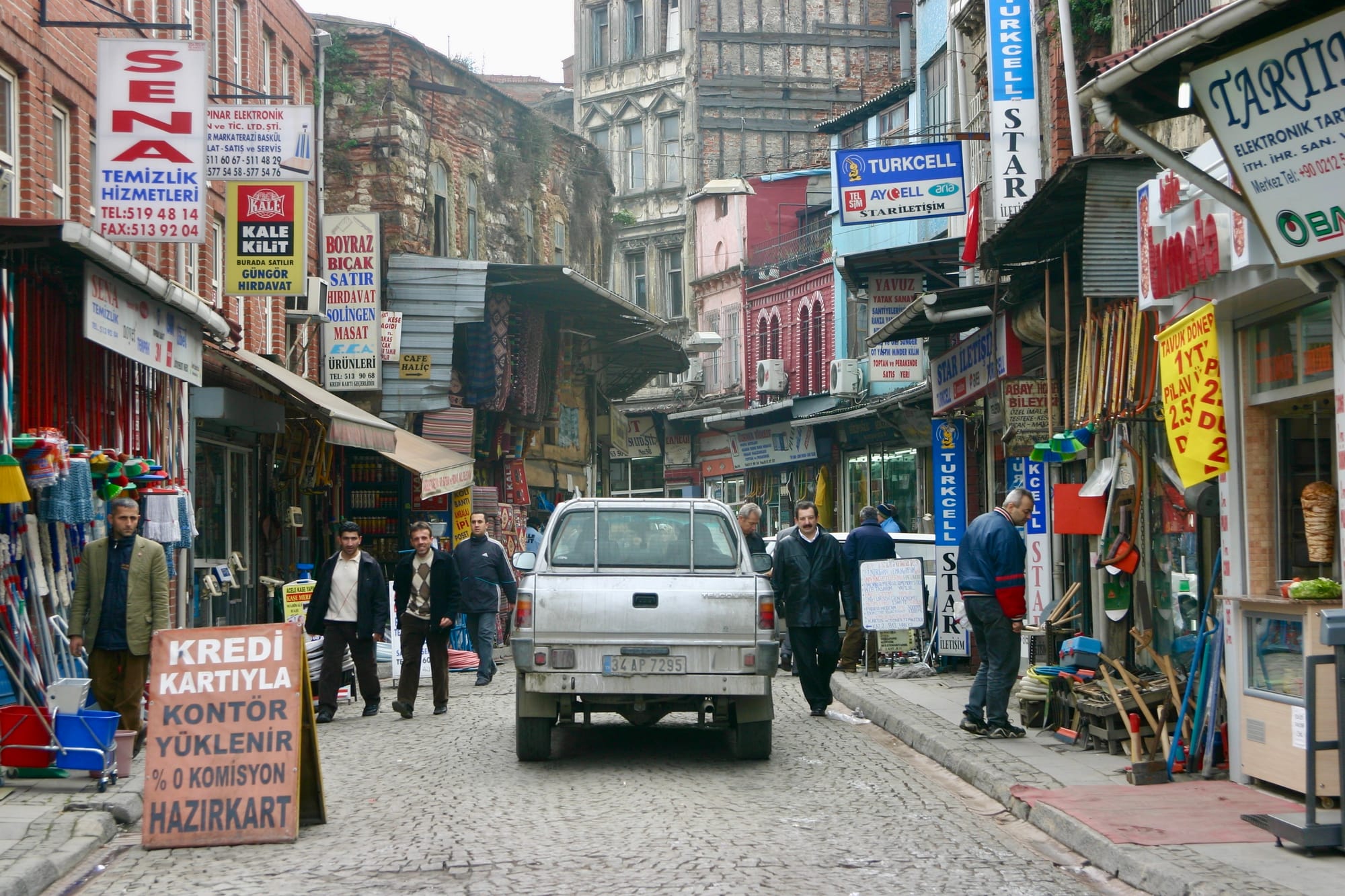
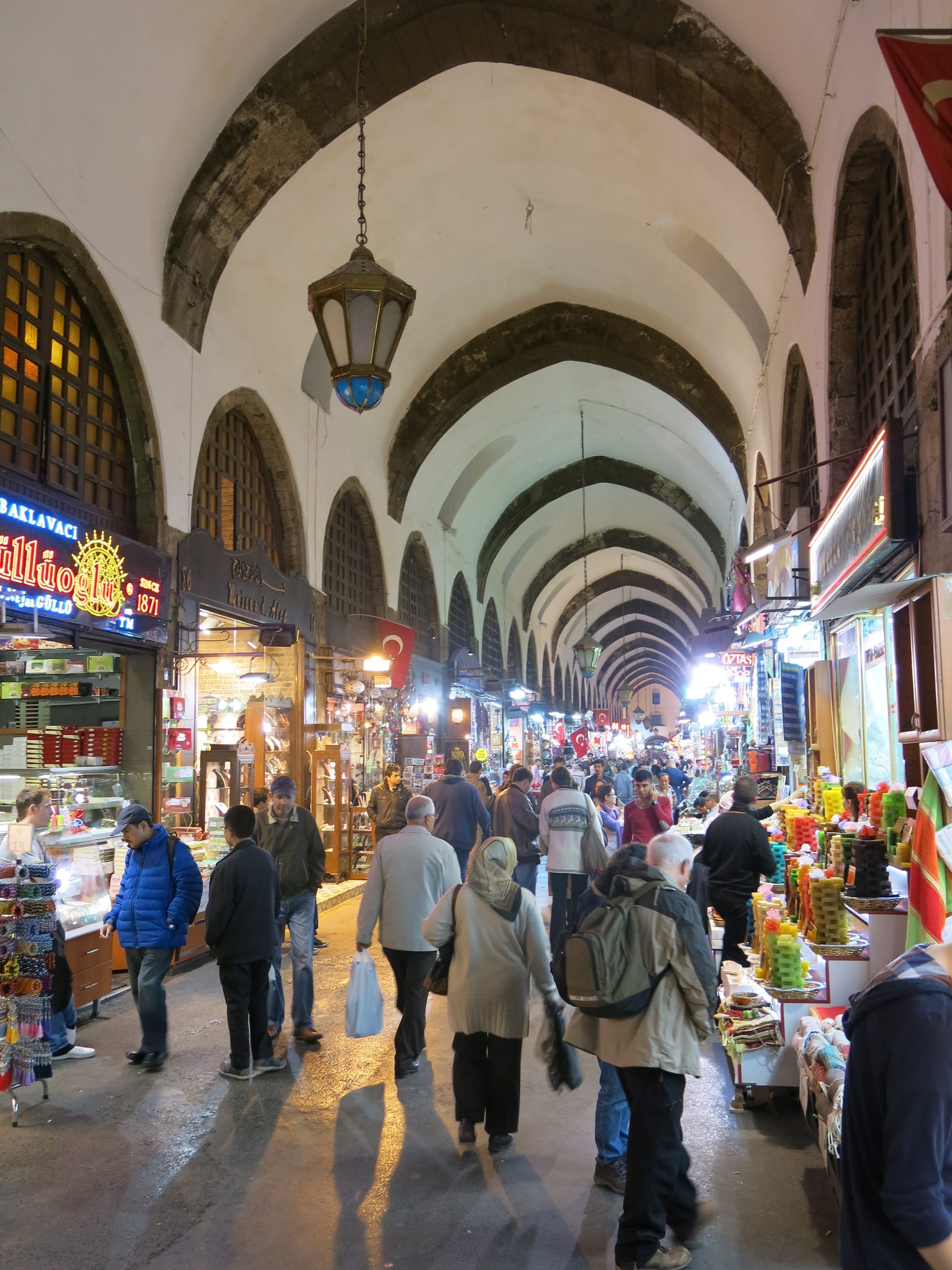
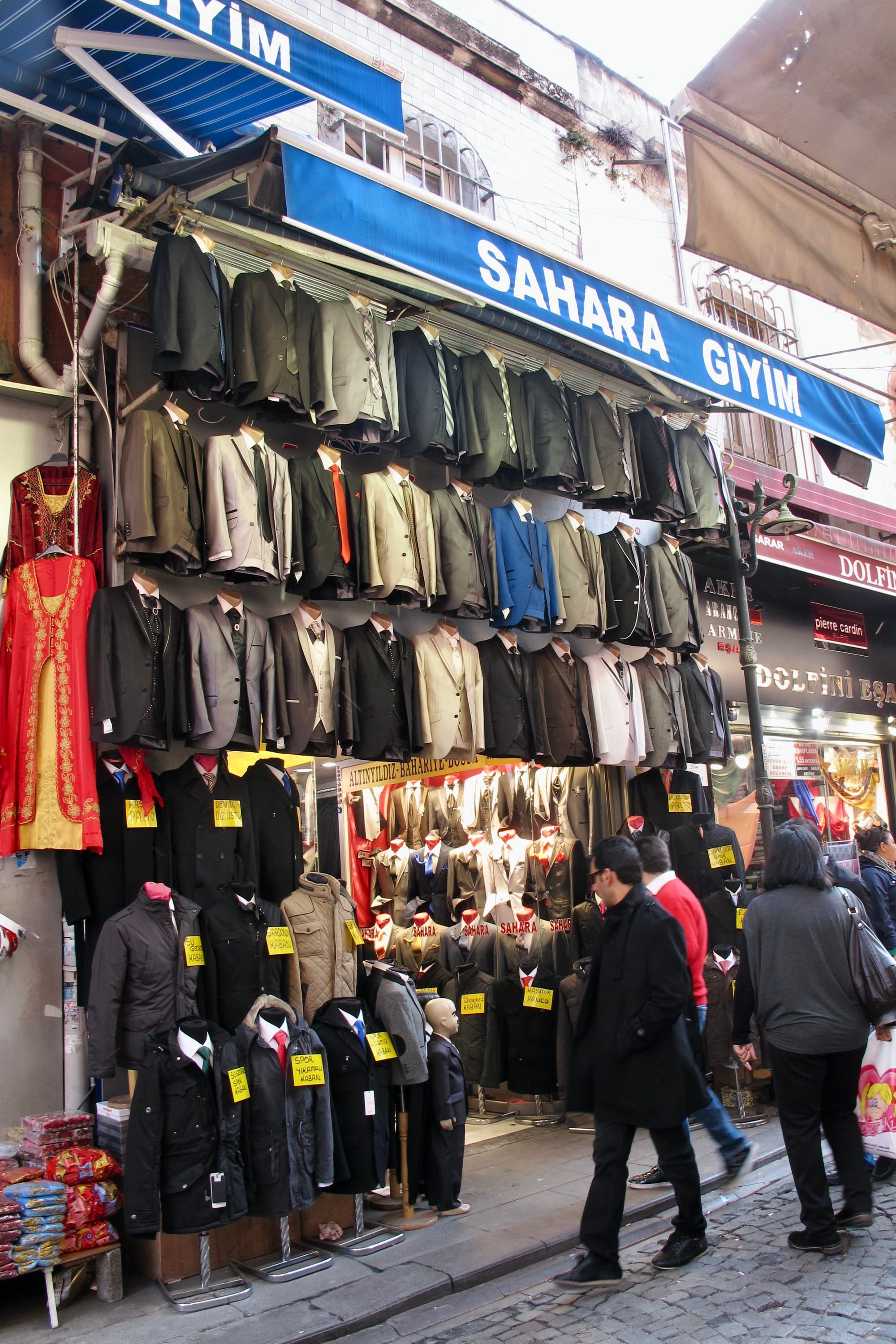
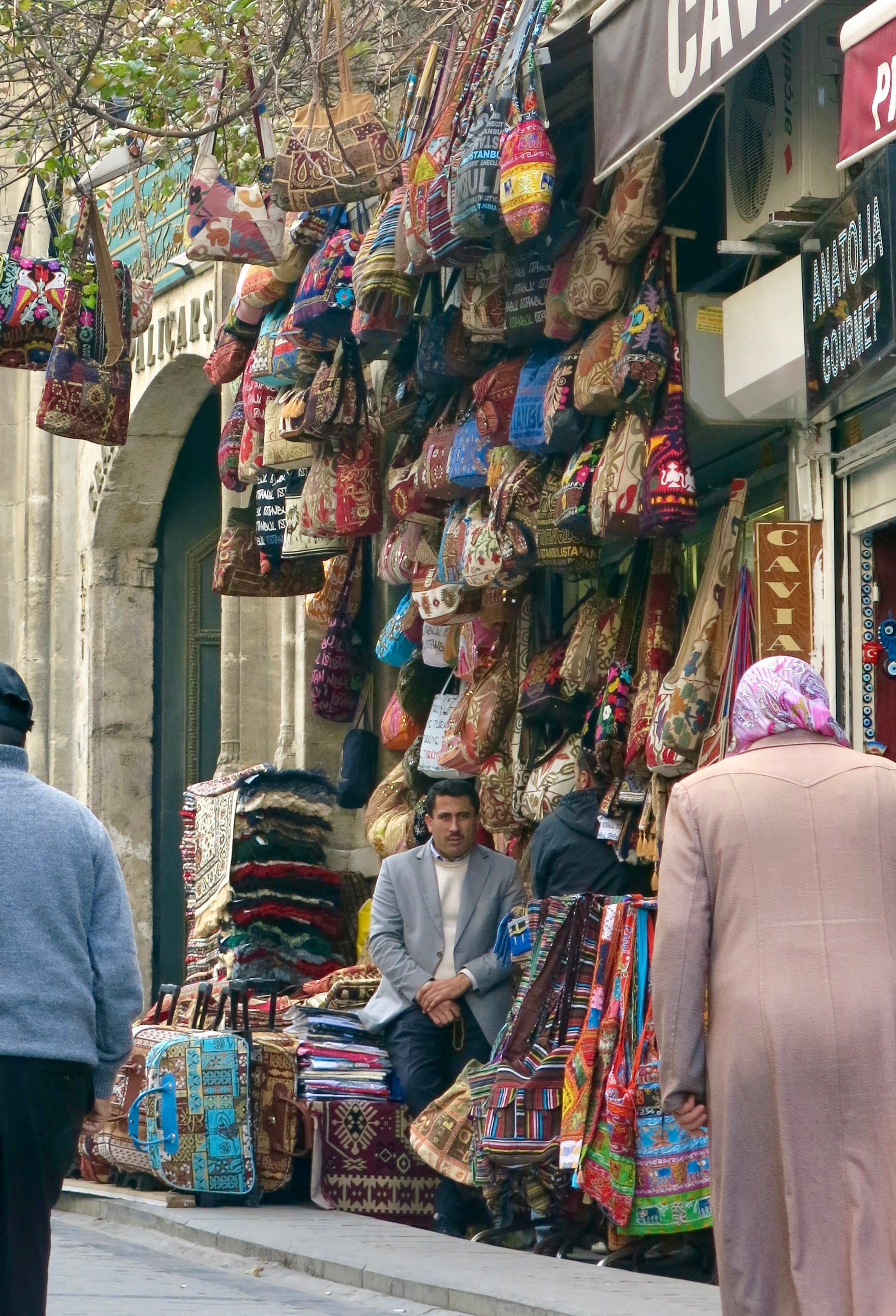
Gdansk
Amber Street in Gdansk was formerly a street where the wealthy lived. Each building had multiple ways to enter, with the upper level being for families and the lower level for servants. The sidewalk/street there was formerly for carriages. Today, it is a wonderful double-loaded street with layers of activations from every direction.
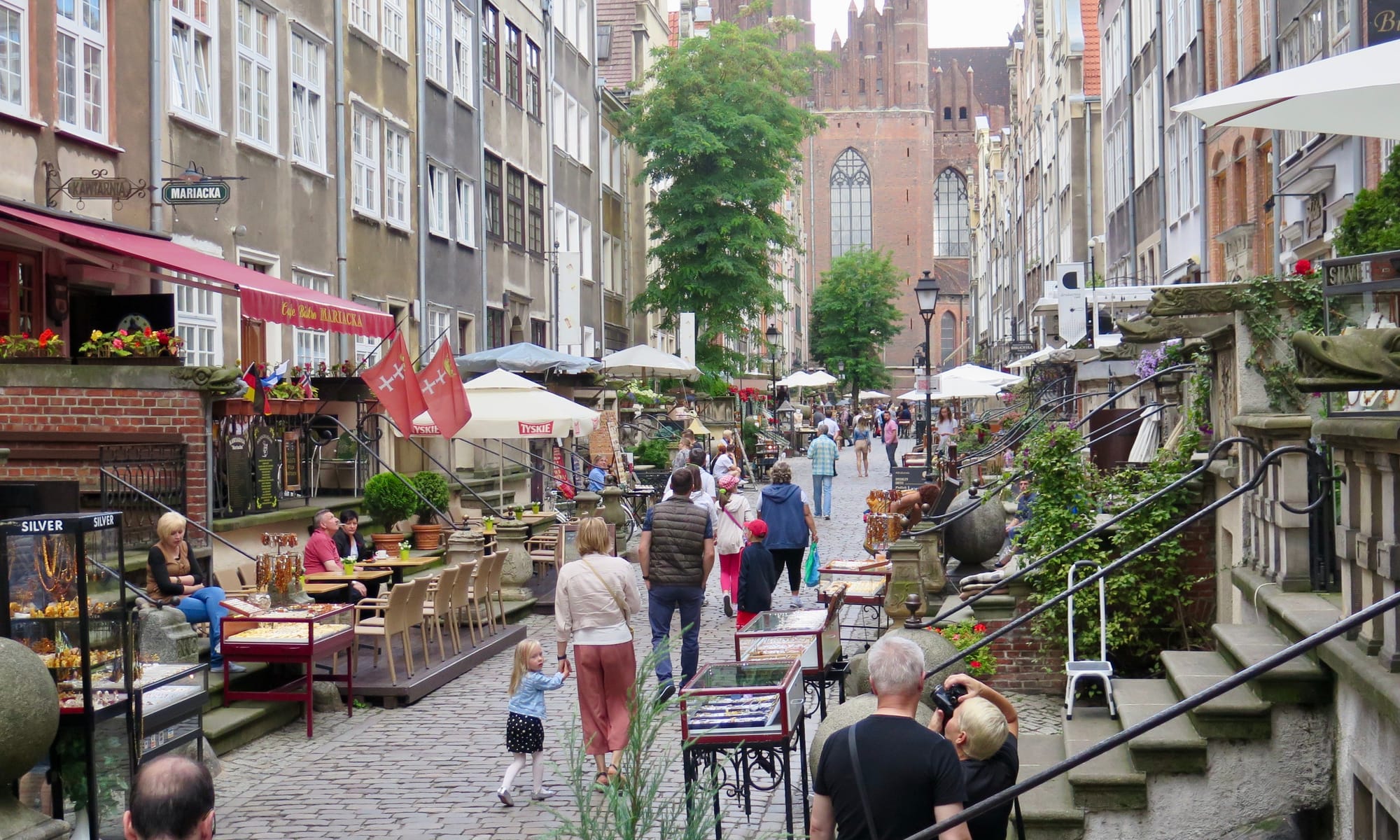
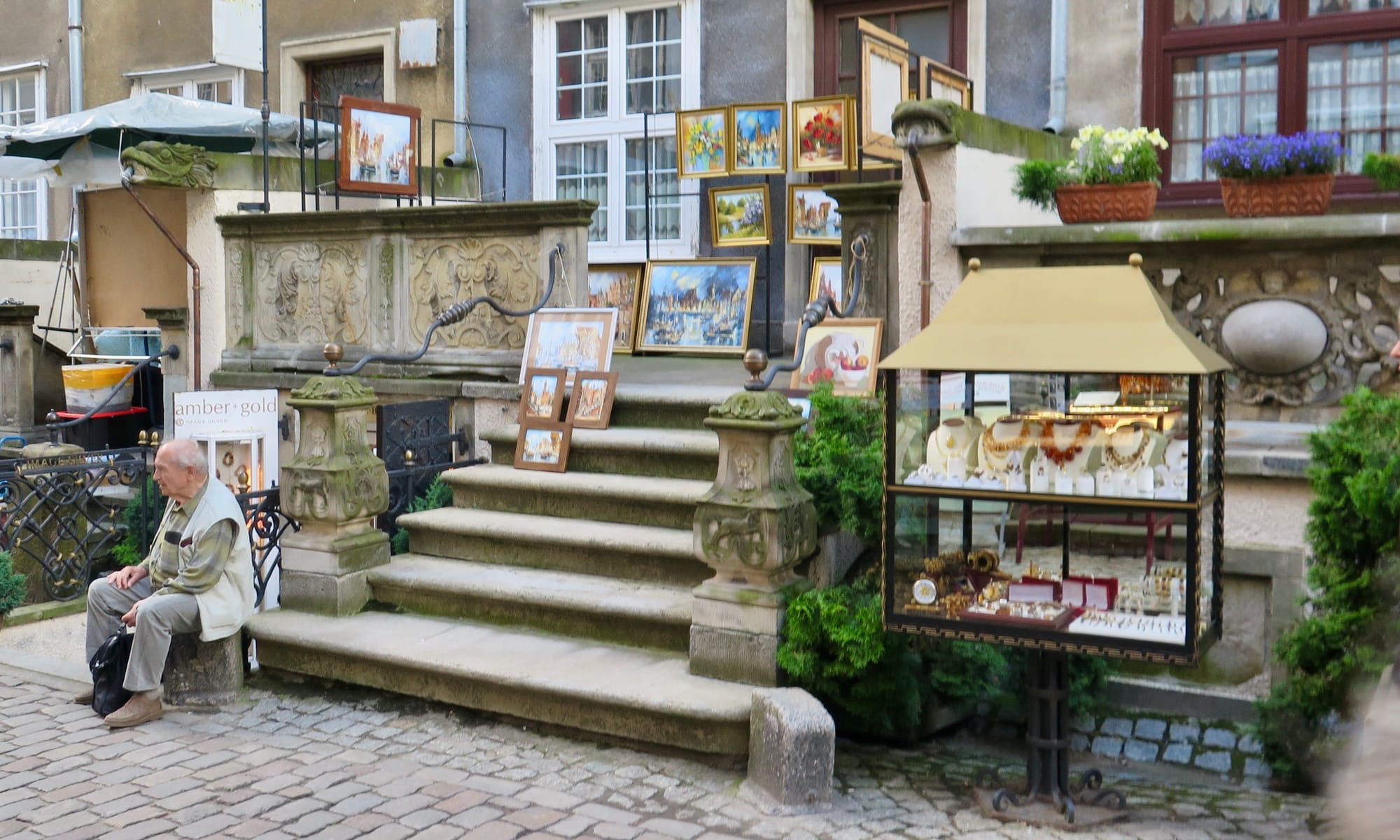
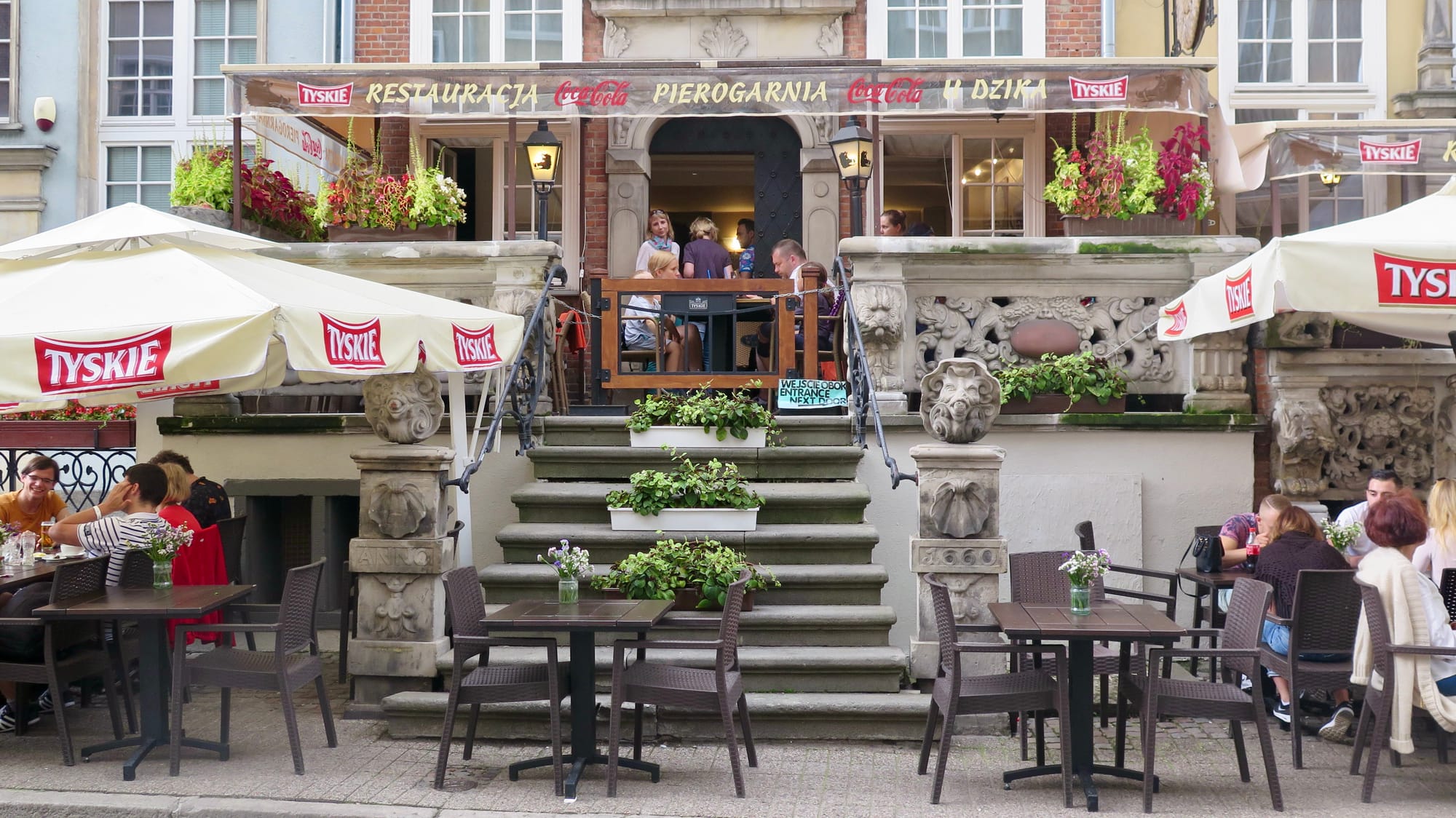
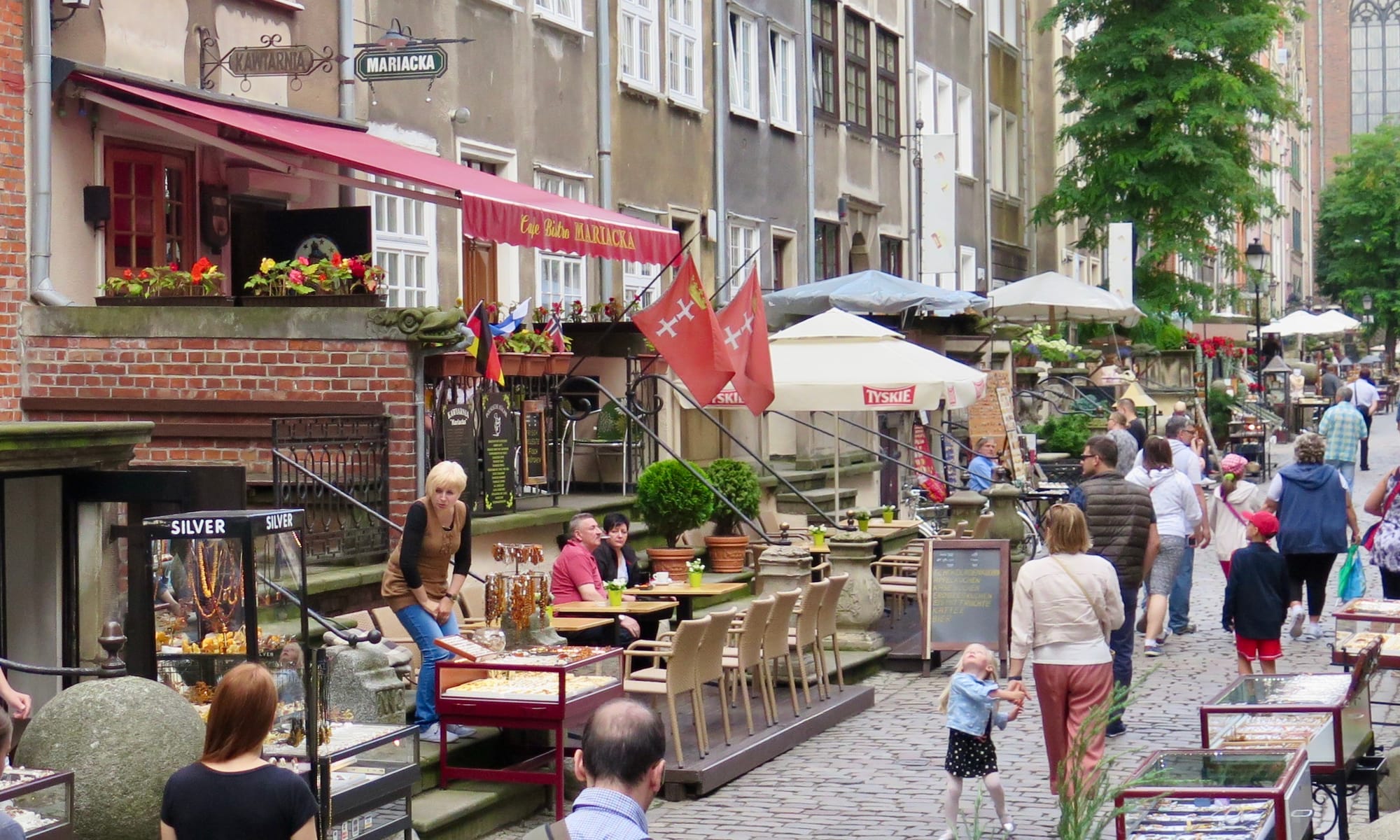
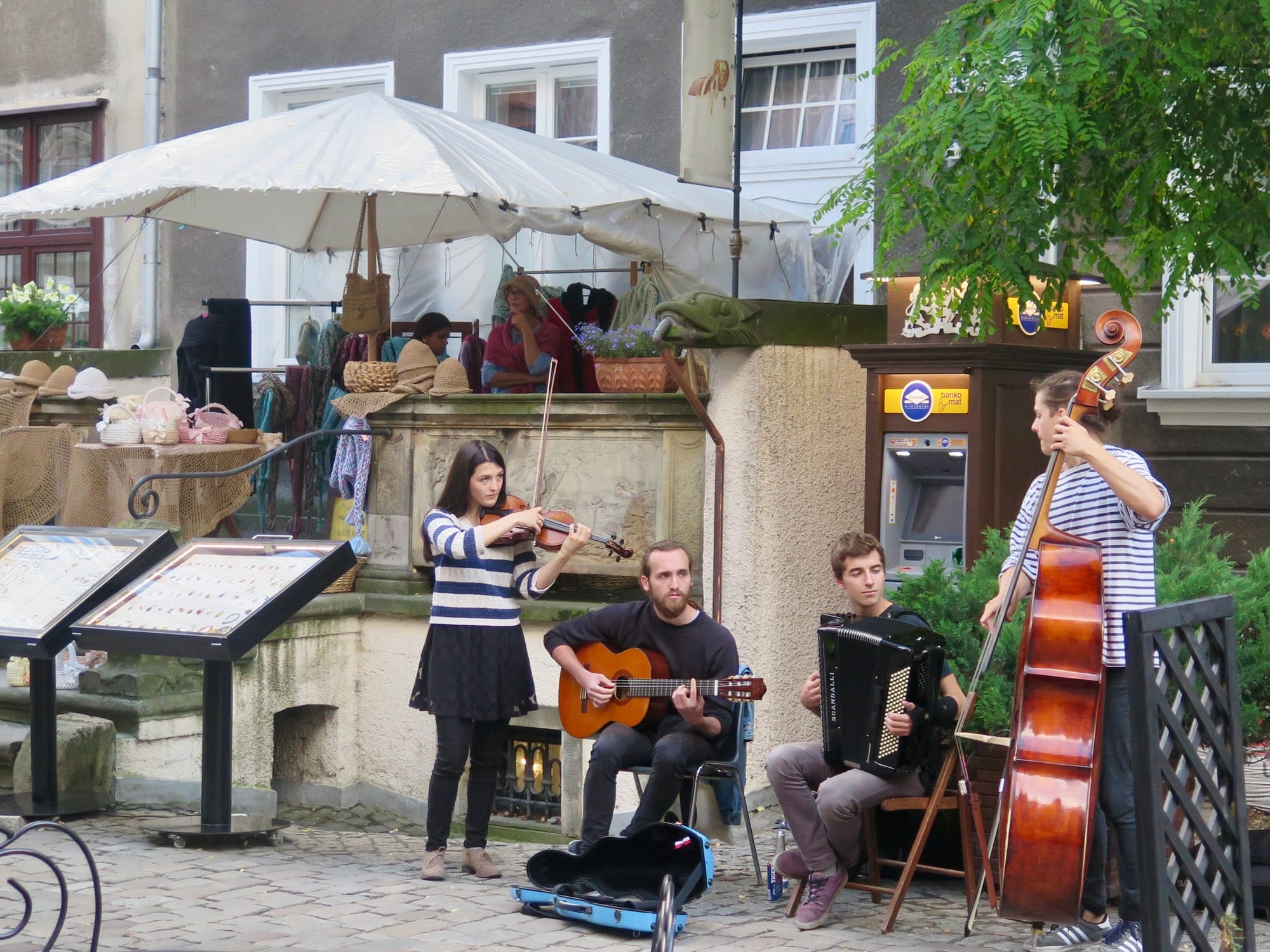
Now, these sidewalks are constantly filled with activities to create one of the great shopping and walking streets in the world.
Miami
Miami Beach's Ocean Drive is always a party. There are so many great places to sit, talk, and have fun, in large part because of how vibrant the sidewalks are. With coverings to protect from the Florida sun, these street-side dining areas are some of the best destinations in Miami.
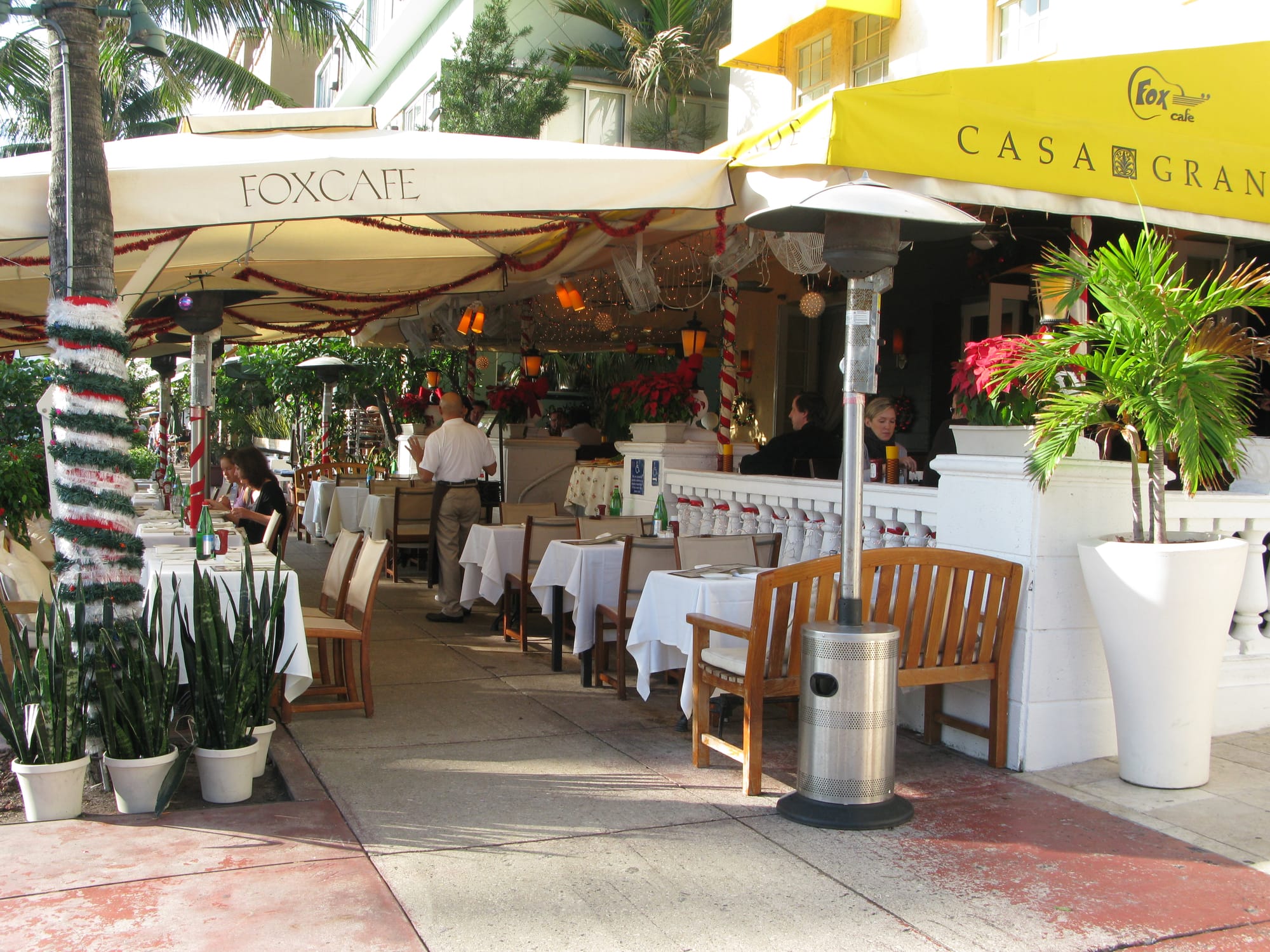
Brooklyn
Brooklyn created amazing examples of double loading when it was allowed to put up dining sheds on the street during the pandemic. These unique constructions created social hubs all along sidewalks, transforming dull car-centric streets into main streets where the community loved to gather.
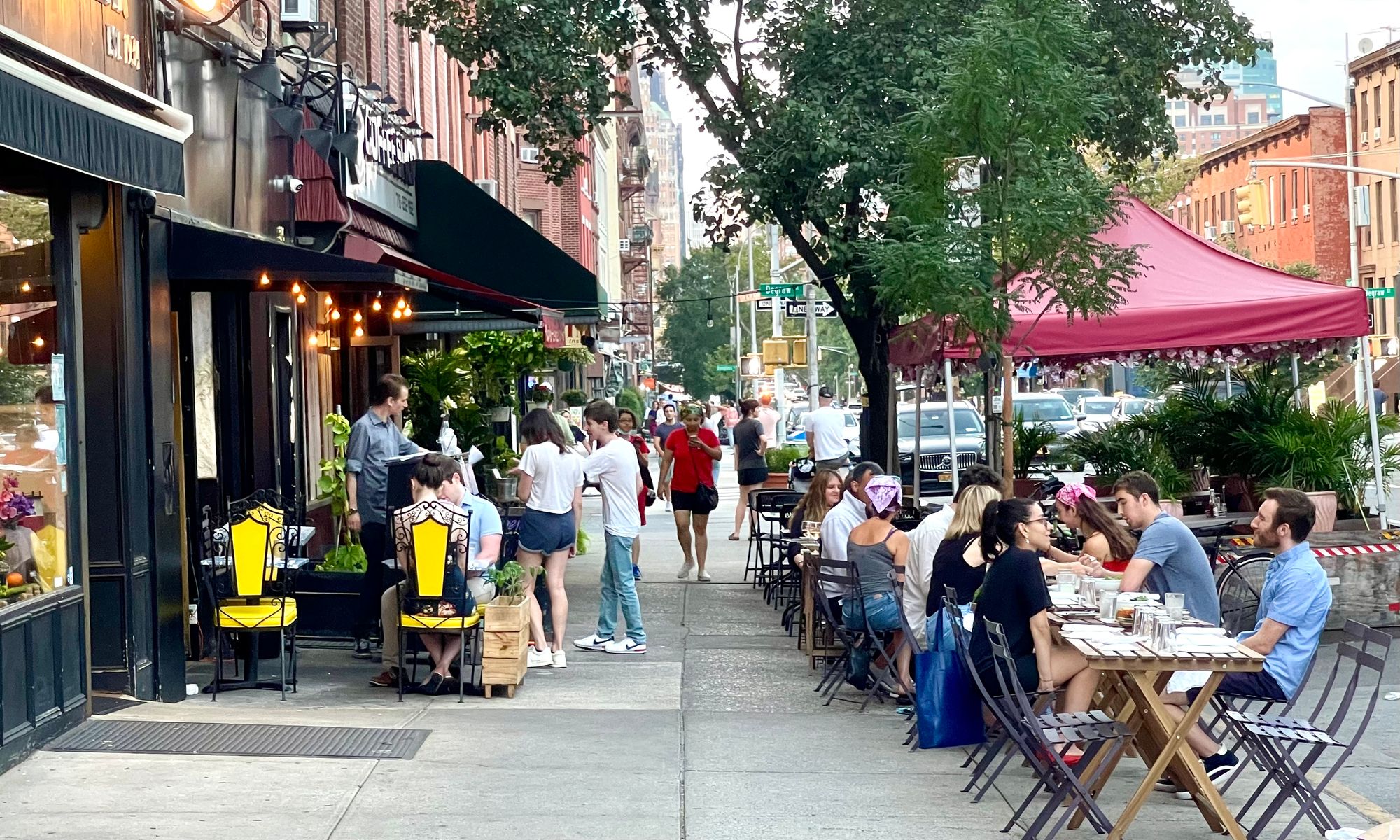
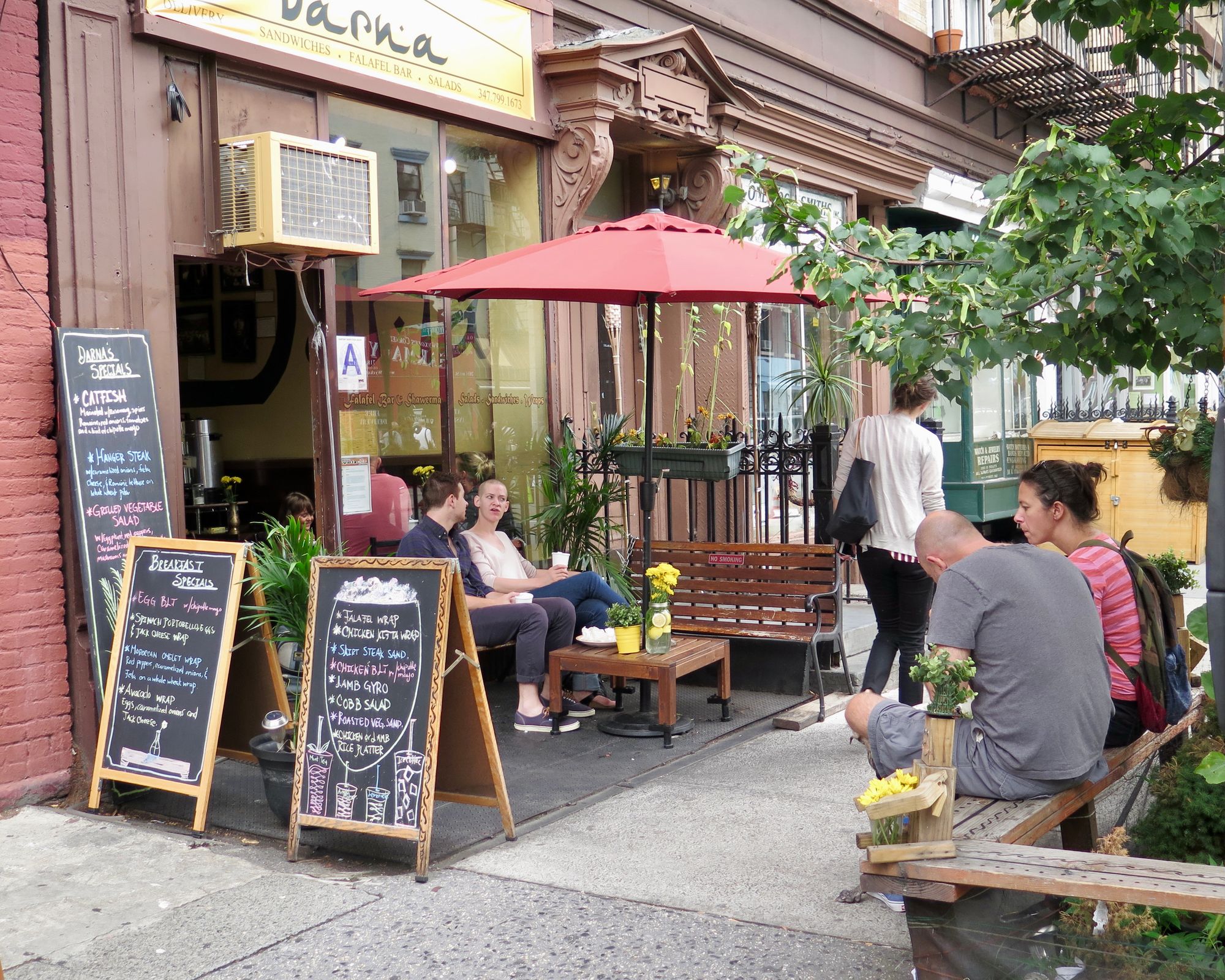
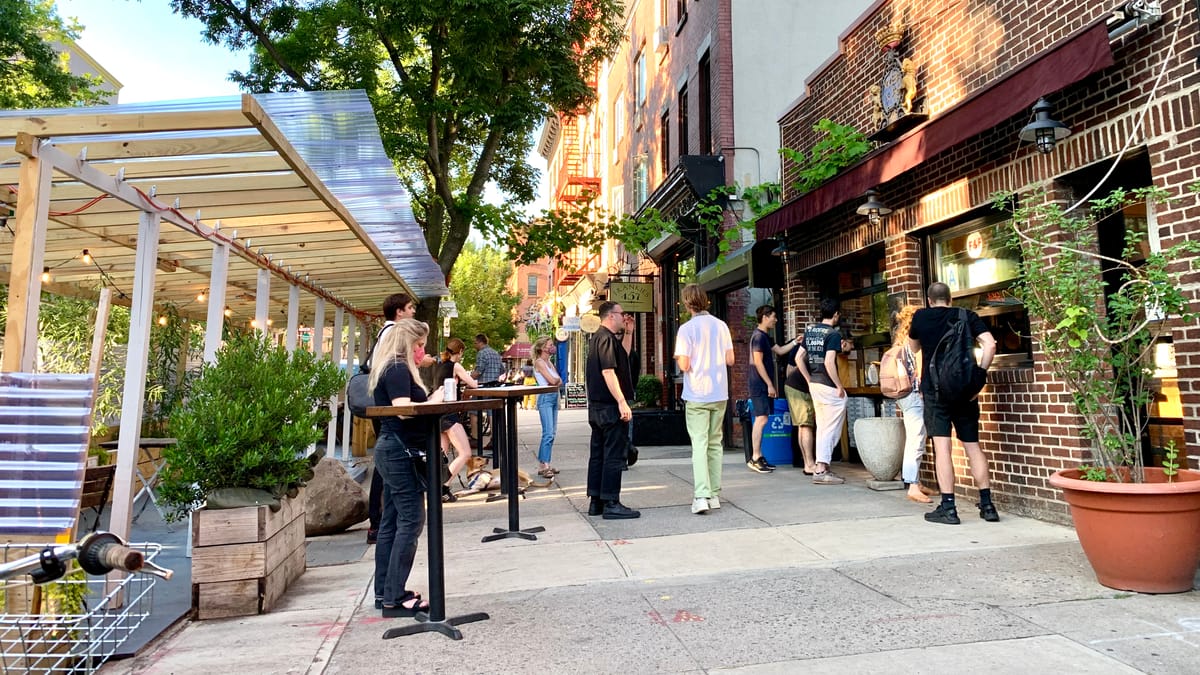
Rome
Rome's dining pavilions are reminiscent of NYC's dining sheds, creating extensions of restaurants and cafes on the sidewalks. Their closed design protects the outdoor dining areas from the elements, while their glass walls and open designs allow them to interact with sidewalk life.
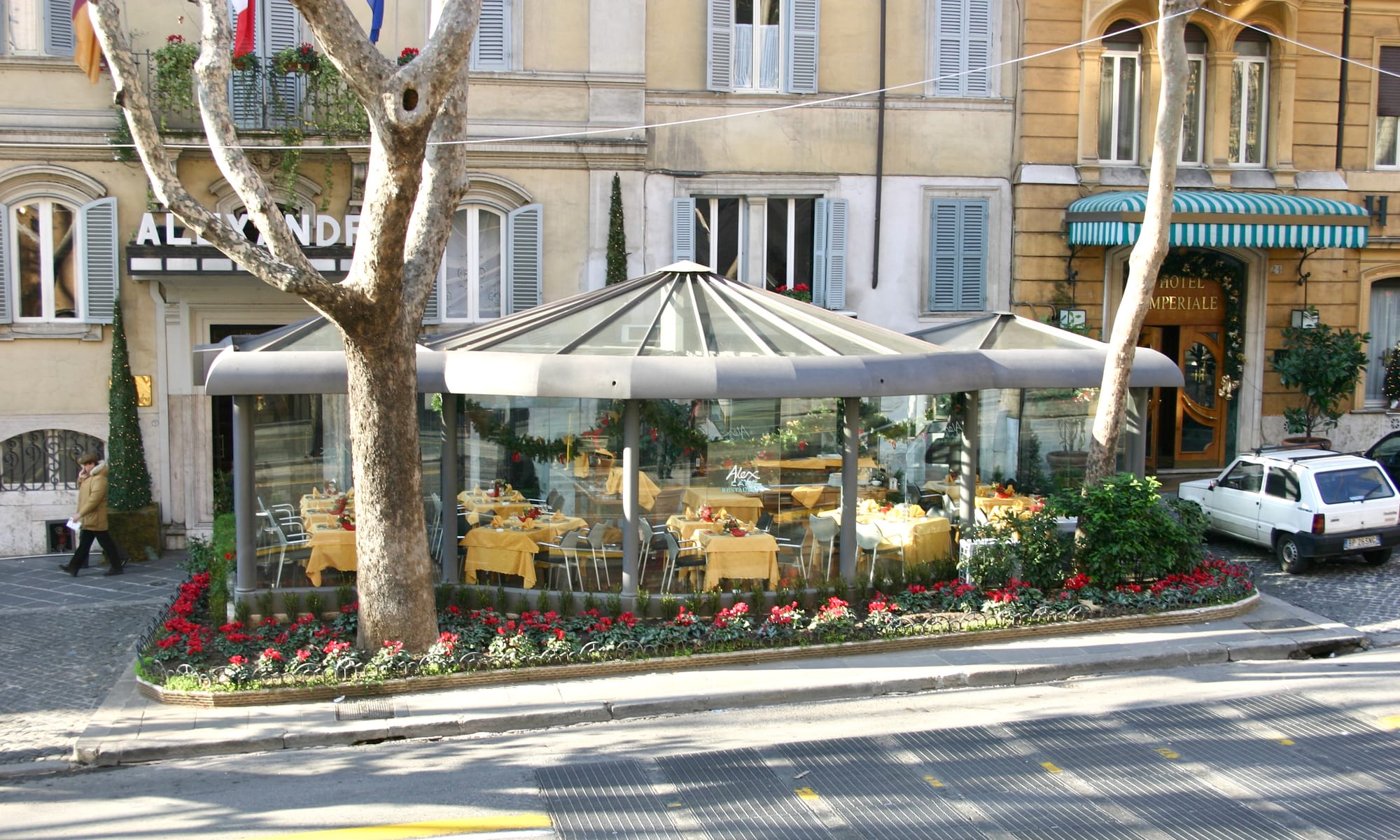
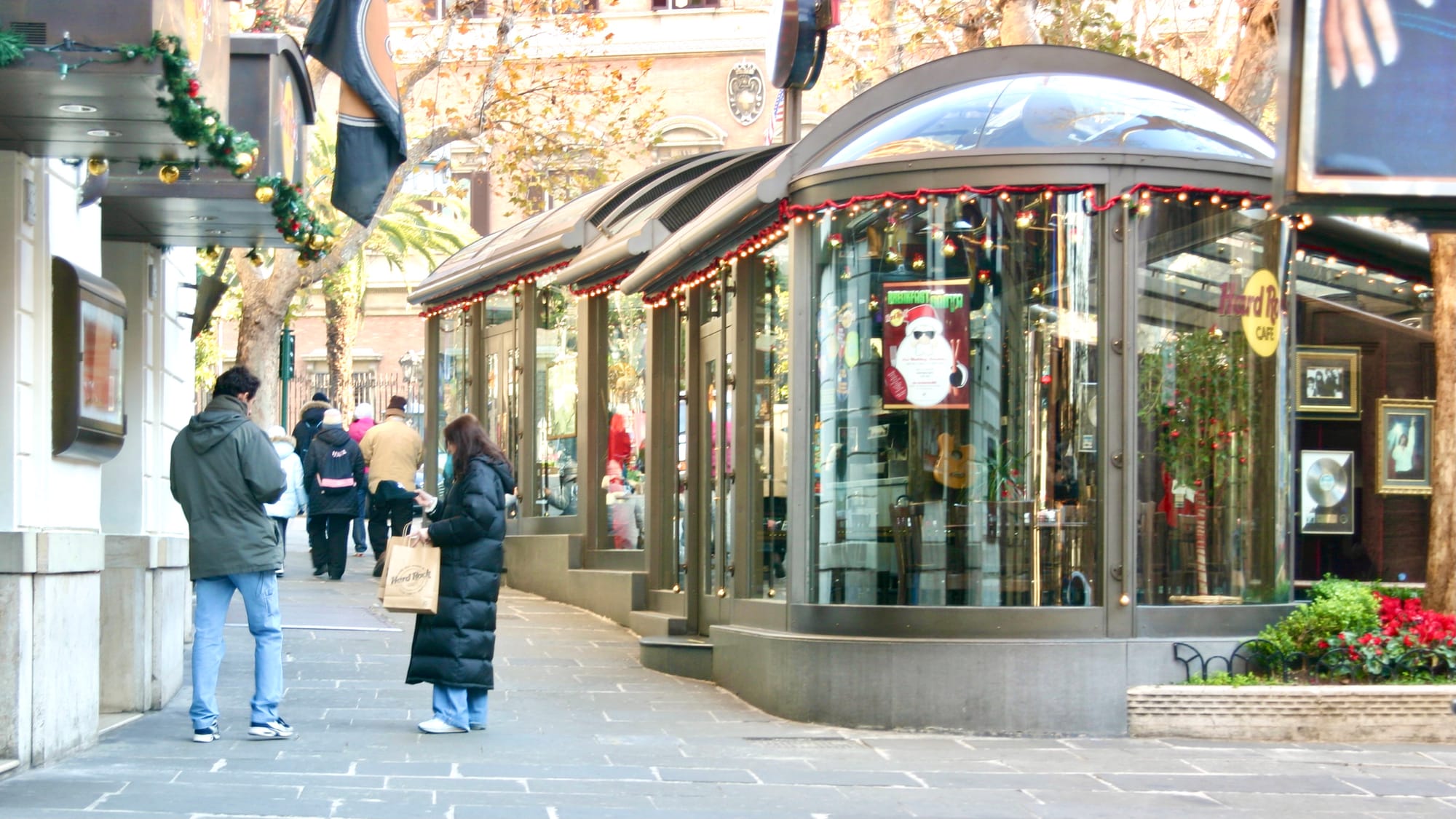
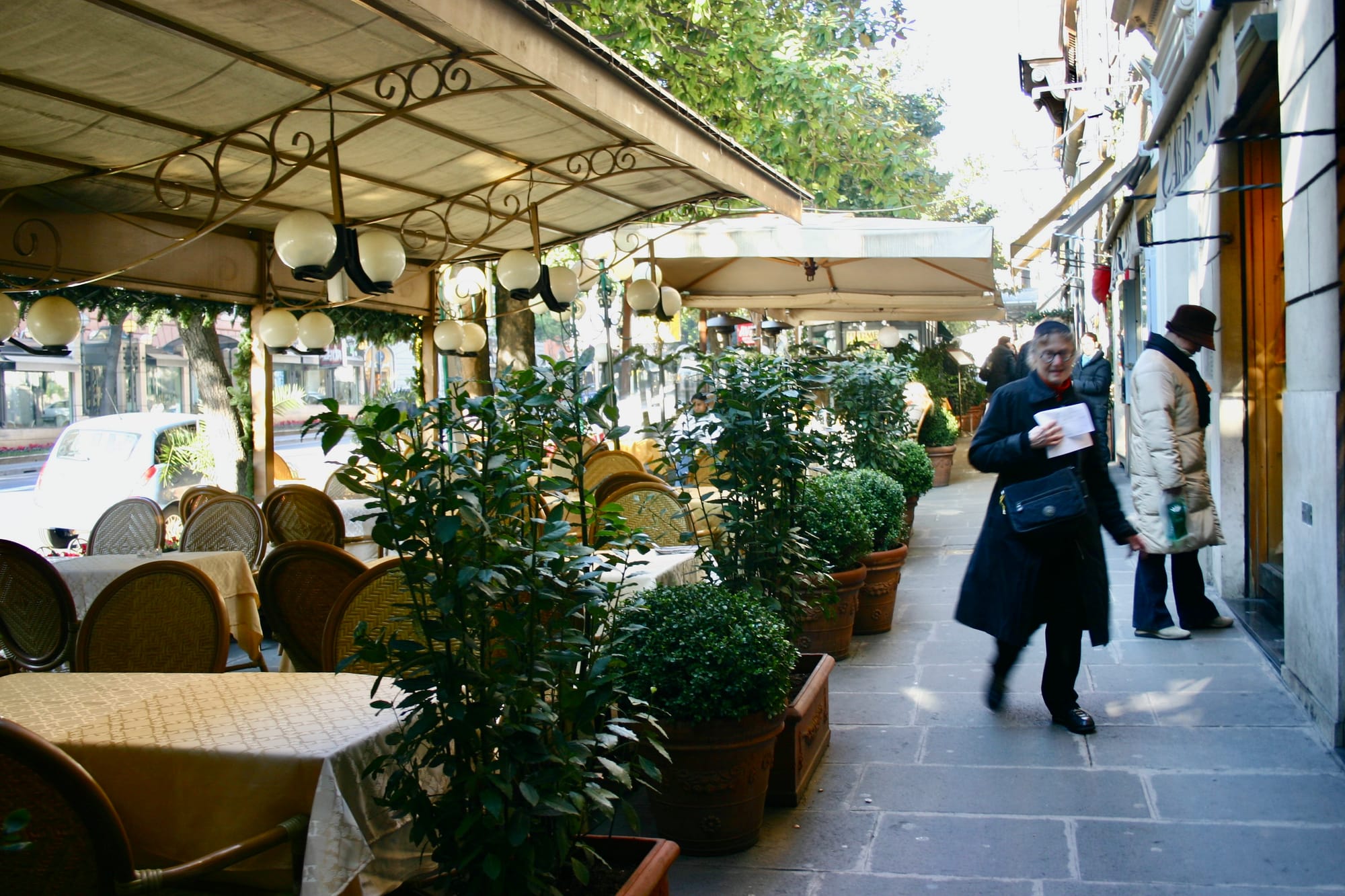
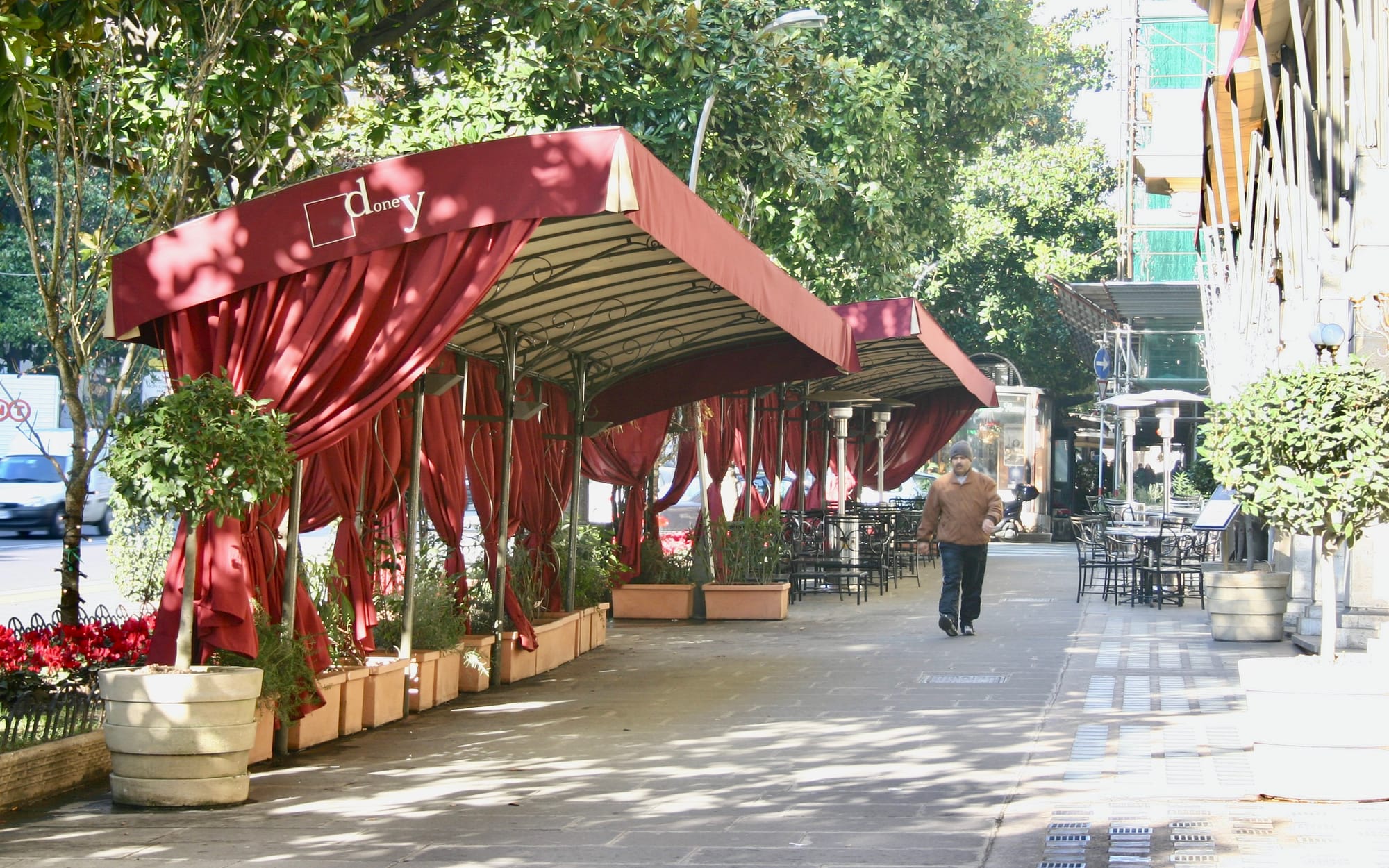
Saratoga Springs
This sidewalk on Saratoga's main street is 30 feet wide. One half is the walkway next to the buildings, and the other half is on the other side of the walkway – a 15-foot area for supporting activities on the grass. These sidewalks are some of the best in the US and offer a great example of double loading.
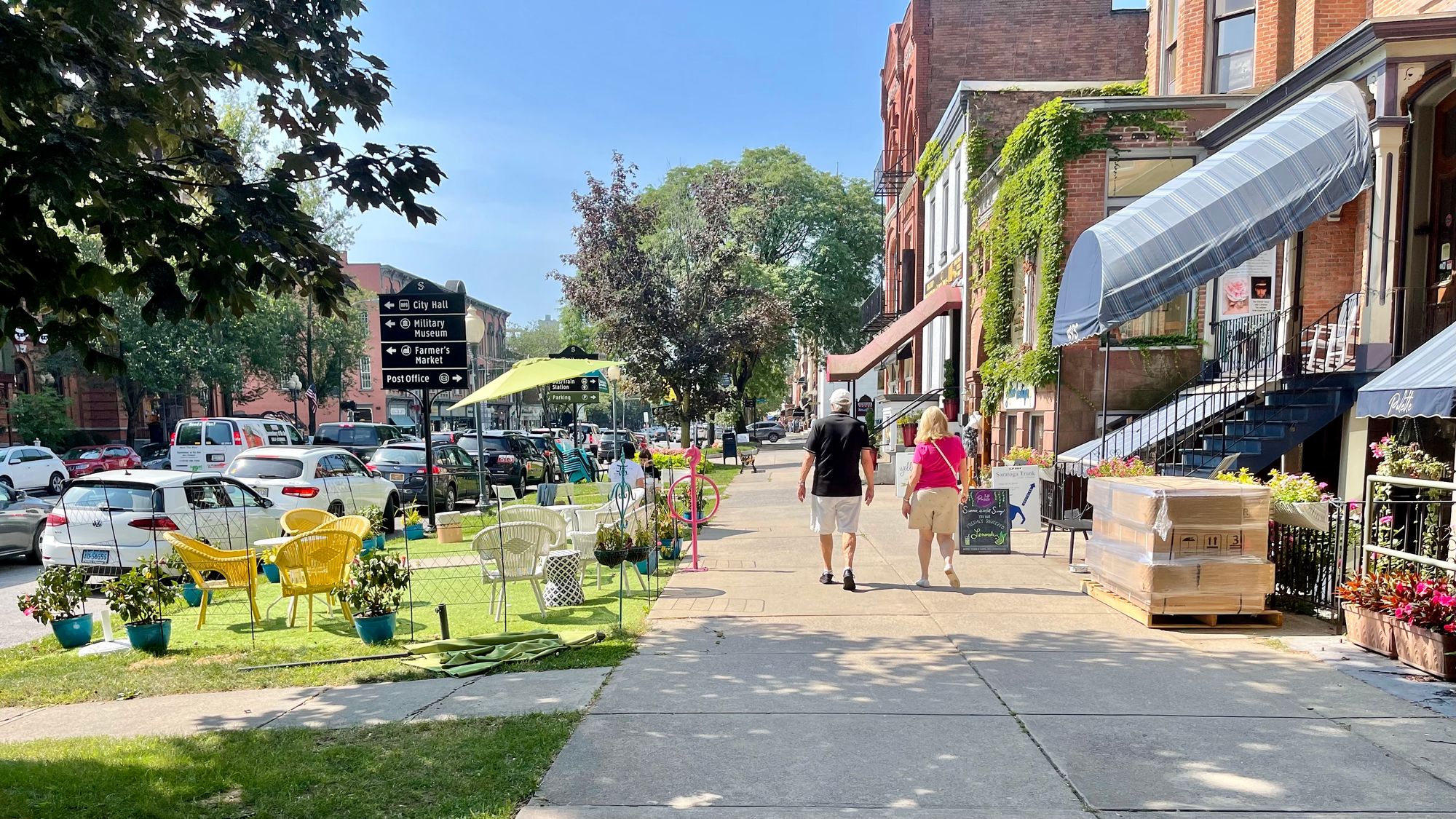
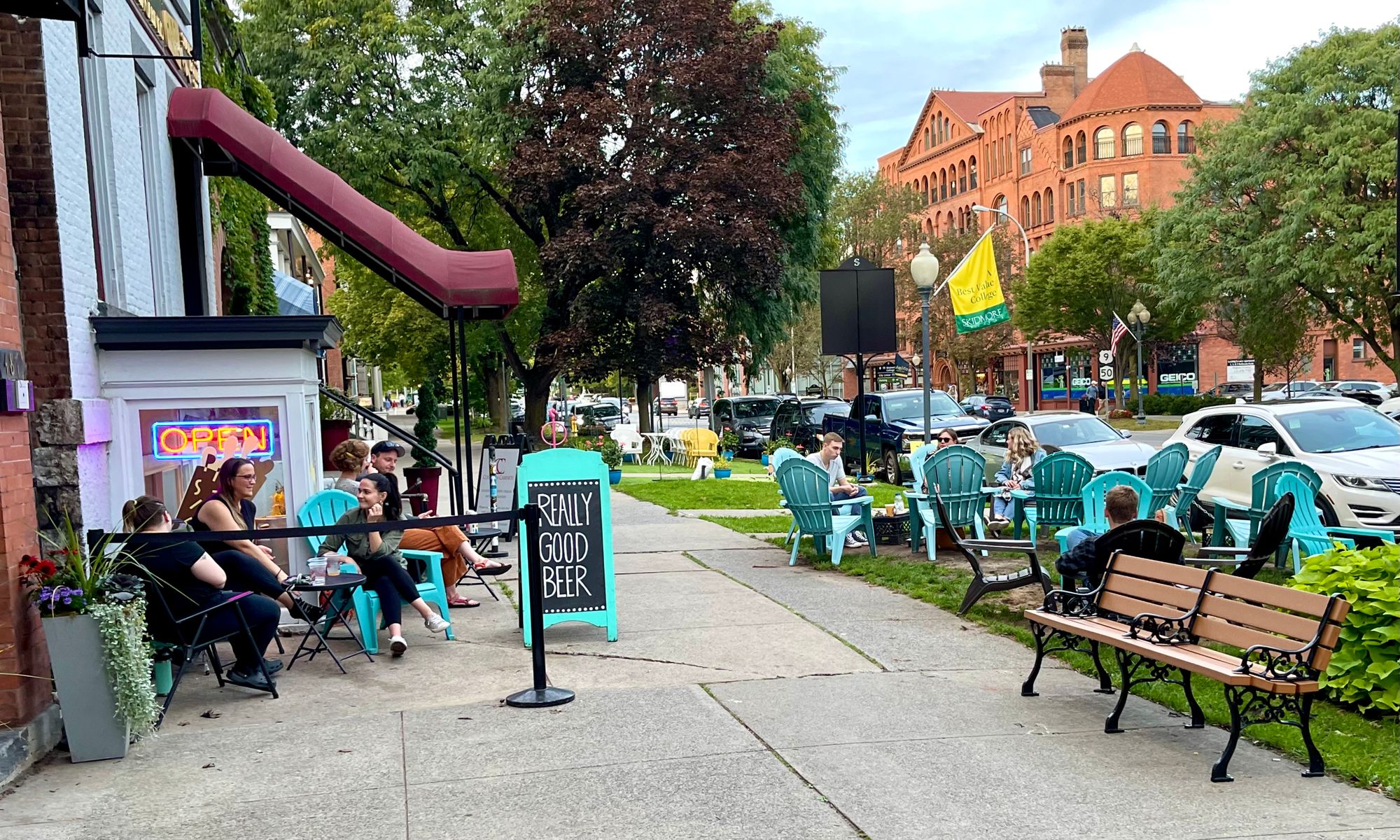
Worth noting in these examples is how people don't seem to notice the presence of cars at all, even though there are often multi-lane streets on the other side of the sidewalks. Double loading makes a wide street feel like a cozy, safe, narrow walkway where the pedestrian is king. While we should work on developing more pedestrian-only areas, promenades, and narrow streets, in the meantime we can retrofit our existing wide streets by double loading them.
To revisit our example from NYC, this double loading was made possible by the addition of dining sheds, which were legalized during Covid to ease the pressure on restaurants and cafes which could no longer serve indoors. Now, the City is taking these beloved dining sheds down for half the year and making it hard for them to exist for the other half...Why? This is a terrible plan that will kill the vibrancy that dining sheds and double loading have introduced into our city. We need to fight against this loss.

We should support the implementation of double loading because it leads to outcomes that everyone can get behind – more comfort, safety, business activity, vibrancy, and increased foot traffic – and it is a simple and affordable solution at that. A win-win for all.
Related Articles
